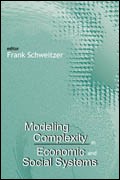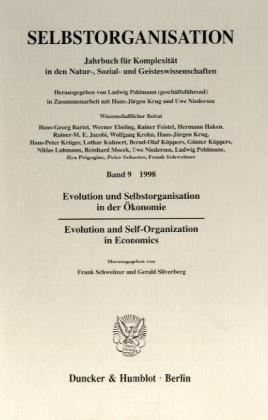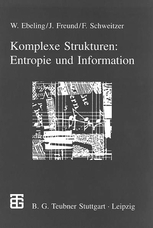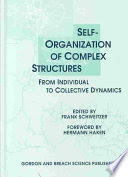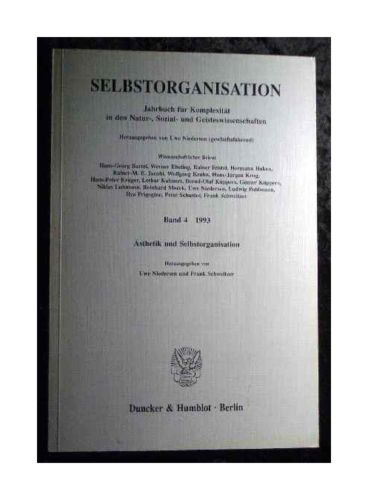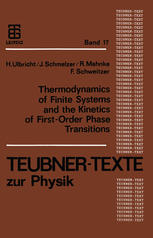Publications»
«Publications
Publications in

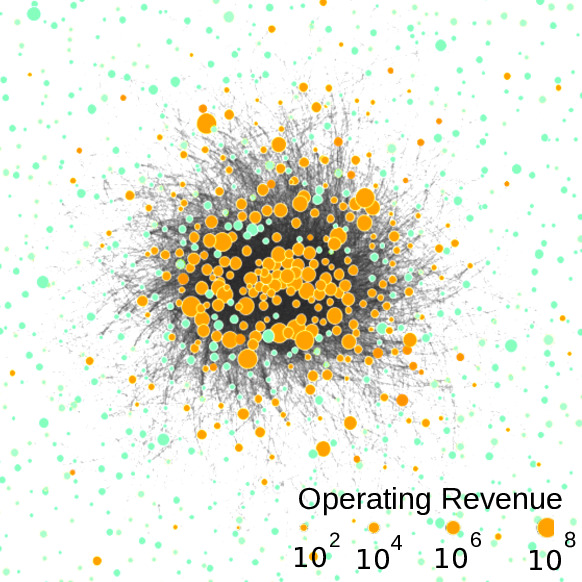
Quantifying the importance of firms by means of reputation and network control
|
[2021]
|
|
Zhang, Yan;
Schweitzer, Frank
|
Frontiers in Big Data,
pages: (submitted),
volume: XXX
|
more» «less
|
Abstract
The reputation of firms is largely channeled through their ownership structure. We use this relation to determine reputation spillovers between transnational companies and their participated companies in an ownership network core of 1318 firms. We then apply concepts of network controllability to identify minimum sets of driver nodes (MDS) of 314 firms in this network. The importance of these driver nodes is classified regarding their control contribution, their operating revenue, and their reputation. The latter two are also taken as proxies for the access costs when utilizing firms as driver nodes. Using an enrichment analysis, we find that firms with high reputation maintain the controllability of the network, but rarely become top drivers, whereas firms with medium reputation most likely become top driver nodes. We further show that MDSs with lower access costs can be used to control the reputation dynamics in the whole network.


Should the government reward cooperation? Insights from an agent-based model of wealth redistribution
|
[2021]
|
|
Schweitzer, Frank;
Verginer, Luca;
Vaccario, Giacomo
|
Advances in Complex Systems,
pages: (submitted),
volume: XXX
|
more» «less
|
Abstract
In our multi-agent model agents generate wealth from repeated interactions for which a prisoner's dilemma payoff matrix is assumed. Their gains are taxed by a government at a rate α. The resulting budget is spent to cover administrative costs and to pay a bonus to cooperative agents, which can be identified correctly only with a probability p. Agents decide at each time step to choose either cooperation or defection based on different information. In the local scenario, they compare their potential gains from both strategies. In the global scenario, they compare the gains of the cooperative and defective subpopulations. We derive analytical expressions for the critical bonus needed to make cooperation as attractive as defection. We show that for the local scenario the government can establish only a medium level of cooperation, because the critical bonus increases with the level of cooperation. In the global scenario instead full cooperation can be achieved once the cold-start problem is solved, because the critical bonus decreases with the level of cooperation. This allows to lower the tax rate, while maintaining high cooperation.

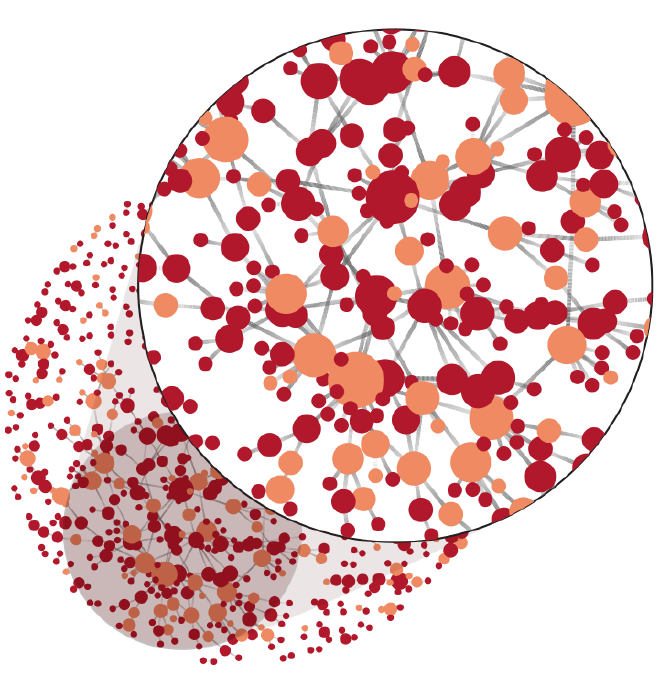
Fragile, yet resilient: Adaptive decline in a collaboration network of firms
|
[2021]
|
|
Schweitzer, Frank;
Casiraghi, Giona;
Tomasello, Mario Vincenzo;
Garcia, David
|
Frontiers in Applied Mathematics,
pages: 634006,
volume: 7
|
more» «less
|
Abstract
The dynamics of collaboration networks of firms follow a life-cycle of growth and decline. That does not imply they also become less resilient. Instead, declining collaboration networks may still have the ability to mitigate shocks from firms leaving, and to recover from these losses by adapting to new partners. To demonstrate this, we analyze 21.500 R&D collaborations of 14.500 firms in six different industrial sectors over 25 years. We calculate time-dependent probabilities of firms leaving the network and simulate drop-out cascades, to determine the expected dynamics of decline. We then show that deviations from these expectations result from the adaptivity of the network, which mitigates the decline. These deviations can be used as a measure of network resilience.

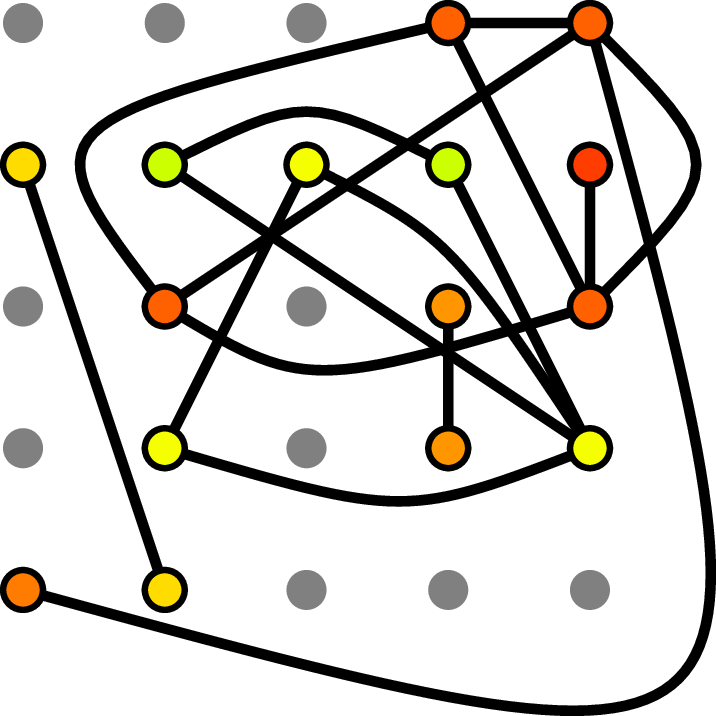
Social percolation revisited: From 2d lattices to adaptive network
|
[2021]
|
|
Schweitzer, Frank
|
Physica A,
pages: 125687,
volume: 570
|
more» «less
|
Abstract
The social percolation model (Solomon et al., 2000} considers a 2-dimensional regular lattice. Each site is occupied by an agent with a preference $x_{i}$ sampled from a uniform distribution $U[0,1]$. Agents transfer the information about the quality $q$ of a movie to their neighbors only if $x_{i}\leq q$. Information percolates through the lattice if $q=q_{c}=0.593$. -- From a network perspective the percolating cluster can be seen as a random-regular network with $n_{c}$ nodes and a mean degree that depends on $q_{c}$. Preserving these quantities of the random-regular network, a true random network can be generated from the $G(n,p)$ model after determining the link probability $p$. I then demonstrate how this random network can be transformed into a threshold network, where agents create links dependent on their $x_{i}$ values. Assuming a dynamics of the $x_{i}$ and a mechanism of group formation, I further extend the model toward an adaptive social network model.


Quantifying individual influence in leading-following behavior of Bechstein's bats
|
[2021]
|
|
Mavrodiev, Pavlin;
Fleischmann, Daniela;
Kerth, Gerald;
Schweitzer, Frank
|
Scientific Reports,
volume: 11
|
more» «less
|
Abstract
Leading-following behavior as a way of transferring information about the location of resources is widespread in different animal societies. However, it cannot always be observed directly. Here, we develop a general method to infer leading-following events from observational data if only the discrete appearance of individuals is recorded. Our method further allows to distinguish such events from local enhancement at the resource, such as swarming behavior in case of bats, which is another widespread way of transferring information among animals. To test our methodology, we analyze longitudinal data about the roosting behavior of Bechstein's bats from two different colonies and different years. The detection of leading-following events allows us, in a second step, to construct social networks in which nodes represent individual bats and directed and weighted links the leading-following events. We analyze the topology of these networks on the level of the colony, to see whether all individuals participate in leading-following behavior. Further, based on the leading-following network we measure the importance of individuals in this leading-following behavior by calculating different centrality measures. We find that individuals can be consistently ranked regarding their influence on others. Moreover, we identify a small set of individuals that play a central role in leading other bats to roosts. Our methodology can be used to understand the leading-following behavior and the individual impact of group members on the spread of information in animal groups in general.

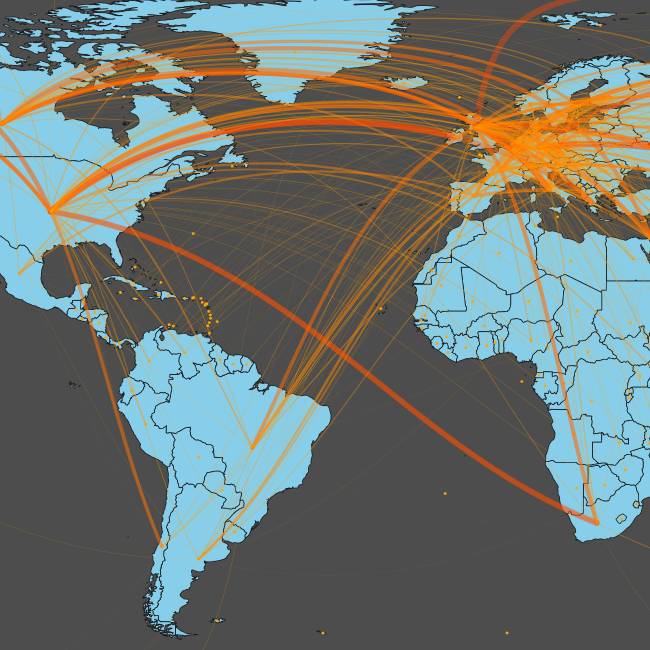
Reproducing scientists' mobility: A data-driven model
|
[2020]
|
|
Vaccario, Giacomo;
Luca, Verginer;
Schweitzer, Frank
|
arXiv:1811.07229
|
more» «less
|
Abstract
High skill labour is an important factor underpinning the competitive advantage of modern economies. Therefore, attracting and retaining scientists has become a major concern for migration policy. In this work, we study the migration of scientists on a global scale, by combining two large data sets covering the publications of 3.5 Mio scientists over 60 years. We analyse their geographical distances moved for a new affiliation and their age when moving, this way reconstructing their geographical ``career paths''. These paths are used to derive the world network of scientists mobility between cities and to analyse its topological properties. We further develop and calibrate an agent-based model, such that it reproduces the empirical findings both at the level of scientists and of the global network. Our model takes into account that the academic hiring process is largely demand-driven and demonstrates that
the probability of scientists to relocate decreases both with age and with distance. Our results allow interpreting the model assumptions as micro-based decision rules that can explain the observed mobility patterns of scientists.


Enhanced or distorted wisdom of crowds? An agent-based model of opinion formation under social influence
|
[2020]
|
|
Mavrodiev, Pavlin;
Schweitzer, Frank
|
Swarm Intelligence,
pages: (submitted),
volume: xx
|
more» «less
|
Abstract
We propose an agent-based model of collective opinion formation to study the wisdom of crowds under social influence. The opinion of an agent is a continuous positive value, denoting its subjective answer to a factual question. The wisdom of crowds states that the average of all opinions is close to the truth, i.e. the correct answer. But if agents have the chance to adjust their opinion in response to the opinions of others, this effect can be destroyed. Our model investigates this scenario by evaluating two competing effects: (i) agents tend to keep their own opinion (individual conviction β), (ii) they tend to adjust their opinion if they have information about the opinions of others (social influence α). For the latter, two different regimes (full information vs. aggregated information) are compared. Our simulations show that social influence only in rare cases enhances the wisdom of crowds. Most often, we find that agents converge to a collective opinion that is even farther away from the true answer. So, under social influence the wisdom of crowds can be systematically wrong.

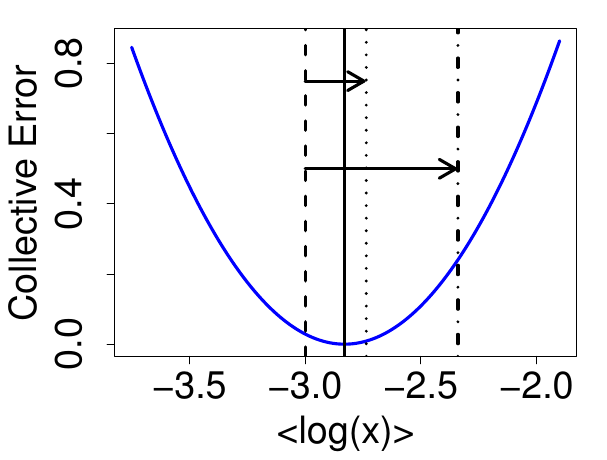
The ambiguous role of social influence on the wisdom of crowds: An analytic approach
|
[2020]
|
|
Mavrodiev, Pavlin;
Schweitzer, Frank
|
Physica A: Statistical Mechanics and its Applications,
pages: 125624
|
more» «less
|
Abstract
"Wisdom of crowds" refers to the phenomenon that the average opinion of a group of individuals on a given question can be very close to the true answer. It requires a large group diversity of opinions, but the collective error, the difference between the average opinion and the true value, has to be small. We consider a stochastic opinion dynamics where individuals can change their opinion based on the opinions of others (social influence α), but to some degree also stick to their initial opinion (individual conviction β). We then derive analytic expressions for the dynamics of the collective error and the group diversity. We analyze their long-term behavior to determine the impact of the two parameters (α,β) and the initial opinion distribution on the wisdom of crowds. This allows us to quantify the ambiguous role of social influence: only if the initial collective error is large, it helps to improve the wisdom of crowds, but in most cases it deteriorates the outcome. In these cases, individual conviction still improves the wisdom of crowds because it mitigates the impact of social influence.

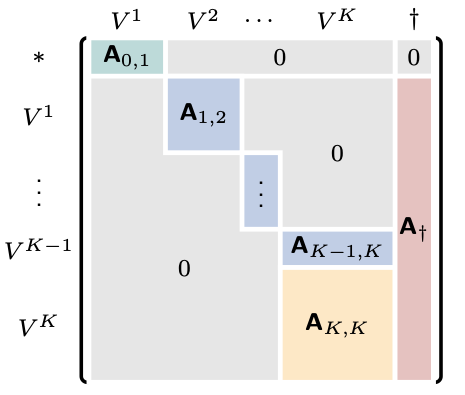
Predicting Sequences of Traversed Nodes in Graphs using Network Models with Multiple Higher Orders
|
[2020]
|
|
Gote, Christoph;
Casiraghi, Giona;
Schweitzer, Frank;
Scholtes, Ingo
|
arXiv preprint arXiv:2007.06662
|
more» «less
|
Abstract
We propose a novel sequence prediction method for sequential data capturing node traversals in graphs. Our method builds on a statistical modelling framework that combines multiple higher-order network models into a single multi-order model. We develop a technique to fit such multi-order models in empirical sequential data and to select the optimal maximum order. Our framework facilitates both next-element and full sequence prediction given a sequence-prefix of any length. We evaluate our model based on six empirical data sets containing sequences from website navigation as well as public transport systems. The results show that our method out-performs state-of-the-art algorithms for next-element prediction. We further demonstrate the accuracy of our method during out-of-sample sequence prediction and validate that our method can scale to data sets with millions of sequences.

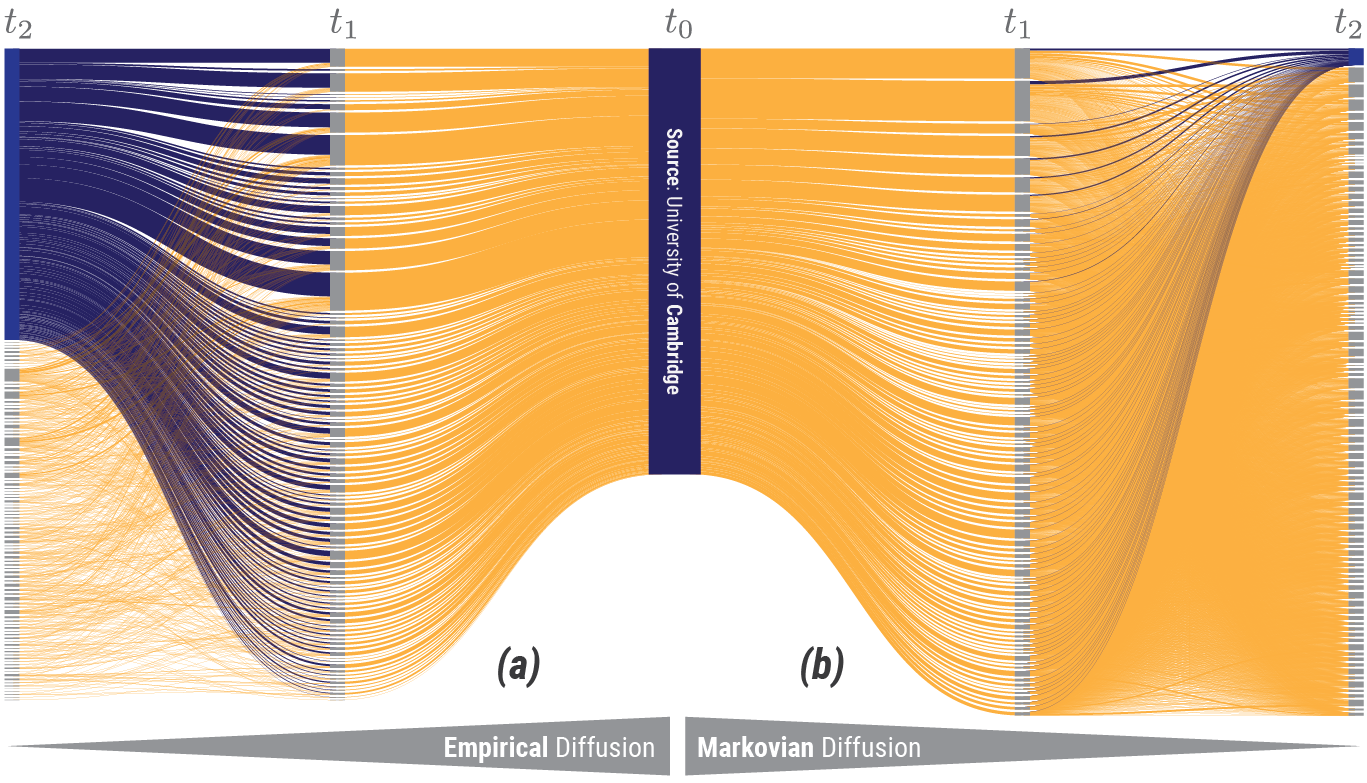
The mobility network of scientists: Analyzing temporal correlations in scientific careers
|
[2020]
|
|
Vaccario, Giacomo;
Verginer, Luca;
Schweitzer, Frank
|
Applied Network Science,
pages: 36,
volume: 5,
number: 1
|
more» «less
|
Abstract
The mobility of scientists between different universities and countries is important to foster knowledge exchange. At the same time, the potential mobility is restricted by geographic and institutional constraints, which leads to temporal correlations in the career trajectories of scientists. To quantify this effect, we extract 3.5 million career trajectories of scientists from two large scale bibliographic data sets and analyze them applying a novel method of higher-order networks. We study the effect of temporal correlations at three different levels of aggregation, universities, cities and countries. We find strong evidence for such correlations for the top 100 universities, i.e. scientists move likely between specific institutions. These correlations also exist at the level of countries, but cannot be found for cities. Our results allow to draw conclusions about the institutional path dependence of scientific careers and the efficiency of mobility programs.

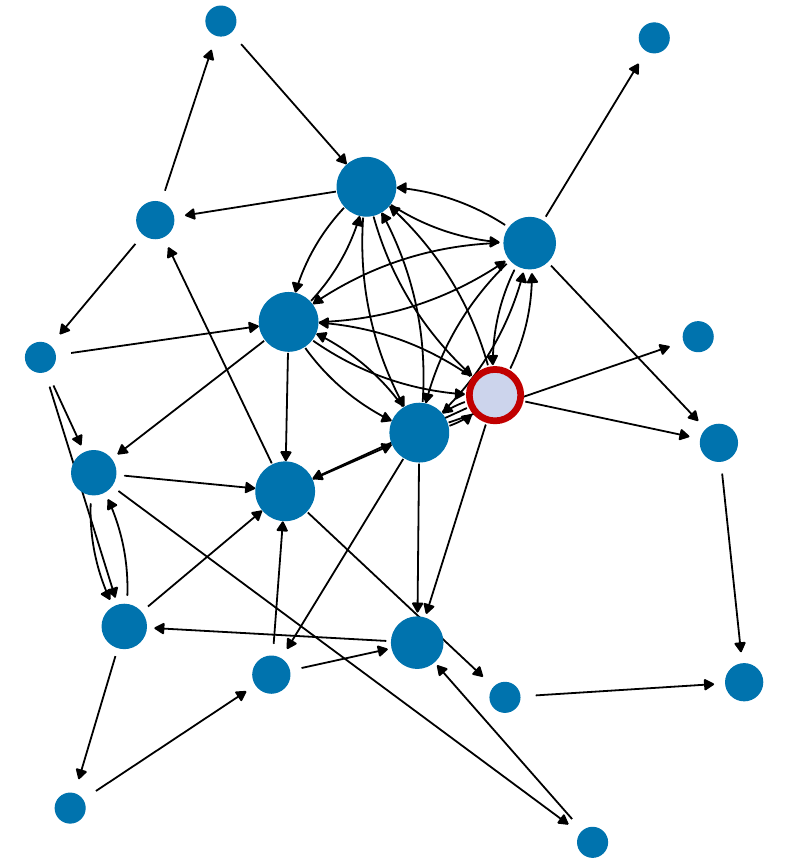
Intervention scenarios to enhance knowledge transfer in a network of firms
|
[2020]
|
|
Casiraghi, Giona;
Schweitzer, Frank;
Zhang, Yan
|
Frontiers in Physics,
pages: 382,
volume: 8
|
more» «less
|
Abstract
We investigate a multi-agent model of firms in a Research & Development (R&D) network. Each firm is characterized by its knowledge stock xi(t), which follows a non-linear dynamics. xi(t) grows with the input from other firms, i.e., by knowledge transfer, and decays otherwise. However, maintaining the interactions that increase knowledge stock is costly for all partners involved. Because of this, firms leave the network whenever their expected knowledge growth is not realized. This, in turn, may cause other firms also to leave the network. The paper discusses two bottom-up intervention scenarios to prevent, reduce, or delay such cascades of firms leaving. The first one is based on the formalism of network controllability, in which driver nodes are identified and subsequently incentivized, by reducing their costs. The second one combines node interventions and network interventions. It proposes the controlled removal of a single firm and the random replacement of firms leaving. This allows to generate small cascades, which prevents the occurrence of large cascades. We find that both approaches successfully mitigate cascades and thus improve the resilience of the R&D network.


An agent-based model of multi-dimensional opinion dynamics and opinion alignment
|
[2020]
|
|
Schweighofer, Simon;
Garcia, David;
Schweitzer, Frank
|
Chaos,
volume: 30,
number: 9
|
more» «less
|
Abstract
It is known that individual opinions on different policy issues often align to a dominant ideological dimension (e.g. ``left'' vs. ``right'') and become increasingly polarized. We provide an agent-based model that reproduces these two stylized facts as emergent properties of an opinion dynamics in a multi-dimensional space of continuous opinions. The mechanisms for the change of agents' opinions in this multi-dimensional space are derived from cognitive dissonance theory and structural balance theory. We test assumptions from proximity voting and from directional voting regarding their ability to reproduce the expected emerging properties. We further study how the emotional involvement of agents, i.e. their individual resistance to change opinions, impacts the dynamics. We identify two regimes for the global and the individual alignment of opinions. If the affective involvement is high and shows a large variance across agents, this fosters the emergence of a dominant ideological dimension. Agents align their opinions along this dimension in opposite directions, i.e. create a state of polarization.

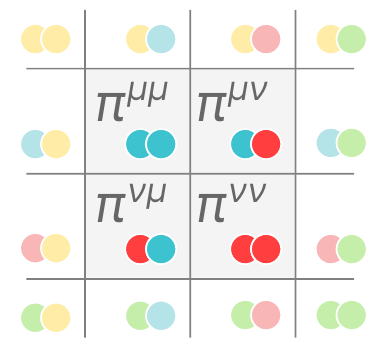
Multi-layer network approach to modelling authorship influence on citation dynamics in physics journals
|
[2020]
|
|
Schweitzer, Frank;
Nanumyan, Vahan;
Gote, Christoph
|
Physical Review E,
pages: 032303,
volume: 102,
number: 3
|
more» «less
|
Abstract
We provide a general framework to model the growth of networks consisting of different coupled layers. Our aim is to estimate the impact of one such layer on the dynamics of the others. As an application, we study a scientometric network, where one layer consists of publications as nodes and citations as links, whereas the second layer represents the authors. This allows to address the question how characteristics of authors, such as their number of publications or number of previous co-authors, impacts the citation dynamics of a new publication. To test different hypotheses about this impact, our model combines citation constituents and social constituents in different ways. We then evaluate their performance in reproducing the citation dynamics in nine different physics journals. For this, we develop a general method for statistical parameter estimation and model selection that is applicable to growing multi-layer networks. It takes both the parameter errors and the model complexity into account and is computationally efficient and scalable to large networks.
HYPA: Efficient Detection of Path Anomalies in Time Series Data on Networks
|
[2020]
|
|
LaRock, Timothy;
Nanumyan, Vahan;
Scholtes, Ingo;
Casiraghi, Giona;
Eliassi - Rad, Tina;
Schweitzer, Frank
|
SIAM International Conference on Data Mining,
pages: 460-468
|
more» «less
|
Abstract
The unsupervised detection of anomalies in time series data has important applications in user behavioral modeling, fraud detection, and cybersecurity. Anomaly detection has, in fact, been extensively studied in categorical sequences. However, we often have access to time series data that represent paths through networks. Examples include transaction sequences in financial networks, click streams of users in networks of cross-referenced documents, or travel itineraries in transportation networks. To reliably detect anomalies, we must account for the fact that such data contain a large number of independent observations of paths constrained by a graph topology. Moreover, the heterogeneity of real systems rules out frequency-based anomaly detection techniques, which do not account for highly skewed edge and degree statistics. To address this problem, we introduce HYPA, a novel framework for the unsupervised detection of anomalies in large corpora of variable-length temporal paths in a graph. HYPA provides an efficient analytical method to detect paths with anomalous frequencies that result from nodes being traversed in unexpected chronological order.

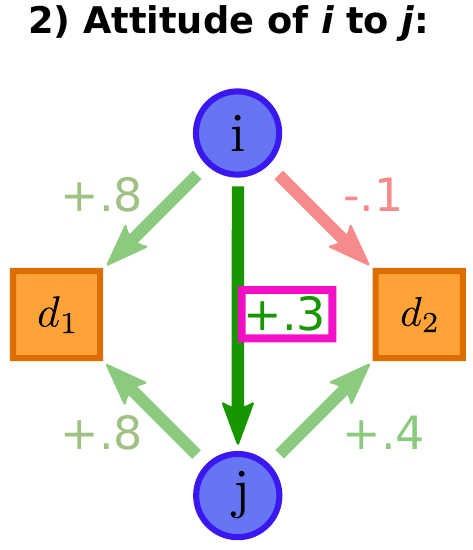
A Weighted Balance Model of Opinion Hyperpolarization
|
[2020]
|
|
Schweighofer, Simon;
Schweitzer, Frank;
Garcia, David
|
Journal of Artificial Societies and Social Simulation,
volume: 23,
number: 3
|
more» «less
|
Abstract
Polarization is threatening the stability of democratic societies. Until now, polarization research has focused on opinion extremeness, overlooking the correlation between different policy issues. We explain the emergence of hyperpolarization, i.e. the combination of extremeness and correlation between issues, by developing Weighted Balance Theory (WBT), a new theory of opinion formation. WBT extends Heider’s cognitive balance theory to encompass multiple weighted attitudes. We validate WBT on empirical data from the 2016 National Election Survey. Furthermore, we develop an opinion dynamics model based on WBT, which, for the first time, is able to generate hyperpolarization and to explain the link between affective and opinion polarization. In addition, our theory encompasses other phenomena of opinion dynamics, including mono-polarization and backfire effects.

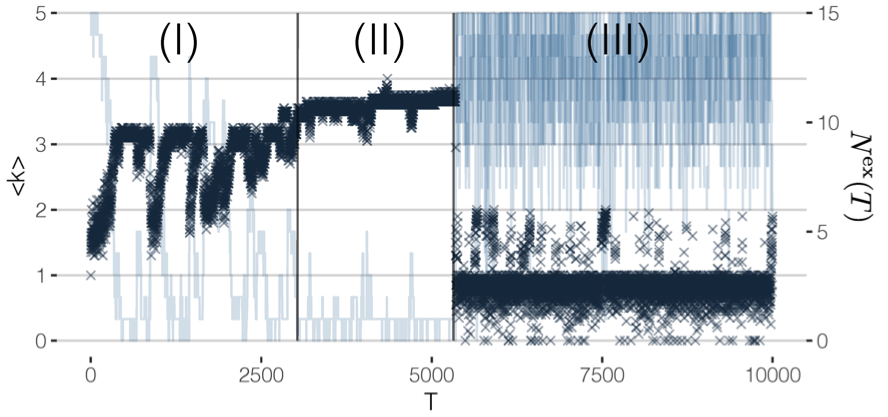
Improving the robustness of online social networks: A simulation approach of network interventions
|
[2020]
|
|
Casiraghi, Giona;
Schweitzer, Frank
|
Frontiers in Robotics and AI,
pages: 57,
volume: 7
|
more» «less
|
Abstract
Online social networks (OSN) are prime examples of socio-technical systems in which individuals interact via a technical platform. OSN are very volatile because users enter and exit and frequently change their interactions. This makes the robustness of such systems difficult to measure and to control. To quantify robustness, we propose a coreness value obtained from the directed interaction network. We study the emergence of large drop-out cascades of users leaving the OSN by means of an agent-based model. For agents, we define a utility function that depends on their relative reputation and their costs for interactions. The decision of agents to leave the OSN depends on this utility. Our aim is to prevent drop-out cascades by influencing specific agents with low utility. We identify strategies to control agents in the core and the periphery of the OSN such that drop-out cascades are significantly reduced, and the robustness of the OSN is increased.

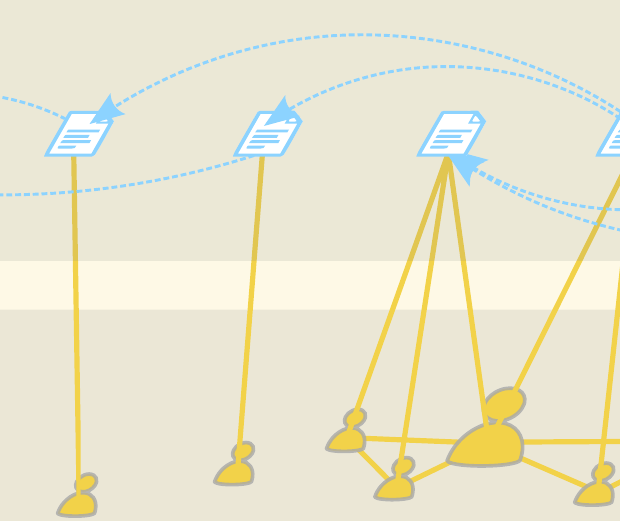
Citations Driven by Social Connections? A Multi-Layer Representation of Coauthorship Networks
|
[2020]
|
|
Nanumyan, Vahan;
Zingg, Christian;
Schweitzer, Frank
|
Quantitative Science Studies,
pages: 1493-1509,
volume: 1,
number: 4
|
more» «less
|
Abstract
To what extent is the citation rate of new papers influenced by the past social relations of their authors? To answer this question, we present a data-driven analysis of nine different physics journals. Our analysis is based on a two-layer network representation constructed from two large-scale data sets, INSPIREHEP and APS. The social layer contains authors as nodes and coauthorship relations as links. This allows us to quantify the social relations of each author, prior to the publication of a new paper. The publication layer contains papers as nodes and citations between papers as links. This layer allows us to quantify scientific attention as measured by the change of the citation rate over time. We particularly study how this change correlates with the social relations of their authors, prior to publication. We find that on average the maximum value of the citation rate is reached sooner for authors who have either published more papers or who have had more coauthors in previous papers. We also find that for these authors the decay in the citation rate is faster, meaning that their papers are forgotten sooner.

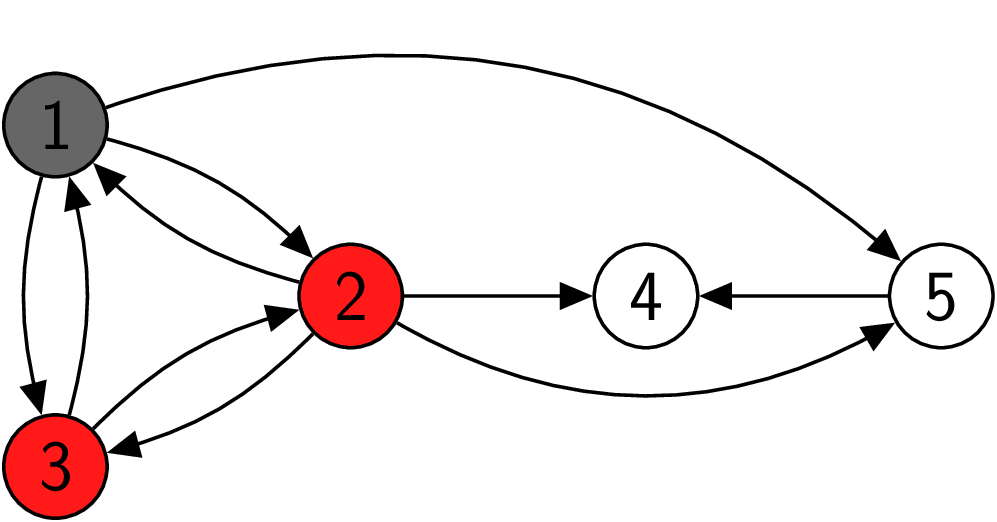
Modeling User Reputation in Online Social Networks: The Role of Costs, Benefits, and Reciprocity
|
[2020]
|
|
Schweitzer, Frank;
Mavrodiev, Pavlin;
Seufert, A. M.;
Garcia, David
|
Entropy,
pages: 1073,
volume: 22,
number: 10
|
more» «less
|
Abstract
We analyze an agent-based model to estimate how the costs and benefits of users in an online social network (OSN) impact the robustness of the OSN. Benefits are measured in terms of relative reputation that users receives from their followers. They can be increased by direct and indirect reciprocity in following each other, which leads to a core-periphery structure of the OSN. Costs relate to the effort to login, to maintain the profile, etc. and are assumed as constant for all users. The robustness of the OSN depends on the entry and exit of users over time. Intuitively, one would expect that higher costs lead to more users leaving and hence to a less robust OSN. We demonstrate that an optimal cost level exists, which maximizes both the performance of the OSN, measured by means of the long-term average benefit of its users, and the robustness of the OSN, measured by means of the life-time of the core of the OSN. Our mathematical and computational analyses unfold how changes in the cost level impact reciprocity and subsequently the core-periphery structure of the OSN, to explain the optimal cost level.

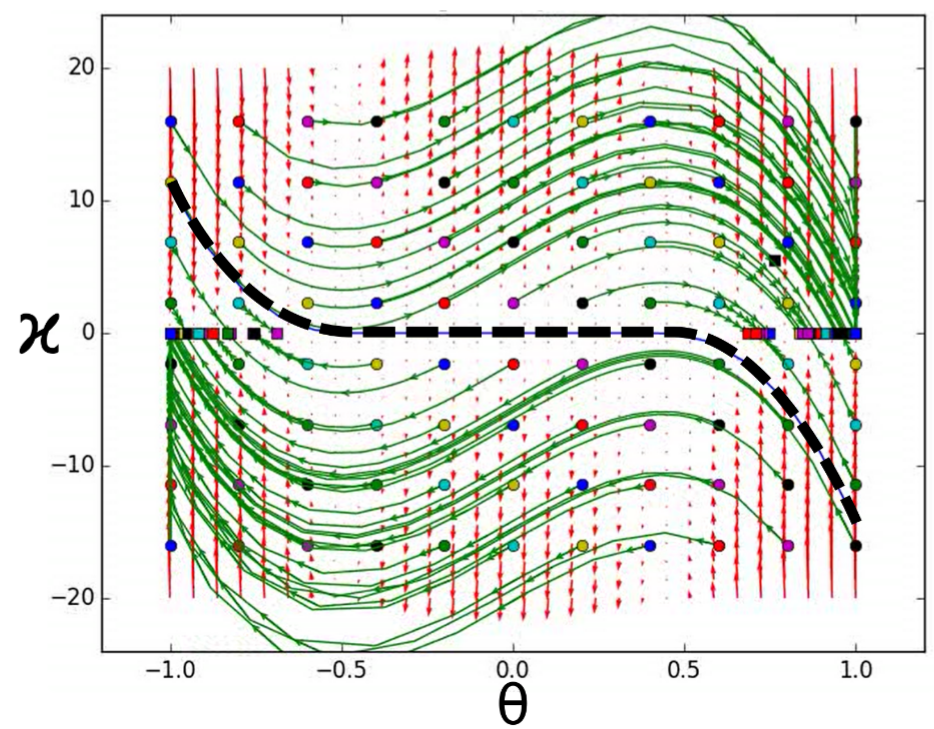
An Agent-Based Model of Opinion Polarization Driven by Emotions
|
[2020]
|
|
Schweitzer, Frank;
Krivachy, Tamas;
Garcia, David
|
Complexity,
volume: 2020
|
more» «less
|
Abstract
We provide an agent-based model to explain the emergence of collective opinions not based on feedback between different opinions, but based on emotional interactions between agents. The driving variable is the emotional state of agents, characterized by their valence, quantifying the emotion from unpleasant to pleasant, and their arousal, quantifying the degree of activity associated with the emotion. Both determine their emotional expression, from which collective emotional information is generated. This information feeds back on the dynamics of emotional states and individual opinions in a nonlinear manner. We derive the critical conditions for emotional interactions to obtain either consensus or polarization of opinions. Stochastic agent-based simulations and formal analyses of the model explain our results. Possible ways to validate the model are discussed.

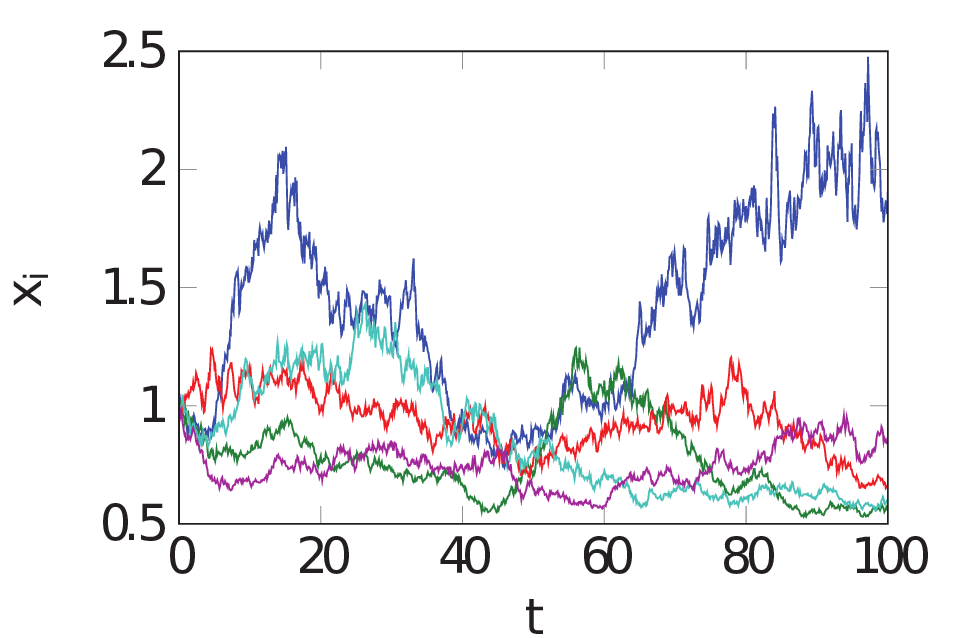
The law of proportionate growth and its siblings: Applications in agent-based modeling of socio-economic systems
|
[2020]
|
|
Schweitzer, Frank
|
Complexity, Heterogeneity, and the Methods of Statistical Physics in Economics
|
more» «less
|
Abstract
The law of proportionate growth simply states that the time dependent change of a quantity $x$ is proportional to $x$. Its applicability to a wide range of dynamic phenomena is based on various assumptions for the proportionality factor, which can be random or deterministic, constant or time dependent. Further, the dynamics can be combined with additional additive growth terms, which can be constants, aggregated quantities, or interaction terms. This allows to extent the core dynamics into an agent-based modeling framework with vast applications in social and economic systems. The paper adopts this overarching perspective to discuss phenomena as diverse as saturated growth, competition, stochastic growth, investments in random environments, wealth redistribution, opinion dynamics and the wisdom of crowds, reputation dynamics, knowledge growth, and the combination with network dynamics.
Analysing Time-Stamped Co-Editing Networks in Software Development Teams using git2net
|
[2019]
|
|
Gote, Christoph;
Scholtes, Ingo;
Schweitzer, Frank
|
arXiv:1911.09484
|
more» «less
|
Abstract
Data from software repositories have become an important foundation for the empirical study of software engineering processes. A recurring theme in the repository mining literature is the inference of developer networks capturing e.g. collaboration, coordination, or communication from the commit history of projects. Most of the studied networks are based on the co-authorship of software artefacts. Because this neglects detailed information on code changes and code ownership we introduce git2net, a scalable python software that facilitates the extraction of fine-grained co-editing networks in large git repositories. It uses text mining techniques to analyse the detailed history of textual modifications within files. We apply our tool in two case studies using GitHub repositories of multiple Open Source as well as a commercial software project. Specifically, we use data on more than 1.2 million commits and more than 25'000 developers to test a hypothesis on the relation between developer productivity and co-editing patterns in software teams. We argue that git2net opens up a massive new source of high-resolution data on human collaboration patterns that can be used to advance theory in empirical software engineering, computational social science, and organisational studies.

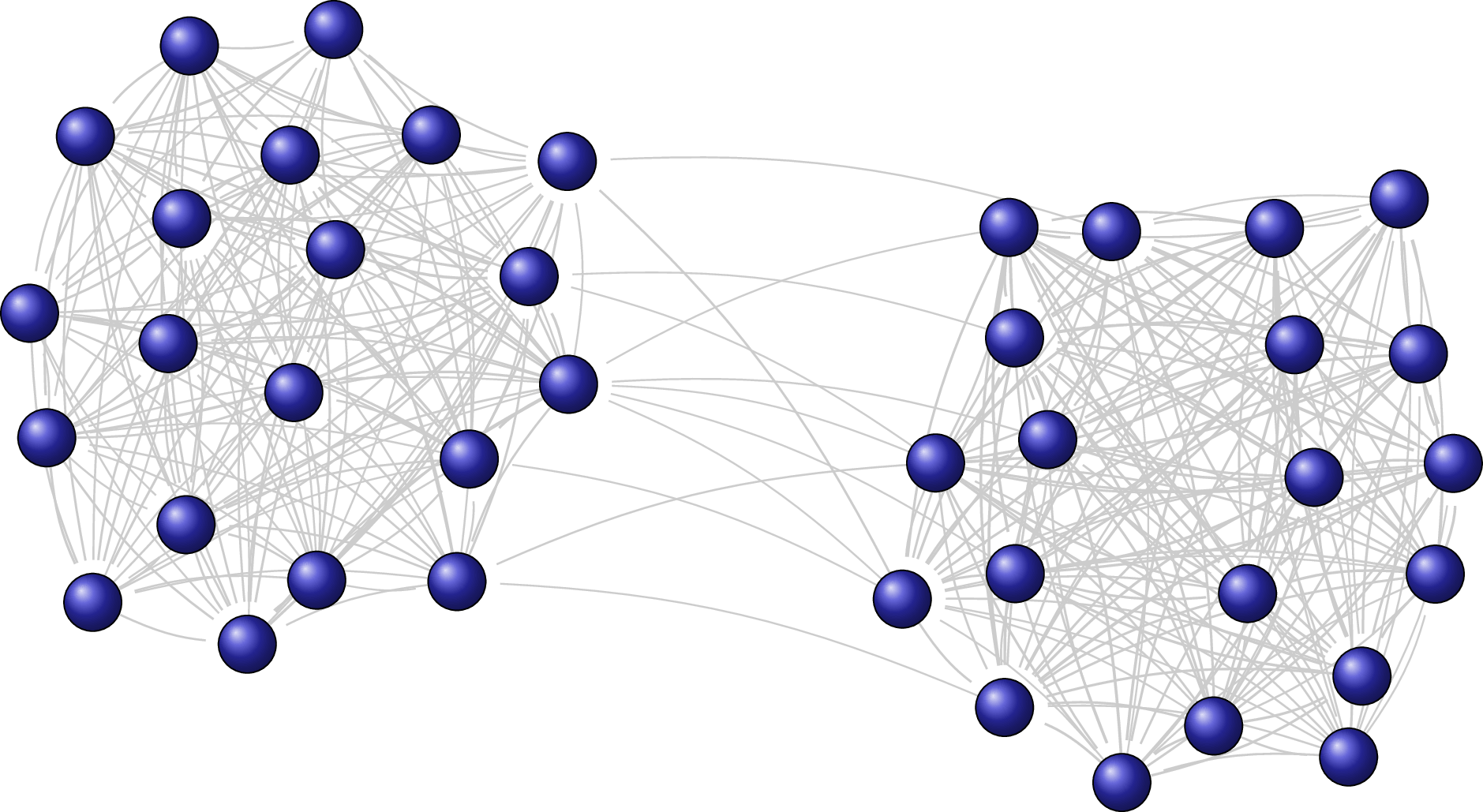
Data-driven modeling of group formation in the fission-fusion dynamics of Bechstein's bats
|
[2019]
|
|
Perony, Nicolas;
Kerth, Gerald;
Schweitzer, Frank
|
Journal of the Royal Society Interface,
pages: (submitted)
|
more» «less
|
Abstract
Communal roosting in Bechstein's bat colonies is characterized by the formation of several groups that use different day roosts and that regularly dissolve and re-merge (fission-fusion dynamics). Analyzing data from two colonies of different size over many years, we find that (i) the number of days bats stay in the same roost before changing follows an exponential distribution that is independent of the colony size, and (ii) the number and size of groups bats formed for roosting depend on the size of the colony such that above a critical colony size two to six groups of different sizes are formed. To model these two observations, we propose an agent-based model in which agents make their decisions about roosts based on both random and social influences. For the latter, they copy the roost preference of another agent which models the transfer of the respective information. Our model is able to reproduce both the distribution of stay length in the same roost and the emergence of groups of different sizes dependent on the colony size. Moreover, we are able to predict the critical system size at which the formation of different groups emerges without global coordination. We further comment on dynamics that bridge the roosting decisions on short time scale (less than one day) with the social structures observed at long time scales (more than one year).

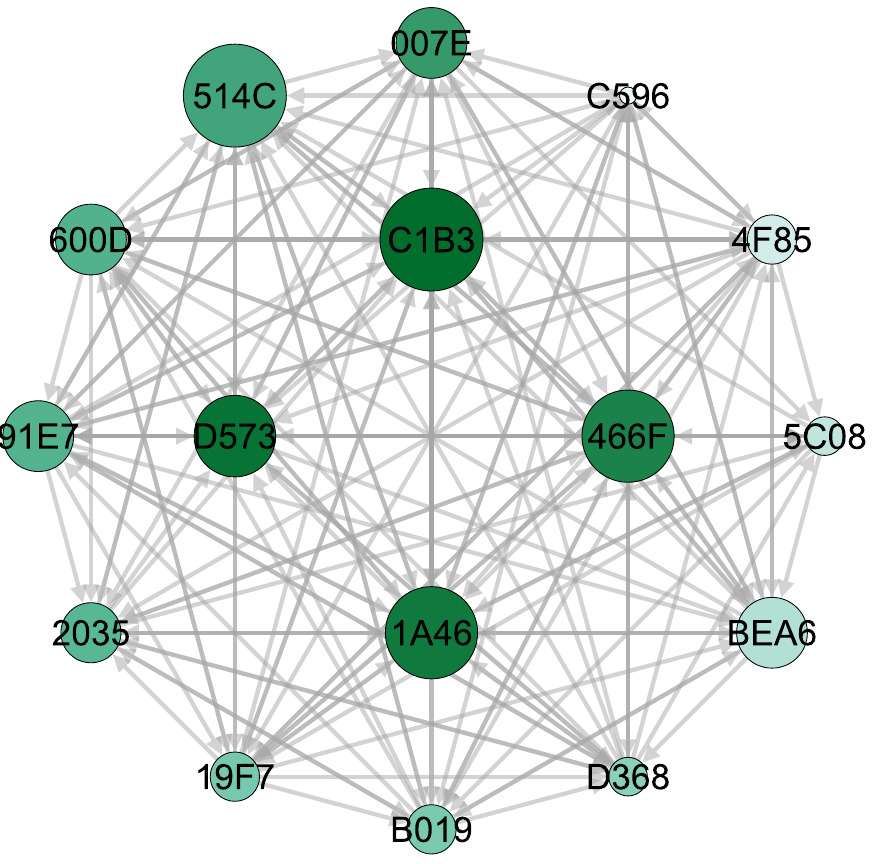
Data-driven modeling of leading-following behavior in Bechstein's bats
|
[2019]
|
|
Mavrodiev, Pavlin;
Fleischmann, Daniela;
Kerth, Gerald;
Schweitzer, Frank
|
PLOS Computational Biology,
pages: (submitted)
|
more» «less
|
Abstract
Leading-following behaviour in Bechstein's bats transfers information about suitable roost sites from experienced to inexperienced individuals, and thus ensures communal roosting. We analyze 9 empirical data sets about individualized leading-following (L/F) events, to infer rules that likely determine the formation of L/F pairs. To test these rules, we propose five models that differ regarding the empirical information taken into account to form L/F pairs: activity of a bat in exploring possible roosts, tendency to lead and to follow. The comparison with empirical data was done by constructing social networks from the observed L/F events, on which centralities were calculated to quantify the importance of individuals in these L/F networks. The centralities from the empirical network are then compared for statistical differences with the model-generated centralities obtained from $10^{5}$ model realizations. We find that two models perform well in comparison with the empirical data: One model assumes an individual tendency to lead, but chooses followers at random. The other model assumes an individual tendency to follow and chooses leaders according to their overall activity. We note that neither individual preferences for specific individuals, nor other influences such as kinship or reciprocity, are taken into account to reproduce the empirical findings.

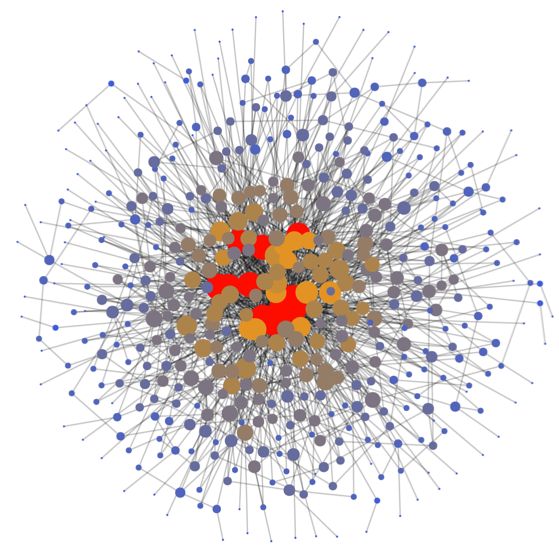
Probing the robustness of nested multi-layer networks
|
[2019]
|
|
Casiraghi, Giona;
Garas, Antonios;
Schweitzer, Frank
|
arXiv:1911.03277
|
more» «less
|
Abstract
We consider a multi-layer network with two layers, $\_1\$, $\_2\$. Their intra-layer topology shows a scale-free degree distribution and a core-periphery structure. A nested structure describes the inter-layer topology, i.e., some nodes from $\_1\$, the generalists, have many links to nodes in $\_2\$, specialists only have a few. This structure is verified by analyzing two empirical networks from ecology and economics. To probe the robustness of the multi-layer network, we remove nodes from $\_1\$ with their inter-and intra-layer links and measure the impact on the size of the largest connected component, $F_2\$, in $\_2\$, which we take as a robustness measure. We test different attack scenarios by preferably removing peripheral or core nodes. We also vary the intra-layer coupling between generalists and specialists, to study their impact on the robustness of the multi-layer network. We find that some combinations of attack scenario and intra-layer coupling lead to very low robustness values, whereas others demonstrate high robustness of the multi-layer network because of the intra-layer links. Our results shed new light on the robustness of bipartite networks, which consider only inter-layer, but no intra-layer links.

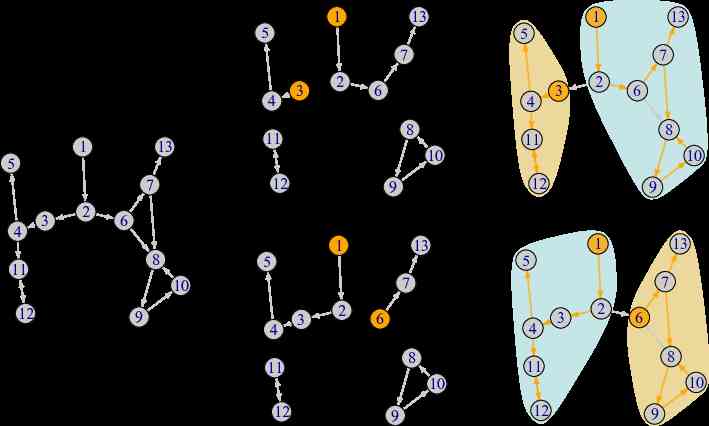
Control contribution identifies top driver nodes in complex networks
|
[2019]
|
|
Zhang, Yan;
Garas, Antonios;
Schweitzer, Frank
|
ACS-Advances in Complex Systems,
pages: 1950014,
volume: 22,
number: 7-8
|
more» «less
|
Abstract
We propose a new measure to quantify the impact of a node $i$ in controlling a directed network. This measure, called ``control contribution'' $_(i)$, combines the probability for node $i$ to appear in a set of driver nodes and the probability for other nodes to be controlled by $i$. To calculate $_(i)$, we propose an optimization method based on random samples of minimum sets of drivers. Using real-world and synthetic networks, we find very broad distributions of $C_(i)$. Ranking nodes according to their $C_(i)$ values allows us to identify the top driver nodes that can control most of the network. We show that this ranking is superior to rankings based on other control-based measures. We find that control contribution indeed contains new information that cannot be traced back to degree, control capacity or control range of a node.

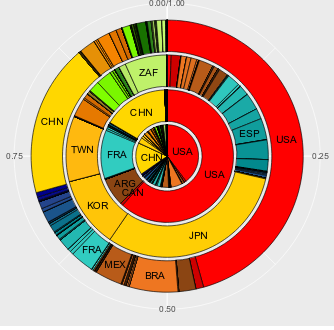
International crop trade networks: The impact of shocks and cascades
|
[2019]
|
|
Burkholz, Rebekka;
Schweitzer, Frank
|
Environmental Research Letters,
pages: 114013,
volume: 14
|
more» «less
|
Abstract
Analyzing available FAO data from 176 countries over 21 years, we observe an increase of complexity in the international trade of maize, rice, soy, and wheat. A larger number of countries play a role as producers or intermediaries, either for trade or food processing. In consequence, we find that the trade networks become more prone to failure cascades caused by exogenous shocks. In our model, countries compensate for demand deficits by imposing export restrictions. To capture these, we construct higher-order trade dependency networks for the different crops and years. These networks reveal hidden dependencies between countries and provide an estimate of necessary stock reserves to protect countries from cascading export restrictions. They differ substantially from first order networks that do not take cascading effects into account. We find rice trade most prone to cascading export restrictions. A great number of Asian and African countries are most exposed to cascades. Noticeably, the main suppliers are similar for most of the crops: USA, Canada, Argentina, Brazil, and India. While shocks in the USA mainly affect South America and several Asian countries, the south of Africa is primarily dependent on American and Asian exporters. The north of Africa depends strongly on Europe, in particular via wheat imports.

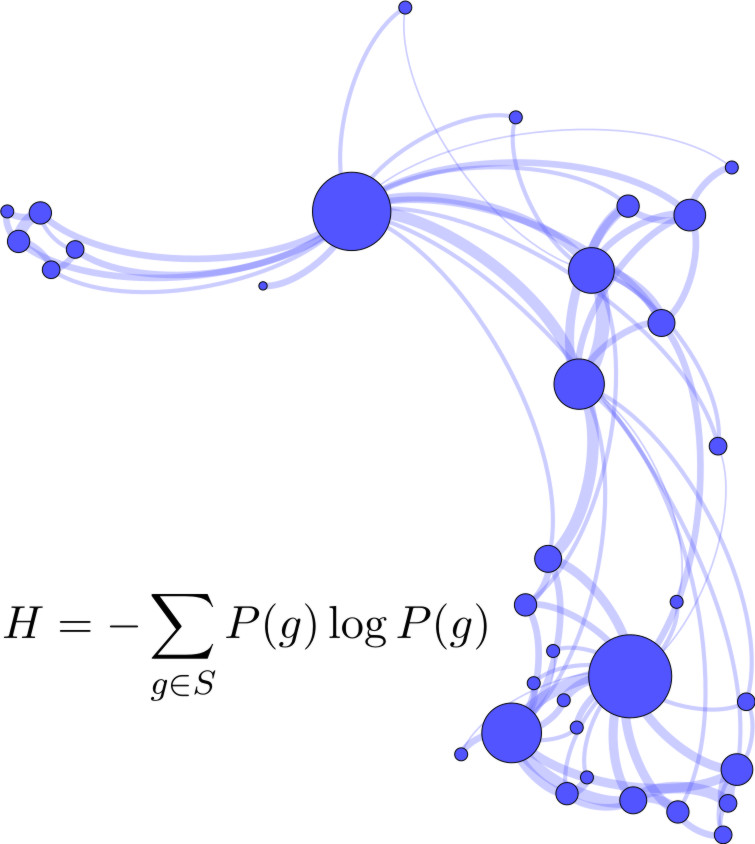
What is the Entropy of a Social Organization?
|
[2019]
|
|
Zingg, Christian;
Casiraghi, Giona;
Vaccario, Giacomo;
Schweitzer, Frank
|
Entropy,
volume: 21,
number: 9
|
more» «less
|
Abstract
We quantify a social organization's potentiality, that is its ability to attain different configurations. The organization is represented as a network in which nodes correspond to individuals and (multi-)edges to their multiple interactions. Attainable configurations are treated as realizations from a network ensemble. To encode interaction preferences between individuals, we choose the generalized hypergeometric ensemble of random graphs, which is described by a closed-form probability distribution. From this distribution we calculate Shannon entropy as a measure of potentiality. This allows us to compare different organizations as well different stages in the development of a given organization. The feasibility of the approach is demonstrated using data from 3 empirical and 2 synthetic systems.


Quantifying Triadic Closure in Multi-Edge Social Networks
|
[2019]
|
|
Brandenberger, Laurence;
Casiraghi, Giona;
Nanumyan, Vahan;
Schweitzer, Frank
|
ASONAM '19: Proceedings of the 2019 IEEE/ACM International Conference on Advances in Social Networks Analysis and Mining
|
more» «less
|
Abstract
Multi-edge networks capture repeated interactions between individuals. In social networks, such edges often form closed triangles, or triads. Standard approaches to measure this triadic closure, however, fail for multi-edge networks, because they do not consider that triads can be formed by edges of different multiplicity. We propose a novel measure of triadic closure for multi-edge networks of social interactions based on a shared partner statistic. We demonstrate that our operalization is able to detect meaningful closure in synthetic and empirical multi-edge networks, where common approaches fail. This is a cornerstone in driving inferential network analyses from the analysis of binary networks towards the analyses of multi-edge and weighted networks, which offer a more realistic representation of social interactions and relations.
git2net - An Open Source Package to Mine Time-Stamped Collaboration Networks from Large git Repositories
|
[2019]
|
|
Schweitzer, Frank;
Gote, Christoph;
Scholtes, Ingo
|
Proceedings of the 16th International Conference on Mining Software Repositories,
pages: 433-444
|
more» «less
|
Abstract
Data from software repositories have become an important foundation for the empirical study of software engineering processes. A recurring theme in the repository mining literature is the inference of developer networks capturing e.g. collaboration, coordination, or communication from the commit history of projects. Most of the studied networks are based on the co-authorship of software artefacts defined at the level of files, modules, or packages. While this approach has led to insights into the social aspects of software development, it neglects detailed information on code changes and code ownership, e.g. which exact lines of code have been authored by which developers, that is contained in the commit log of software projects.
Addressing this issue, we introduce git2net, a scalable python software that facilitates the extraction of fine-grained co-editing networks in large git repositories. It uses text mining techniques to analyse the detailed history of textual modifications within files. This information allows us to construct directed, weighted, and time-stamped networks, where a link signifies that one developer has edited a block of source code originally written by another developer. Our tool is applied in case studies of an Open Source and a commercial software project. We argue that it opens up a massive new source of high-resolution data on human collaboration patterns.

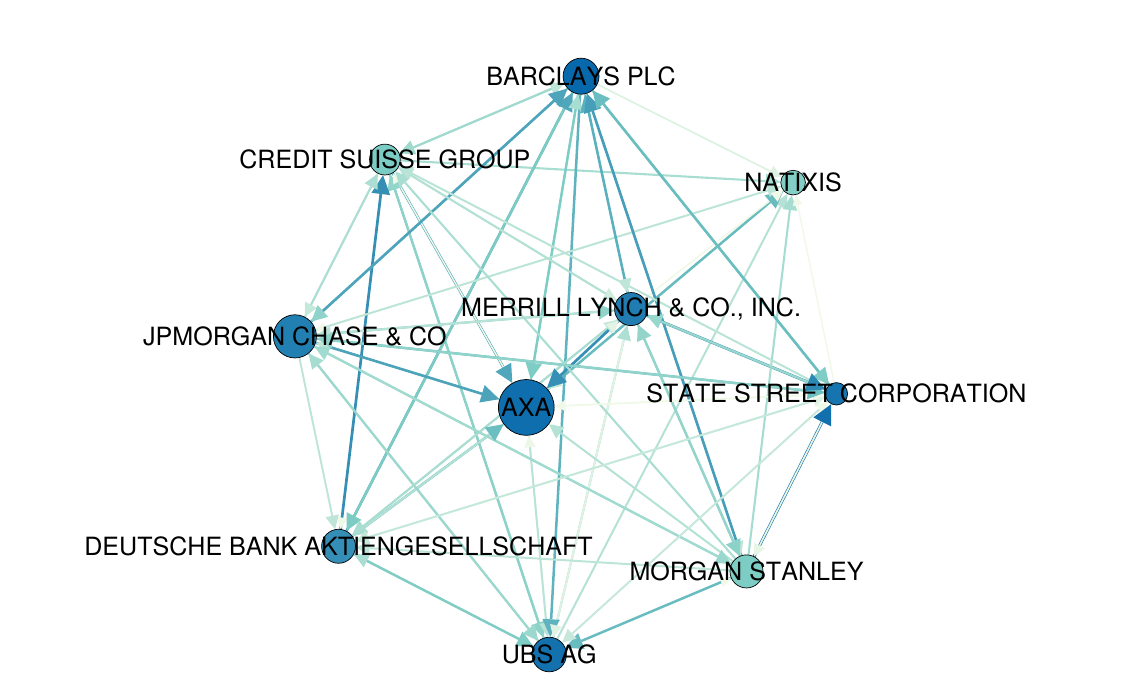
The interdependence of corporate reputation and ownership: A network approach to quantify reputation
|
[2019]
|
|
Zhang, Dr. Yan;
Schweitzer, Frank
|
Royal Society Open Science,
pages: 190570,
volume: 6
|
more» «less
|
Abstract
We propose a novel way to measure the reputation of firms by using information about their ownership structure. Supported by the signaling theory, we argue that ownership relations channel reputation spillovers between shareholders and their invested companies. We model such reputation spillovers by means of a simple dynamics that runs on the ownership network, constructed from available data bases. We focus on the core of the global ownership network with 1'300 firms and 12'100 ownership links. Our method assigns a ownership-based reputation value to each firm, used to provide a quantitative reputation ranking. We compare our ranking with alternative rankings, to confirm that the top ranked firms are correctly identified. We also demonstrate that our reputation measure does not correlate substantially with operating revenue or control and thus provides additional information about firms.


The Bigger Picture: Complexity Meets Systems Design
|
[2019]
|
|
Schweitzer, Frank
|
Design. Tales of Science and Innovation
|
more» «less
|
Abstract
System design – the term immediately evokes associations with the freedoms of a divine creator. However, it is precisely this idea that already describes the problem: like any other design, system design must respect certain boundaries, but the complexity of the design is far greater. Before we can even formulate systems design questions, we must first clarify what we want to mean by a system, which approach we choose to system modelling, and how we validate these models. This addresses the methodological-technical aspects of systems design. The methodological-critical perspective focuses on the limits of systems design. What do we actually want to achieve with systems design? It doesn't take long to draw up a wish list. But how meaningful or feasible are these wishes? Here, we must critically question our expectations.

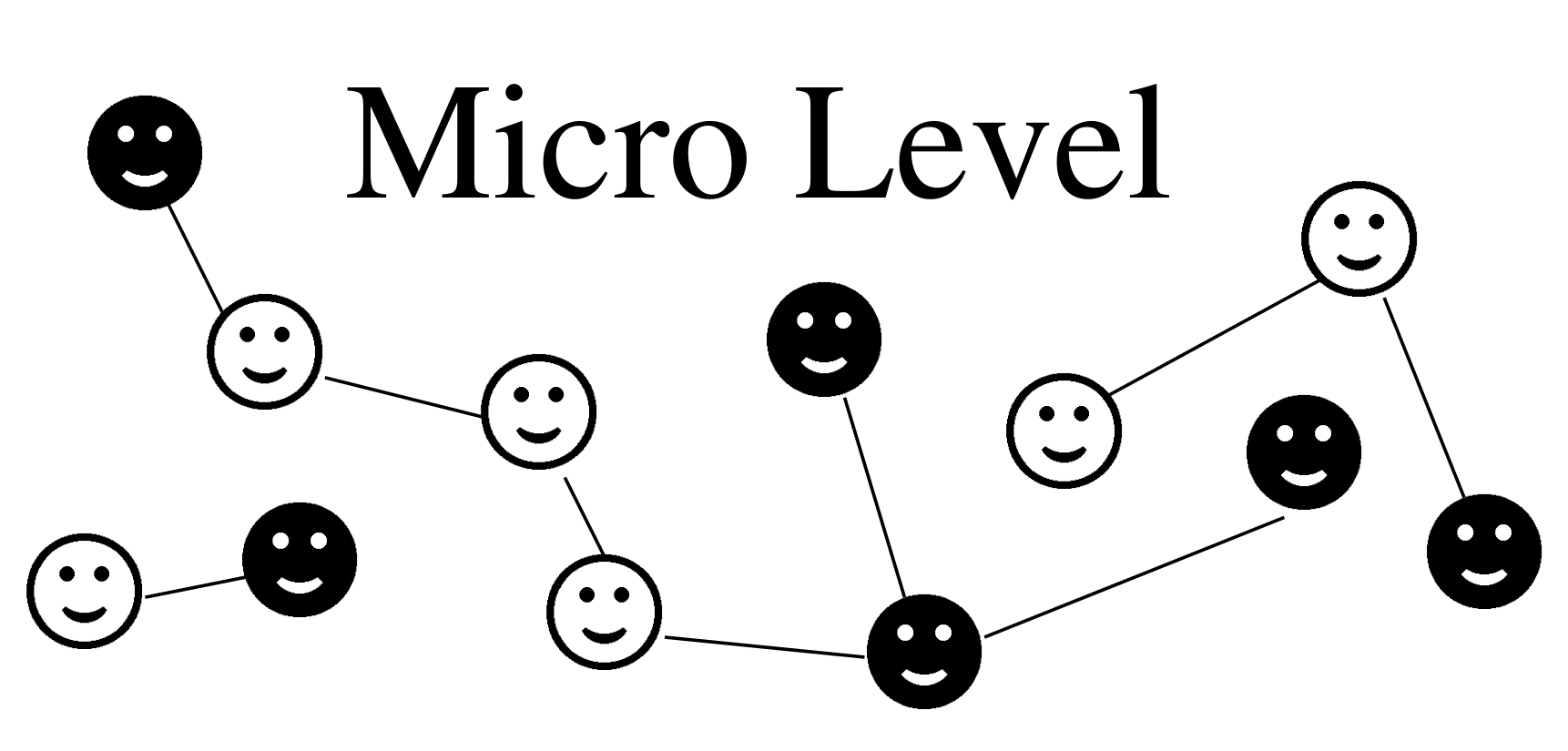
An agent-based framework of active matter with applications in biological and social systems
|
[2019]
|
|
Schweitzer, Frank
|
European Journal of Physics,
volume: 40,
number: 1
|
more» «less
|
Abstract
Active matter, as other types of self-organizing systems, relies on the take-up of energy that can be used for different actions, such as active motion or structure formation. Here we provide an agent-based framework to model these processes at different levels of organization, physical, biological and social, using the same dynamic approach. Driving variables describe the take-up, storage and conversion of energy, whereas driven variables describe the energy consuming activities. The stochastic dynamics of both types of variables follow a modified Langevin equation. Additional non-linear functions allow to encode system-specific hypotheses about the relation between driving and driven variables. To demonstrate the applicability of this framework, we recast a number of existing models of Brownian agents and Active Brownian Particles. Specifically, active motion, clustering and self-wiring of networks based on chemotactic interactions, online communication and polarization of opinions based on emotional influence are discussed. The framework allows to obtain critical parameters for active motion and the emergence of collective phenomena. This highlights the role of energy take-up and dissipation in obtaining different dynamic regimes.

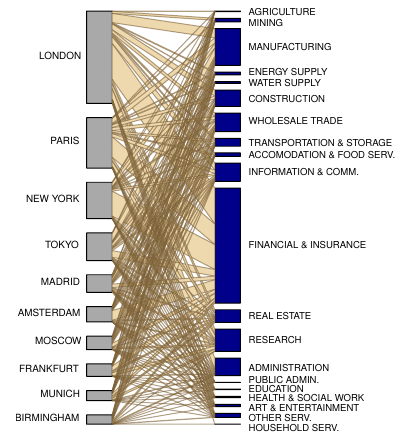
Economic Specialization and the Nested Bipartite Network of City-Firm Relations
|
[2019]
|
|
Garas, Antonios;
Rozenblat, C'eline;
Schweitzer, Frank
|
Multiplex and Multilevel Networks
|
more» «less
|
Abstract
How are economic activities linked to geographic locations? To answer this question, we use a data-driven approach that builds on the information about location, ownership and economic activities of the world's 3,000 largest firms and their almost one million subsidiaries. From this information we generate a bipartite network of cities linked to economic activities. Analysing the structure of this network, we find striking similarities with nested networks observed in ecology, where links represent mutualistic interactions between species. This motivates us to apply ecological indicators to identify the unbalanced deployment of economic activities. Such deployment can lead to an over-representation of specific economic sectors in a given city, and poses a significant thread for the city's future especially in times when the over-represented activities face economic uncertainties. If we compare our analysis with external rankings about the quality of life in a city, we find that the nested structure of the city-firm network also reflects such information about the quality of life, which can usually be assessed only via dedicated survey-based indicators.
Physikalische Aspekte der Evolutorischen Ökonomik
|
[2018]
|
|
Schweitzer, Frank
|
Handbuch zur Evolutorischen Ökonomik
|
more» «less
|

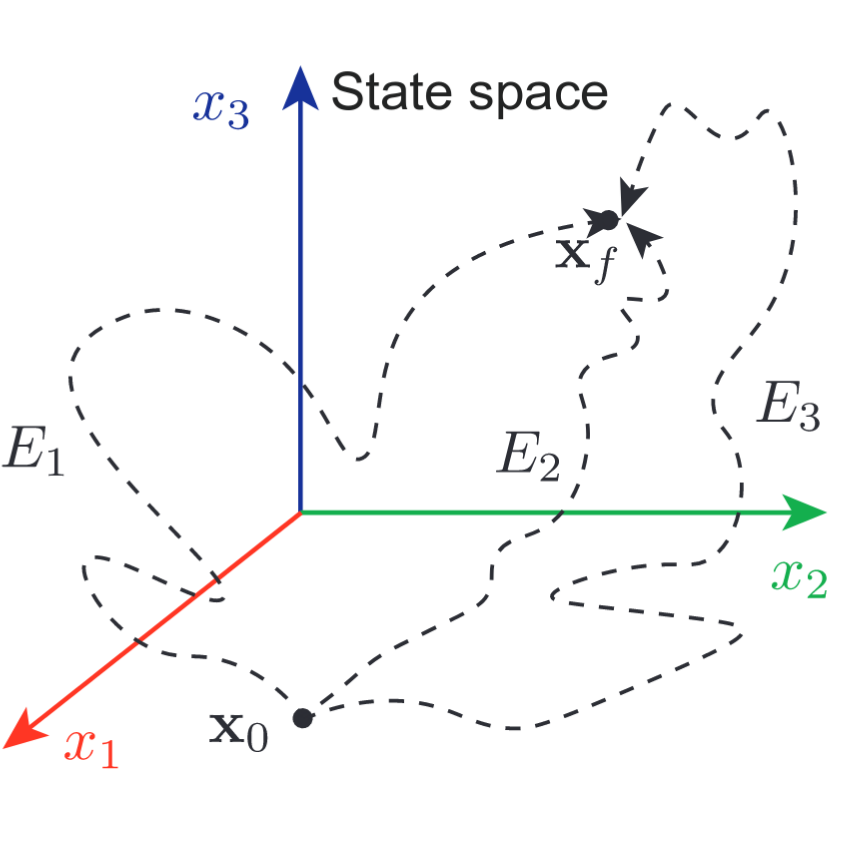
The optimal trajectory to control complex networks
|
[2018]
|
|
Li, Aming;
Wang, Long;
Schweitzer, Frank
|
arXiv: 1806.04229v1,
pages: 1-- 15
|
more» «less
|
Abstract
Controllability, a basic property of various networked systems, has gained profound theoretical applications in complex social, technological, biological, and brain networks. Yet, little attention has been given to the control trajectory (route), along which a controllable system can be controlled from any initial to any final state, hampering the implementation of practical control. Here we systematically uncover the fundamental relations between control trajectory and several other key factors, such as the control distance between initial and final states ($\delta$), number of driver nodes, and the control time. The length ($\mathcal{L}$) and maximum distance to the initial state ($\mathcal{R}$) are employed to quantify the locality and globality of control trajectories. We analyze how the scaling behavior of the averaged $\mathcal{L}$ and $\mathcal{R}$ changes with increasing $\delta$ for different initial states. After showing the scaling behavior for each trajectory, we also provide the distributions of $\mathcal{L}$ and $\mathcal{R}$. Further attention is given to the control time $t_f$ and its influence on $\mathcal{L}$ and $\mathcal{R}$. Our results provide comprehensive insights in understanding control trajectories for complex networks, and pave the way to achieve practical control in various real systems.

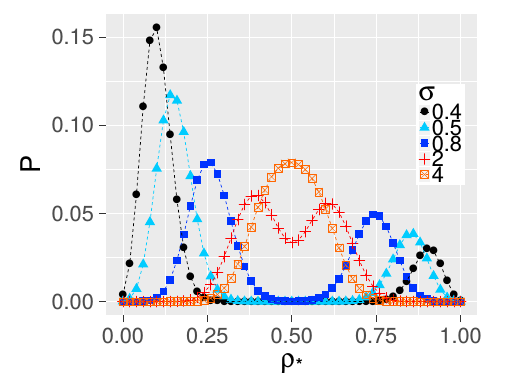
Explicit size distributions of failure cascades redefine systemic risk on finite networks
|
[2018]
|
|
Burkholz, Rebekka;
Herrmann, H. J.;
Schweitzer, Frank
|
Scientific Reports,
pages: 1--8
|
more» «less
|
Abstract
How big is the risk that a few initial failures of nodes in a network amplify to large cascades that span a substantial share of all
nodes? Predicting the final cascade size is critical to ensure the functioning of a system as a whole. Yet, this task is hampered
by uncertain or changing parameters and missing information. In infinitely large networks, the average cascade size can often
be well estimated by established approaches building on local tree approximations and mean field approximations. Yet, as
we demonstrate, in finite networks, this average does not even need to be a likely outcome. Instead, we find broad and even
bimodal cascade size distributions. This phenomenon persists for system sizes up to
10
7
and different cascade models, i.e. it is
relevant for most real systems. To show this, we derive explicit closed-form solutions for the full probability distribution of the
final cascade size. We focus on two topological limit cases, the complete network representing a dense network with a very
narrow degree distribution, and the star network representing a sparse network with a inhomogeneous degree distribution.
Those topologies are of great interest, as they either minimize or maximize the average cascade size and are common motifs
in many real world networks.


Sociophysics
|
[2018]
|
|
Schweitzer, Frank
|
Physics Today,
pages: 40-46,
volume: 71,
number: 2
|
more» «less
|
Abstract
To the extent that individuals interact with each other in prescribed ways, their collective social behavior can be modeled and analyzed.
Twenty-four years ago Paul Krugman, who went on to receive the 2008 Nobel Prize in Economic Sciences, wrote, “Economics is harder than physics; luckily it is not quite as hard as sociology.”1 Thirteen years ago Doyne Farmer, Martin Shubik, and Eric Smith posed the question, Is economics the next physical science? (see Physics Today, September 2005, page 37). If you were skeptical then about sociology as the next physical science, you may be even more skeptical now.

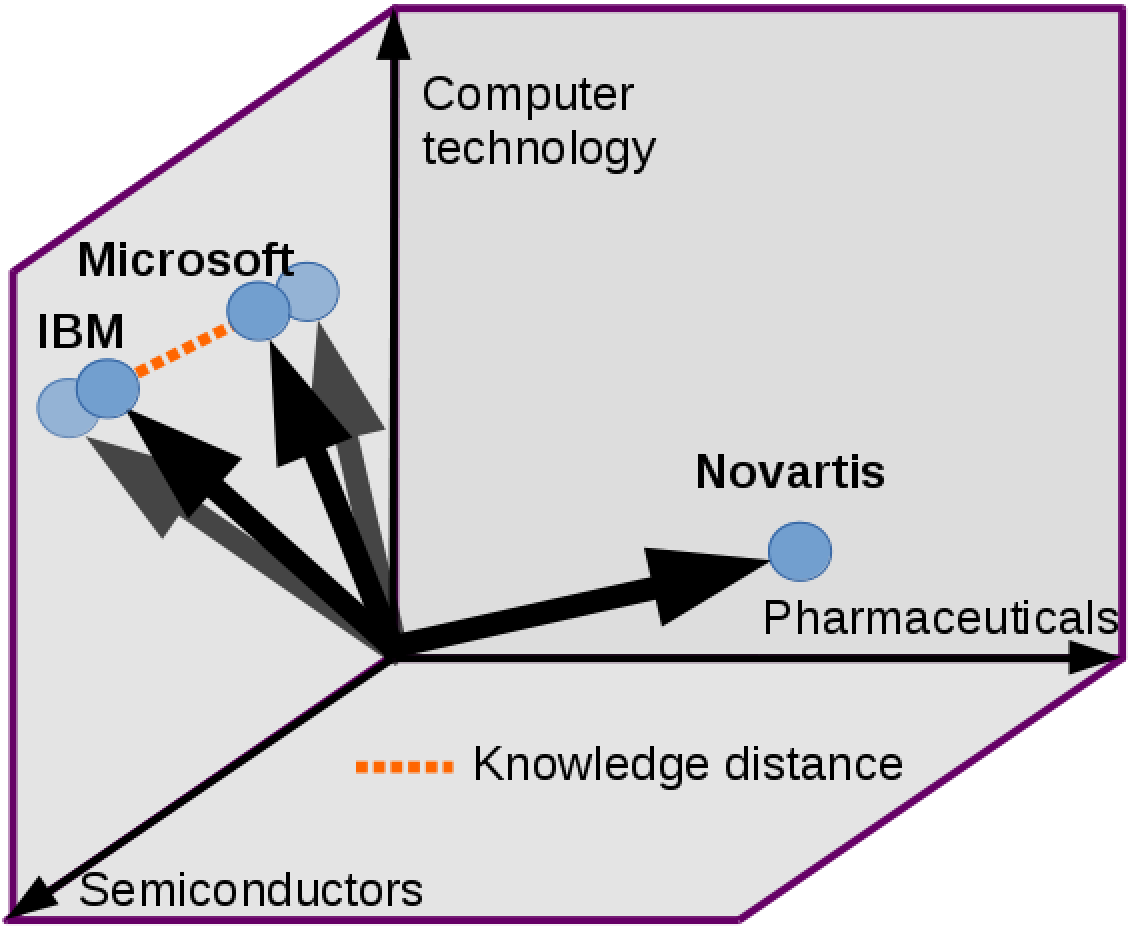
Quantifying knowledge exchange in R&D networks: A data-driven model
|
[2018]
|
|
Vaccario, Giacomo;
Tomasello, Mario Vincenzo;
Tessone, Claudio Juan;
Schweitzer, Frank
|
Journal of Evolutionary Economics,
pages: 461-493,
volume: 28,
number: 3
|
more» «less
|
Abstract
We propose a model that reflects two important processes in R&D activities of firms, the formation of R&D alliances and the exchange of knowledge as a result of these collaborations. In a data-driven approach, we analyze two large-scale data sets extracting unique information about 7500 R&D alliances and 5200 patent portfolios of firms. This data is used to calibrate the model parameters for network formation and knowledge exchange. We obtain probabilities for incumbent and newcomer firms to link to other incumbents or newcomers which are able to reproduce the topology of the empirical R&D network. The position of firms in a knowledge space is obtained from their patents using two different classification schemes, IPC in 8 dimensions and ISI-OST-INPI in 35 dimensions. Our dynamics of knowledge exchange assumes that collaborating firms approach each other in knowledge space at a rate $μ$ for an alliance duration $τ$. Both parameters are obtained in two different ways, by comparing knowledge distances from simulations and empirics and by analyzing the collaboration efficiency $\hat{C}_n$. This is a new measure, that takes also in account the effort of firms to maintain concurrent alliances, and is evaluated via extensive computer simulations. We find that R&D alliances have a duration of around two years and that the subsequent knowledge exchange occurs at a very low rate. Hence, a firm's position in the knowledge space is rather a determinant than a consequence of its R&D alliances. From our data-driven approach we also find model configurations that can be both realistic and optimized with respect to the collaboration efficiency $\hat{C}_n$. Effective policies, as suggested by our model, would incentivize shorter R&D alliances and higher knowledge exchange rates.


Correlations between thresholds and degrees: An analytic approach to model attacks and failure cascades
|
[2018]
|
|
Burkholz, Rebekka;
Schweitzer, Frank
|
Phys. Rev. E,
volume: 98,
number: 2
|
more» «less
|
Abstract
Two node variables determine the evolution of cascades in random networks: a node's degree and threshold. Correlations between both fundamentally change the robustness of a network, yet, they are disregarded in standard analytic methods as local tree or heterogeneous mean field approximations because of the bad tractability of order statistics. We show how they become tractable in the thermodynamic limit of infinite network size. This enables the analytic description of node attacks that are characterized by threshold allocations based on node degree. Using two examples, we discuss possible implications of irregular phase transitions and different speeds of cascade evolution for the control of cascades.

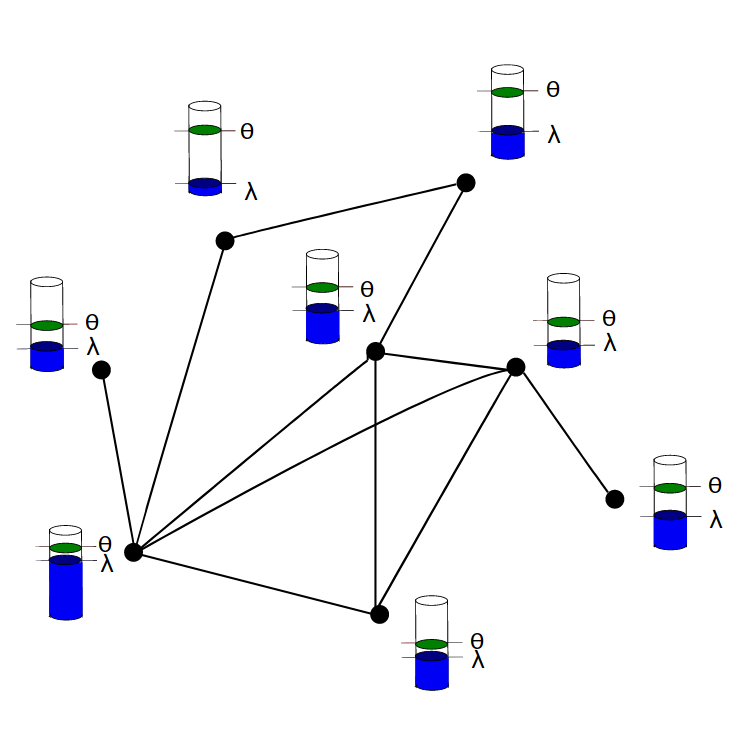
A framework for cascade size calculations on random networks
|
[2018]
|
|
Burkholz, Rebekka;
Schweitzer, Frank
|
Physical Review E,
volume: 97,
number: 4
|
more» «less
|
Abstract
We present a framework to calculate the cascade size evolution for a large class of cascade models
on random network ensembles in the limit of infinite network size. Our method is exact and applies
to network ensembles with almost arbitrary degree distribution, degree-degree correlations and, in
case of threshold models, for arbitrary threshold distribution. With our approach, we shift the
perspective from the known branching process approximations to the iterative update of suitable
probability distributions. Such distributions are key to capture cascade dynamics that involve
possibly continuous quantities and that depend on the cascade history, e.g. if load is accumulated
over time. As a proof of concept, we provide two examples: (a) Constant load models that cover
many of the analytically tractable casacade models, and, as a highlight, (b) a fiber bundle model
that was not tractable by branching process approximations before. Our derivations cover the whole
cascade dynamics, not only their steady state. This allows to include interventions in time or further
model complexity in the analysis.

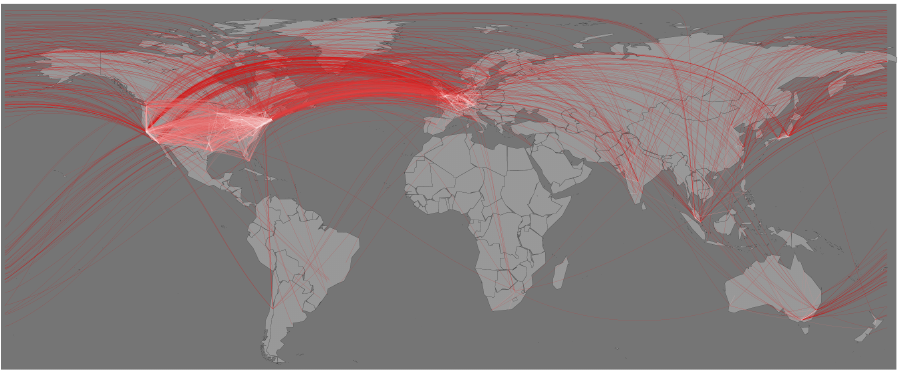
The spatial component of R&D networks
|
[2018]
|
|
Scholl, Tobias;
Garas, Antonios;
Schweitzer, Frank
|
Journal of Evolutionary Economics,
pages: 417-436,
volume: 28,
number: 2
|
more» «less
|
Abstract
We study the role of geography in R&D networks by means of a quantitative, micro-geographic approach. Using a large database that covers international R&D collaborations from 1984 to 2009, we localize each actor precisely in space through its latitude and longitude. This allows us to analyze the R&D network at all geographic scales simultaneously. Our empirical results show that despite the high importance of the city level, transnational R&D collaborations at large distances are much more frequent than expected from similar networks. This provides evidence for the ambiguity of distance in economic cooperation which is also suggested by the existing literature. In addition we test whether the hypothesis of local buzz and global pipelines applies to the observed R&D network by calculating well-defined metrics from network theory.

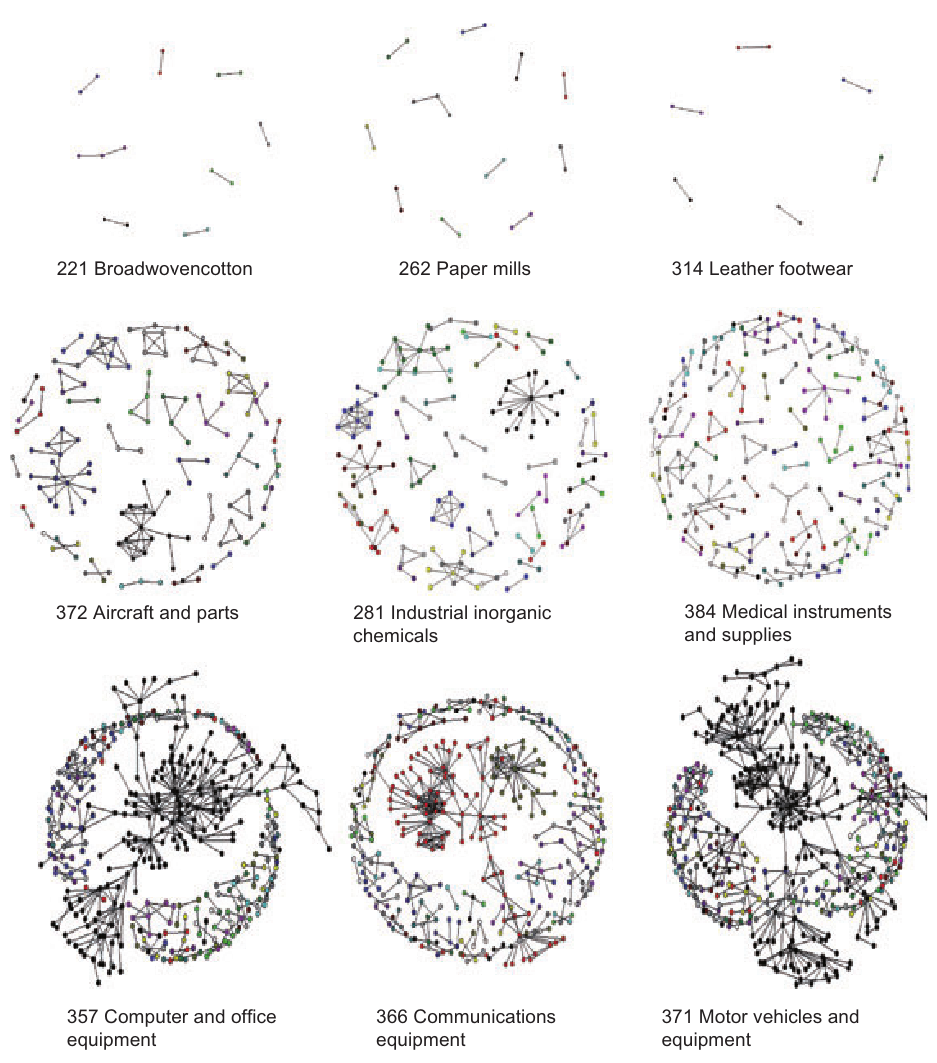
Innovator Networks
|
[2018]
|
|
Tomasello, Mario Vincenzo;
Mueller, Moritz;
Schweitzer, Frank
|
Encyclopedia of Social Network Analysis and Mining
|
more» «less
|
Abstract
From the perspective of innovation economics evolving institutions, innovating entrepreneurs, technological change, and creative destruction are the driving force of economic growth (Schumpeter, 1942). To mitigate the uncertainty involved in the creation of new processes, products, or business models, innovation exhibits an intrinsic collaborative nature. Innovator networks form through formal and informal collaborations between different agents, including firms, institutions, universities, state agencies, inventors, and other stakeholders of the innovation system. Being embedded in a network enables these agents to coordinate innovative efforts, as well as to pool and jointly create knowledge.

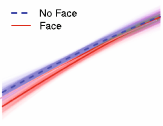
Evaluative Patterns and Incentives in YouTube
|
[2017]
|
|
Abisheva, Adiya;
Garcia, David;
Schweitzer, Frank
|
Social Informatics
|
more» «less
|
Abstract
Users of social media are not only producers and consumers of online content, they also evaluate each other’s content. Some social media include the possibility to down vote or dislike the content posted by other users, posing the risk that users who receive dislikes might be more likely to become inactive, especially if the disliked content is about a person. We analyzed the data on more than 150,000 YouTube videos to understand how video impact and user incentives can be related to the possibility to dislike user content. We processed images related to videos to identify faces and quantify if evaluating content related to people is connected to disliking patterns. We found that videos with faces on their images tend to have less dislikes if they are posted by male users, but the effect is not present for female users. On the contrary, videos with faces and posted by female users attract more views and likes. Analyzing the probability of users to become inactive, we find that receiving dislikes is associated with users becoming inactive. This pattern is stronger when dislikes are given to videos with faces, showing that negative evaluations about people have a stronger association with user inactivity. Our results show that user evaluations in social media are a multi-faceted phenomenon that requires large-scale quantitative analyses, identifying under which conditions users disencourage other users from being active in social media.

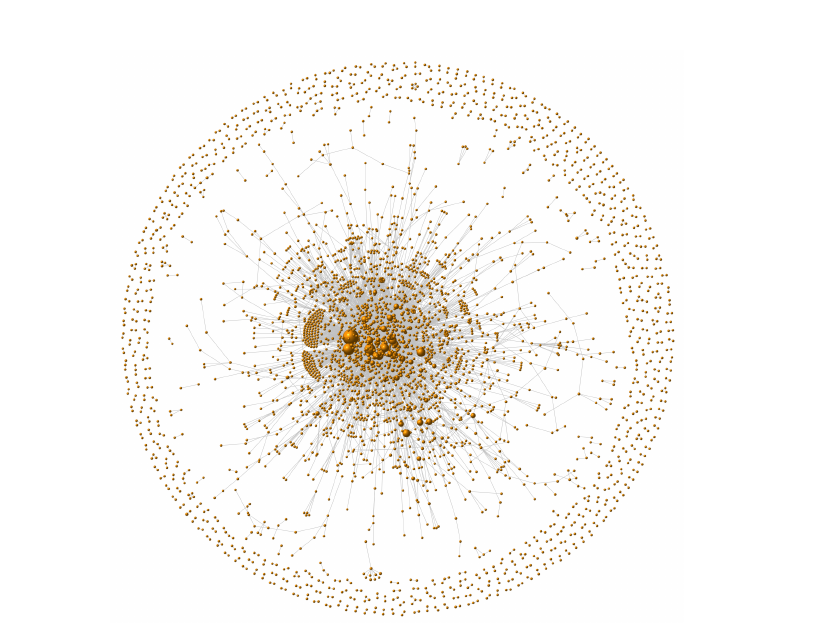
Modeling the formation of R&D alliances: An agent-based model with empirical validation
|
[2017]
|
|
Tomasello, Mario Vincenzo;
Burkholz, Rebekka;
Schweitzer, Frank
|
Economics,
number: 2017-107
|
more» «less
|
Abstract
The authors develop an agent-based model to reproduce the size distribution of R&D alliances of firms. Agents are uniformly selected to initiate an alliance and to invite collaboration partners. These decide about acceptance based on an individual threshold that is compared with the utility expected from joining the current alliance. The benefit of alliances results from the fitness of the agents involved. Fitness is obtained from an empirical distribution of agent's activities. The cost of an alliance reflects its coordination effort. Two free parameters ac and a1 scale the costs and the individual threshold. If initiators receive R rejections of invitations, the alliance formation stops and another initiator is selected. The three free parameters (ac; a1; R) are calibrated against a large scale data set of about 15,000 firms engaging in about 15,000 R&D alliances over 26 years. For the validation of the model the authors compare the empirical size distribution with the theoretical one, using confidence bands, to find a very good agreement. As an asset of our agent-based model, they provide an analytical solution that allows to reduce the simulation effort considerably. The analytical solution applies to general forms of the utility of alliances. Hence, the model can be extended to other cases of alliance formation. While no information about the initiators of an alliance is available, the results indicate that mostly firms with high fitness are able to attract newcomers and to establish larger alliances.

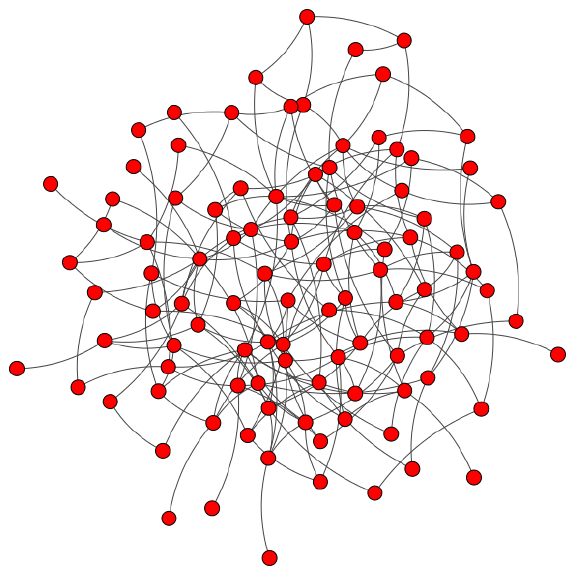
Limits to Scaling – and How to Move beyond Them
|
[2017]
|
|
Schweitzer, Frank
|
Too Big to Scale-On Scaling Space, Number, Time and Energy
|
more» «less
|
Abstract
In engineering, the term "scaling" may be used to describe a relation between objects and their models. In the exact sciences, however, scaling is a systemic property, i.e. it relates to the system itself and not to our perception of it. Scaling describes how certain system properties change conditional on others, most notably the system size.
Certain systems are characterized by a natural scale which remains constant even if the system size increases. Such systems are often described by the so-called normal distribution and are very predictable with respect to that scale, or quantity.
Other systems are scale-free in the sense that no characteristic scale exists. Such systems are characterised by very broad distributions. This means everything can happen with a non-negligible probability.
Such considerations imply that the system properties do not change with scale other than the way defined by the distributions. But complex systems, i.e. systems consisting of a large number of interacting elements (usually denoted as agents), also have the property of emergence. This describes the sudden occurrence of new system qualities once certain critical parameters are reached. This means, above a certain system size the system behaves completely different. Sometimes, it is very difficult to predict when this critical size is reached.
Most real complex systems are characterized both by emergent properties and by scaling laws that do not simply follow a power-law behavior. Economic systems, for example, are often described by decreasing returns to scale.
Conclusion: there are several limits to scaling: (i) natural scales, which are system immanent, (ii) critical parameters at which system properties change in a discontinuous manner, i.e. new system qualities emerge, (iii) decreasing returns to scale, which render any further growth unprofitable.

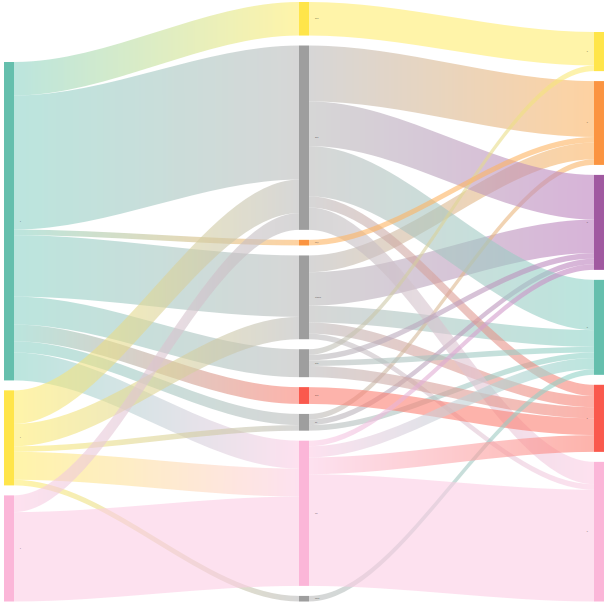
From Relational Data to Graphs: Inferring Significant Links Using Generalized Hypergeometric Ensembles
|
[2017]
|
|
Casiraghi, Giona;
Nanumyan, Vahan;
Scholtes, Ingo;
Schweitzer, Frank
|
SocInfo 2017,
pages: 111--120
|
more» «less
|
Abstract
The inference of network topologies from relational data is an important problem in data analysis. Exemplary applications include the reconstruction of social ties from data on human interactions, the inference of gene co-expression networks from DNA microarray data, or the learning of semantic relationships based on co-occurrences of words in documents. Solving these problems requires techniques to infer significant links in noisy relational data. In this short paper, we propose a new statistical modeling framework to address this challenge. It builds on generalized hypergeometric ensembles, a class of generative stochastic models that give rise to analytically tractable probability spaces of directed, multi-edge graphs. We show how this framework can be used to assess the significance of links in noisy relational data. We illustrate our method in two data sets capturing spatio-temporal proximity relations between actors in a social system. The results show that our analytical framework provides a new approach to infer significant links from relational data, with interesting perspectives for the mining of data on social systems.


Data-driven modeling of collaboration networks: A cross-domain analysis
|
[2017]
|
|
Tomasello, Mario Vincenzo;
Vaccario, Giacomo;
Schweitzer, Frank
|
EPJ Data Sci.,
pages: 22,
volume: 6
|
more» «less
|
Abstract
We analyze large-scale data sets about collaborations from two different domains: economics, specifically 22.000 R&D alliances between 14.500 firms, and science, specifically 300.000 co-authorship relations between 95.000 scientists. Considering the different domains of the data sets, we address two questions: (a) to what extent do the collaboration networks reconstructed from the data share common structural features, and (b) can their structure be reproduced by the same agent-based model. In our data-driven modeling approach we use aggregated network data to calibrate the probabilities at which agents establish collaborations with either newcomers or established agents. The model is then validated by its ability to reproduce network features not used for calibration, including distributions of degrees, path lengths, local clustering coefficients and sizes of disconnected components. Emphasis is put on comparing domains, but also sub-domains (economic sectors, scientific specializations). Interpreting the link probabilities as strategies for link formation, we find that in R&D collaborations newcomers prefer links with established agents, while in co-authorship relations newcomers prefer links with other newcomers. Our results shed new light on the long-standing question about the role of endogenous and exogenous factors (i.e., different information available to the initiator of a collaboration) in network formation.

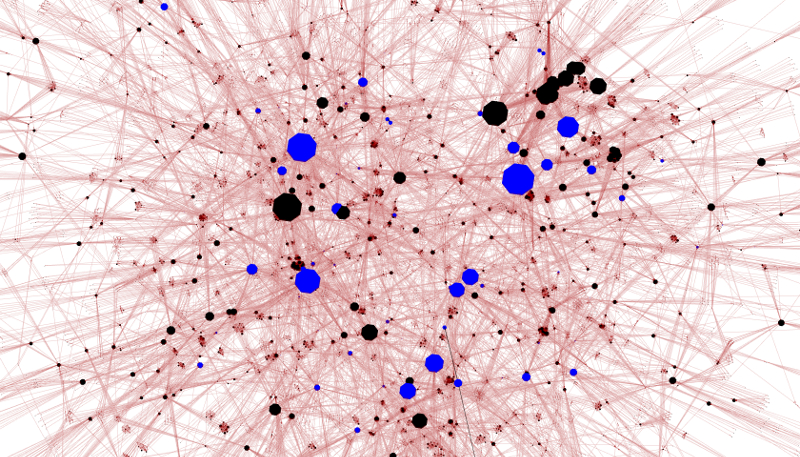
Quantifying the effect of editor-author relations on manuscript handling times
|
[2017]
|
|
Sarigol, Emre;
Garcia, David;
Scholtes, Ingo;
Schweitzer, Frank
|
Scientometrics,
pages: 609–631,
volume: 113,
number: 1
|
more» «less
|
Abstract
In this article we study to what extent the academic peer review pro-cess is influenced by social relations between the authors of a manuscript and the editor handling the manuscript. Taking the Open Access journal PlosOne as a case study, our analysis is based on a data set of more than 100,000 articles pub-lished between 2007 and 2015. Using available data on handling editor, submission and acceptance time of manuscripts, we study the question whether co-authorship relations between authors and the handling editor affect the manuscript handling time, i.e. the time taken between the submission and acceptance of a manuscript. Our analysis reveals (i) that editors handle papers co-authored by previous col-laborators significantly more often than expected at random, and (ii) that such prior co-author relations are significantly related to faster manuscript handling. Addressing the question whether these shorter manuscript handling times can be explained by the quality of publications, we study the number of citations and downloads which accepted papers eventually accumulate. Moreover, we consider the influence of additional (social) factors, such as the editor’s experience, the top-ical similarity between authors and editors, as well as reciprocal citation relations between authors and editors. Our findings show that, even when correcting for other factors like time, experience, and performance, prior co-authorship relations have a large and significant influence on manuscript handling times, speeding up the editorial decision on average by 19 days.

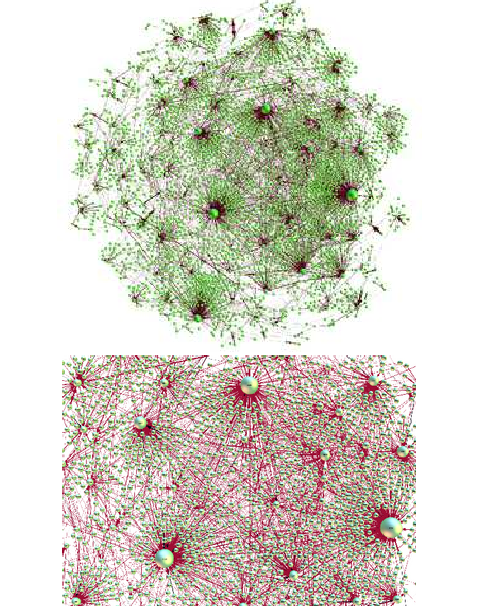
Agent-Based Simulations of Emotional Dialogs in the Online Social Network MySpace
|
[2017]
|
|
Tadic, Bosiljka;
Suvakov, Milovan;
Garcia, David;
Schweitzer, Frank
|
Cyberemotions: Collective Emotions in Cyberspace
|
more» «less
|
Abstract
Quantitative analysis of the empirical data from online social networks reveals the occurrence of group dynamics in which the user’s emotions are involved. Full understanding of the underlying mechanisms, however, remains a challenging task. Using agent-based computer simulations, in this work we study the dynamics of emotional communications in online social networks. The rules that guide how the agents interact, are motivated by actual online social systems. The realistic network structure and some key parameters are inferred from the empirical dataset compiled from the MySpace social network. An agent’s emotional state is characterized by two variables representing emotional arousal—reactivity to stimuli, and valence—attractiveness or averseness, by which a commonly known emotion can be identified. Elevated arousal triggers an agent’s action. In the simulations, each message is identified as carrying an agent’s emotion along a network link; an aggregated and continuously aging impact of these messages on the recipient agent is considered. Our results indicate that group behavior may arise from individual emotional actions of agents; the collective states appear, which are characterized by temporal correlations and predominantly positive emotions, in analogy to the empirical system; the driving signal—rate of the user stepping into the online world—has a profound effect on building the coherent behaviors that are observed in online social networks. Moreover, our simulations suggest that spreading patterns may differ for the emotions with the entirely different positive and negative emotional content.

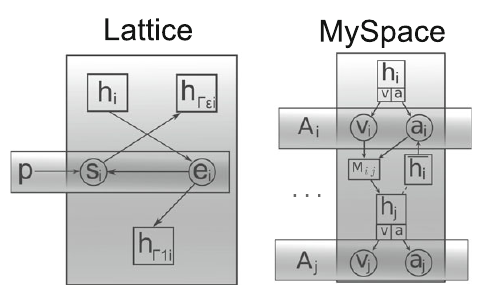
An Agent-Based Modeling Framework for Online Collective Emotions
|
[2017]
|
|
Garcia, David;
Garas, Antonios;
Schweitzer, Frank
|
Cyberemotions: Collective Emotions in Cyberspace
|
more» «less
|
Abstract
Online communication takes a variety of shapes in the different technological media that allow users interact with each other, with their friends, or with arbitrarily large groups. These serve as breeding grounds for collective emotions, in which large amounts of users share emotional states through time. We present our modeling framework for collective emotions in online communities, which can be adapted for the different kinds of online interaction present in the cyberspace. This framework allows the design of agent-based models, in which agents’ emotional states are represented according to psychological theories. This approach aims at a unification of modeling efforts, connecting the sentiment analysis of big data with psychological experiments, through tractable agent-based models. We illustrate the applications of this framework to different online communities, including product reviews, chatrooms, virtual realities, and social networking sites. We show how our model reproduces properties of collective emotions in the reviews of Amazon, and the group discussions of IRC channels. We comment the applications of this framework for data-driven simulation of emotions, and how we formulate testable hypotheses of emotion dynamics for future research on the field.

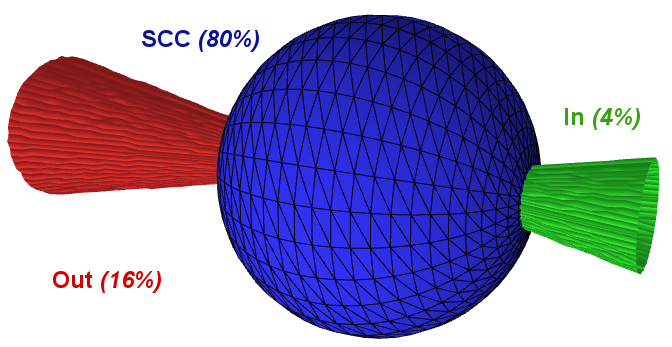
Understanding Popularity, Reputation, and Social Influence in the Twitter Society
|
[2017]
|
|
Garcia, David;
Mavrodiev, Pavlin;
Casati, Daniele;
Schweitzer, Frank
|
Policy & Internet
|
more» «less
|
Abstract
The pervasive presence of online media in our society has transferred a significant part of political deliberation to online forums and social networking sites. This article examines popularity, reputation, and social influence on Twitter using large-scale digital traces from 2009 to 2016. We process network information on more than 40 million users, calculating new global measures of reputation that build on the D-core decomposition and the bow-tie structure of the Twitter follower network. We integrate our measurements of popularity, reputation, and social influence to evaluate what keeps users active, what makes them more popular, and what determines their influence. We find that there is a range of values in which the risk of a user becoming inactive grows with popularity and reputation. Popularity in Twitter resembles a proportional growth process that is faster in its strongly connected component, and that can be accelerated by reputation when users are already popular. We find that social influence on Twitter is mainly related to popularity rather than reputation, but that this growth of influence with popularity is sublinear. The explanatory and predictive power of our method shows that global network metrics are better predictors of inactivity and social influence, calling for analyses that go beyond local metrics like the number of followers.


The Rise and Fall of R&D Networks
|
[2017]
|
|
Tomasello, Mario Vincenzo;
Napoletano, Mauro;
Garas, Antonios;
Schweitzer, Frank
|
ICC - Industrial and Corporate Change,
pages: 617-646,
volume: 26,
number: 4
|
more» «less
|
Abstract
Drawing on a large database of publicly announced R&D alliances, we empirically investigate the evolution of R&D networks and the process of alliance formation in several manufacturing sectors over a 24-year period (1986-2009). Our goal is to empirically evaluate the temporal and sectoral robustness of a large set of network indicators, thus providing a more complete description of R&D networks with respect to the existing literature. We find that most network properties are not only invariant across sectors, but also independent of the scale of aggregation at which they are observed, and we highlight the presence of core-periphery architectures in explaining some properties emphasized in previous empirical studies (e.g. asymmetric degree distributions and small worlds). In addition, we show that many properties of R&D networks are characterized by a rise-and-fall dynamics with a peak in the mid-nineties. We find that such dynamics is driven by mechanisms of accumulative advantage, structural homophily and multiconnectivity. In particular, the change from the "rise" to the "fall" phase is associated to a structural break in the importance of multiconnectivity.


Newcomers vs. incumbents: How firms select their partners for R&D collaborations
|
[2017]
|
|
Garas, Antonios;
Tomasello, Mario Vincenzo;
Schweitzer, Frank
|
arXiv:1403.3298
|
more» «less
|
Abstract
This paper studies the selection of partners for R&D collaborations of firms both empirically, by analyzing a large data set of R&D alliances over 25 years, and theoretically, by utilizing an agent-based model of alliance formation. We quantify the topological position of a firm in the R&D network by means of the weighted k-core decomposition which assigns a coreness value to each firm. The evolution of these coreness values over time reconstructs the career path of individual firms, where lower coreness indicates a better integration of firms in an evolving R&D network. Using a large patent dataset, we demonstrate that coreness values strongly correlate with the number of patents of a firm. Analyzing coreness differences between firms and their partners, we identify a change in selecting partners: less integrated firms choose partners of similar coreness until they reach their best network position. After that, well integrated firms (with low coreness) choose preferably partners with high coreness, either newcomers or firms from the periphery. We use the agent-based model to test whether this change in behavior needs to be explained by means of strategic considerations, i.e. firms switching their strategy in choosing partners dependent on their network position. We find that the observed behavior can be well reproduced without such strategic considerations, this way challenging the role of strategies in explaining macro patterns of collaborations.


Anticipated Shocks in Online Activity: Response Functions of Attention and Word-of-mouth Processes
|
[2016]
|
|
Stommel, Sebastian;
Garcia, David;
Abisheva, Adiya;
Schweitzer, Frank
|
Proceedings of the 8th ACM Conference on Web Science
|
more» «less
|
Abstract
We test the existence of anticipated shocks in online activity, a class of collective dynamics that does not fit in the state of the art theory on social response functions. We use data on shares and views to Youtube videos, measuring their time series to classify them according to their dynamical class. We find evidence of the existence of anticipated shocks, and that they are more likely to appear in word-of-mouth interaction than in attention dynamics. Our results show that not all exogenous events in online activity are unexpected, calling for new models that differentiate social interaction and attention dynamics.

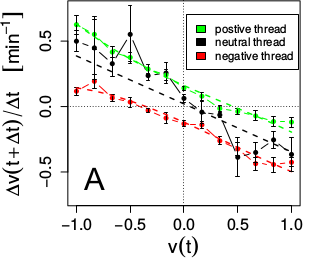
The Dynamics of Emotions in Online Interaction
|
[2016]
|
|
Garcia, David;
Kappas, Arvid;
Kuster, Dennis;
Schweitzer, Frank
|
Royal Society Open Science,
volume: 3,
number: 160059
|
more» «less
|
Abstract
We study the changes in emotional states induced by reading and participating in online discussions, empirically testing a computational model of online emotional interaction. Using principles of dynamical systems, we quantify changes in valence and arousal through subjective reports, as recorded in three independent studies including 207 participants (110 female). In the context of online discussions, the dynamics of valence and arousal are composed of two forces: an internal relaxation towards baseline values independent of the emotional charge of the discussion, and a driving force of emotional states that depends on the content of the discussion. The dynamics of valence show the existence of positive and negative tendencies, while arousal increases when reading emotional content regardless of its polarity. The tendency of participants to take part in the discussion increases with positive arousal. When participating in an online discussion, the content of participants' expression depends on their valence, and their arousal significantly decreases afterwards as a regulation mechanism. We illustrate how these results allow the design of agent-based models to reproduce and analyze emotions in online communities. Our work empirically validates the microdynamics of a model of online collective emotions, bridging online data analysis with research in the laboratory.

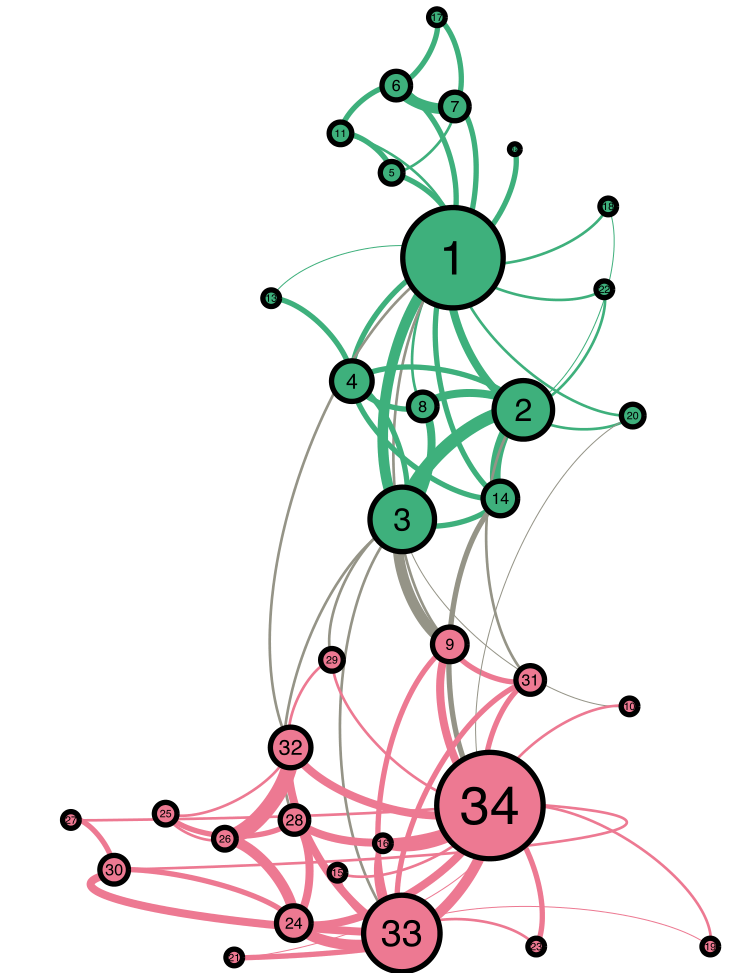
Generalized Hypergeometric Ensembles: Statistical Hypothesis Testing in Complex Networks
|
[2016]
|
|
Casiraghi, Giona;
Nanumyan, Vahan;
Scholtes, Ingo;
Schweitzer, Frank
|
ArXiv e-prints
|
more» «less
|
Abstract
Statistical ensembles define probability spaces of all networks consistent with given aggregate statistics and have become instrumental in the analysis of relational data on networked systems. Their numerical and analytical study provides the foundation for the inference of topological patterns, the definition of network-analytic measures, as well as for model selection and statistical hypothesis testing. Contributing to the foundation of these important data science techniques, in this article we introduce generalized hypergeometric ensembles, a framework of analytically tractable statistical ensembles of finite, directed and weighted networks. This framework can be interpreted as a generalization of the classical configuration model, which is commonly used to randomly generate networks with a given degree sequence or distribution. Our generalization rests on the introduction of dyadic link propensities, which capture the degree-corrected tendencies of pairs of nodes to form edges between each other. Studying empirical and synthetic data, we show that our approach provides broad perspectives for community detection, model selection and statistical hypothesis testing.

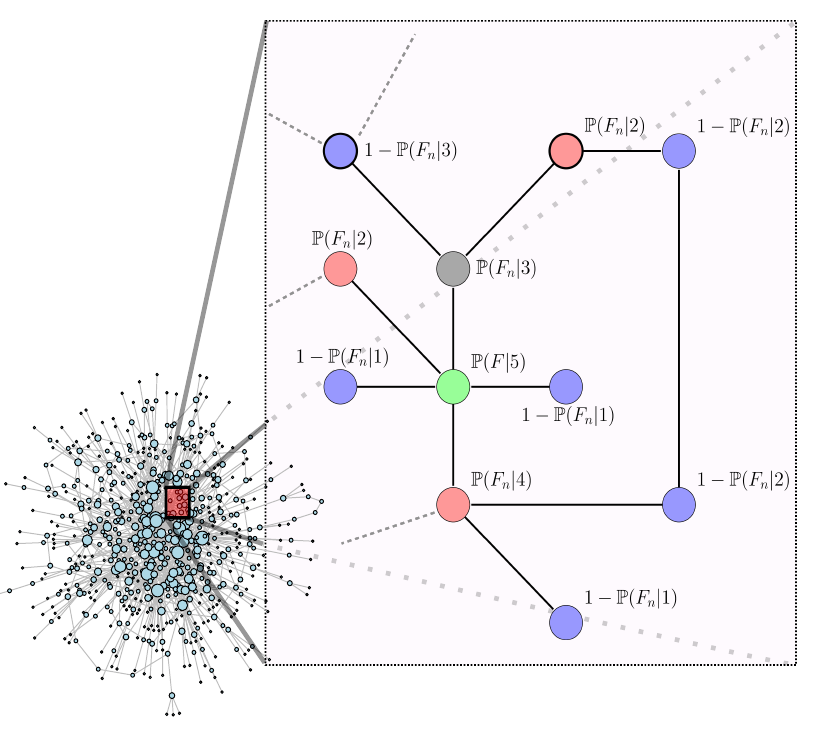
How damage diversification can reduce systemic risk
|
[2016]
|
|
Burkholz, Rebekka;
Garas, Antonios;
Schweitzer, Frank
|
Physical Review E,
pages: 042313,
volume: 93
|
more» «less
|
Abstract
We study the influence of risk diversification on cascading failures in weighted complex networks, where weighted directed links represent exposures between nodes. These weights result from different diversification strategies and their adjustment allows us to reduce systemic risk significantly by topological means. As an example, we contrast a classical exposure diversification (ED) approach with a damage diversification (DD) variant. The latter reduces the loss that the failure of high degree nodes generally inflict to their network neighbors and thus hampers the cascade amplification. To quantify the final cascade size and obtain our results, we develop a branching process approximation taking into account that inflicted losses cannot only depend on properties of the exposed, but also of the failing node. This analytic extension is a natural consequence of the paradigm shift from individual to system safety. To deepen our understanding of the cascade process, we complement this systemic perspective by a mesoscopic one: an analysis of the failure risk of nodes dependent on their degree. Additionally, we ask for the role of these failures in the cascade amplification.

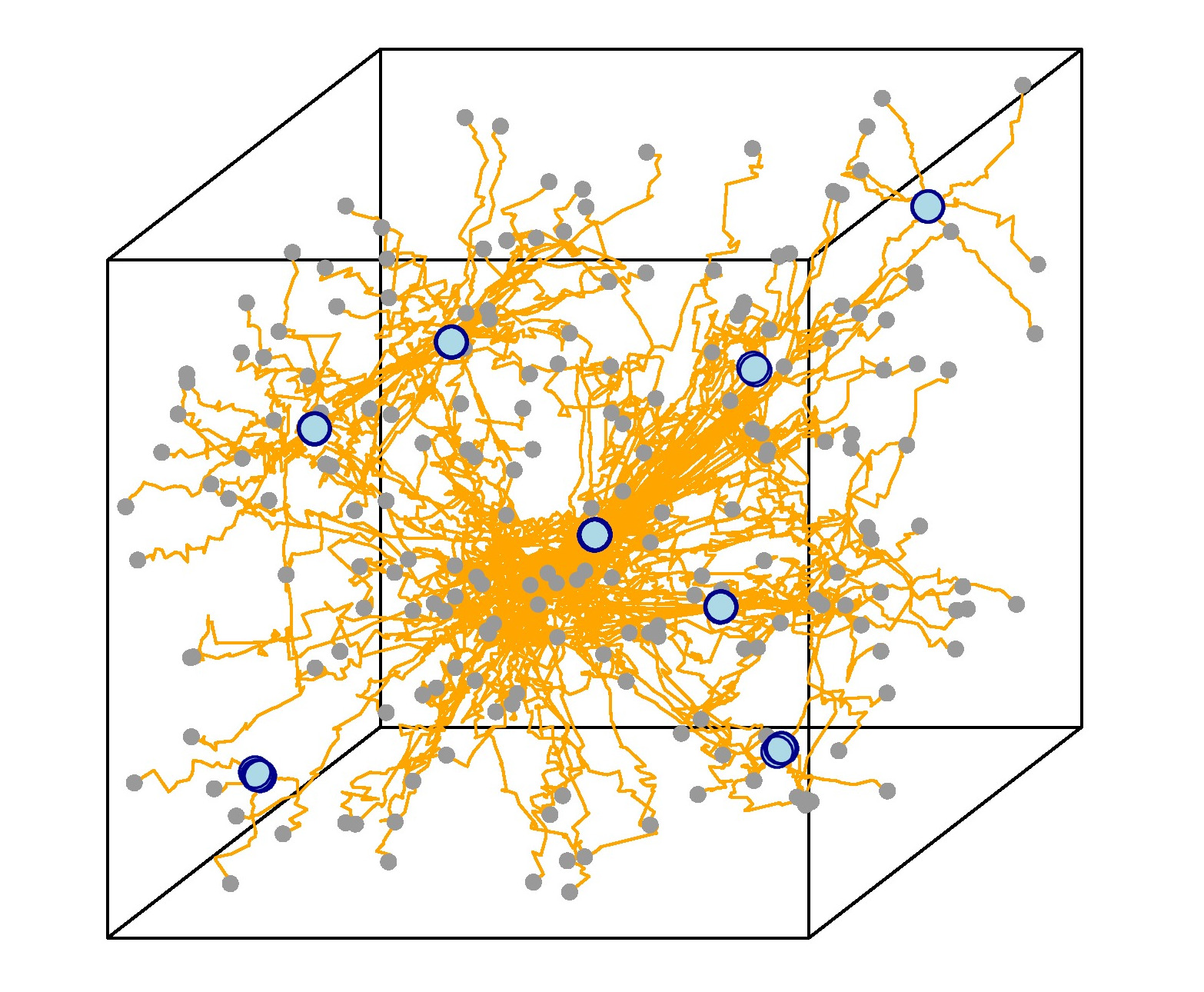
A model of dynamic rewiring and knowledge exchange in R&D networks
|
[2016]
|
|
Tomasello, Mario Vincenzo;
Tessone, Claudio Juan;
Schweitzer, Frank
|
Advances in Complex Systems,
volume: 19,
number: 1 - 2
|
more» «less
|
Abstract
This paper investigates the process of knowledge exchange in inter-firm Research and Development (R&D) alliances by means of an agent-based model. Extant research has pointed out that firms select alliance partners considering both network-related and network-unrelated features (e.g., social capital versus complementary knowledge stocks). In our agent-based model, firms are located in a metric knowledge space. The interaction rules incorporate an exploration phase and a knowledge transfer phase, during which firms search for a new partner and then evaluate whether they can establish an alliance to exchange their knowledge stocks. The model parameters determining the overall system properties are the rate at which alliances form and dissolve and the agents' interaction radius. Next, we define a novel indicator of performance, based on the distance traveled by the firms in the knowledge space. Remarkably, we find that - depending on the alliance formation rate and the interaction radius - firms tend to cluster around one or more attractors in the knowledge space, whose position is an emergent property of the system. And, more importantly, we find that there exists an inverted U-shaped dependence of the network performance on both model parameters.

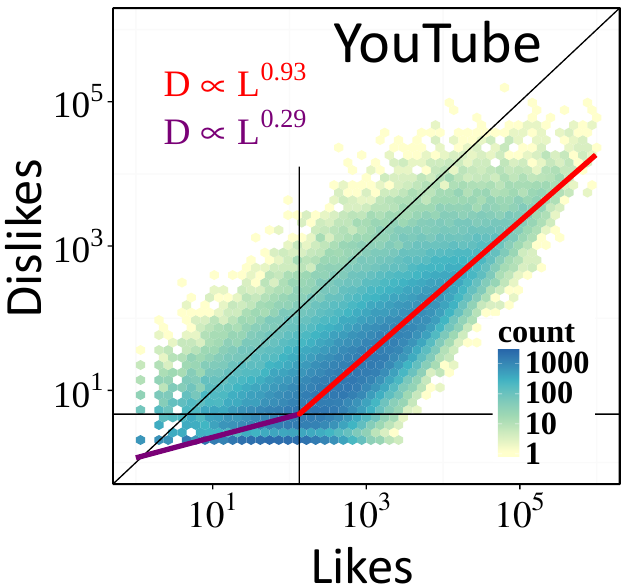
When the Filter Bubble Bursts: Collective Evaluation Dynamics in Online Communities
|
[2016]
|
|
Abisheva, Adiya;
Garcia, David;
Schweitzer, Frank
|
Proceedings of the 8th ACM Conference on Web Science
|
more» «less
|
Abstract
Through the analysis of collective upvotes and downvotes in multiple social media, we discover the bimodal regime of collective evaluations. When online content surpasses the local social context by reaching a threshold of collective attention, negativity grows faster with positivity, which serves as a trace of the burst of a filter bubble. To attain a global audience, we show that emotions expressed in online content has a significant effect and also play a key role in creating polarized opinions.
Remarks
Accepted as a poster.


A conceptual approach to model co-evolution of urban structures
|
[2016]
|
|
Schweitzer, Frank;
Nanumyan, Vahan
|
International Journal of Space Structures,
pages: 43-51,
volume: 31,
number: 1
|
more» «less
|
Abstract
Urban structures encompass settlements, characterized by the spatial distribution of built-up areas, and also transportation structures, to connect these built-up areas. These two structures are very different in their origin and function, fulfilling complementary needs: (1) to access space and (2) to occupy space. Their evolution cannot be understood by looking at the dynamics of urban aggregations and transportation systems separately. Instead, existing built-up areas feed back on the further development of transportation structures, and the availability of the latter feeds back on the future growth of urban aggregations. To model this co-evolution, we propose an agent-based approach that builds on existing agent-based models for the evolution of trail systems and urban settlements. The key element in these separate approaches is a generalized communication of agents by means of an adaptive landscape. This landscape is only generated by the agents, but once it exists, it feeds back on their further actions. The emerging trail system or urban aggregation results as a self-organized structure from these collective interactions. In our co-evolutionary approach, we couple these two separate models by means of meta-agents that represent humans with their different demands for housing and mobility. We characterize our approach as a statistical ensemble approach, which allows to capture the potential of urban evolution in a bottom-up manner, but can be validated against empirical observations.

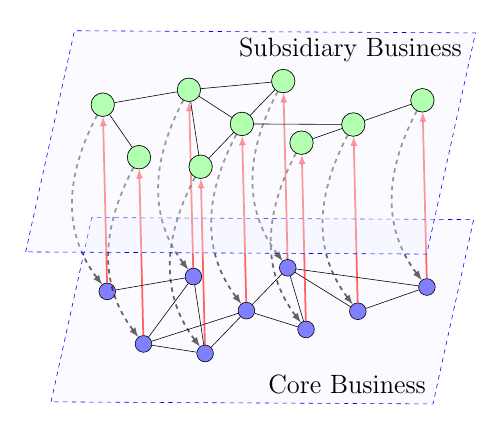
Systemic risk in multiplex networks with asymmetric coupling and threshold feedback
|
[2016]
|
|
Burkholz, Rebekka;
Leduc, Matt;
Garas, Antonios;
Schweitzer, Frank
|
Physica D,
pages: 64--72,
volume: 323-324
|
more» «less
|
Abstract
We study cascades on a two-layer multiplex network, with asymmetric feedback that depends on the coupling strength between the layers. Based on an analytical branching process approximation, we calculate the systemic risk measured by the final fraction of failed nodes on a reference layer. The results are compared with the case of a single layer network that is an aggregated representation of the two layers. We find that systemic risk in the two-layer network is smaller than in the aggregated one only if the coupling strength between the two layers is small. Above a critical coupling strength, systemic risk is increased because of the mutual amplification of cascades in the two layers. We even observe sharp phase transitions in the cascade size that are less pronounced on the aggregated layer. Our insights can be applied to a scenario where firms decide whether they want to split their business into a less risky core business and a more risky subsidiary business. In most cases, this may lead to a drastic increase of systemic risk, which is underestimated in an aggregated approach.

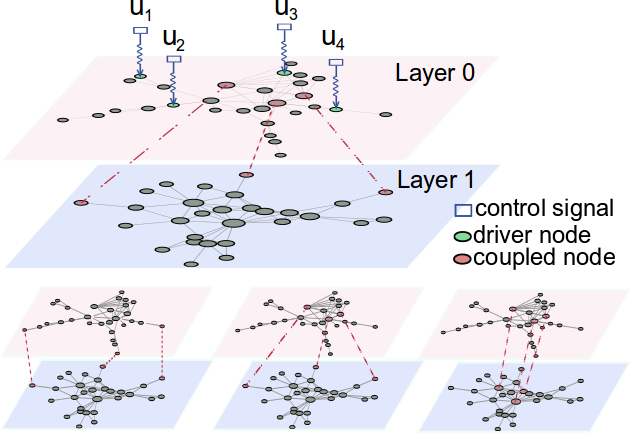
Value of peripheral nodes in controlling multilayer scale-free networks
|
[2016]
|
|
Zhang, Yan;
Garas, Antonios;
Schweitzer, Frank
|
Physical Review E,
pages: 012309,
volume: 93
|
more» «less
|
Abstract
We analyze the controllability of a two-layer network, where driver nodes can be chosen randomly only from one layer. Each layer contains a scale-free network with directed links and the node dynamics depends on the incoming links from other nodes. We combine the in-degree and out-degree values to assign an importance value w to each node, and distinguish between peripheral nodes with low w and central nodes with high w. Based on numerical simulations, we find that the controllable part of the network is larger when choosing low w nodes to connect the two layers. The control is as efficient when peripheral nodes are driver nodes as it is for the case of more central nodes. However, if we assume a cost to utilize nodes that is proportional to their overall degree, utilizing peripheral nodes to connect the two layers or to act as driver nodes is not only the most cost-efficient solution, it is also the one that performs best in controlling the two-layer network among the different interconnecting strategies we have tested.

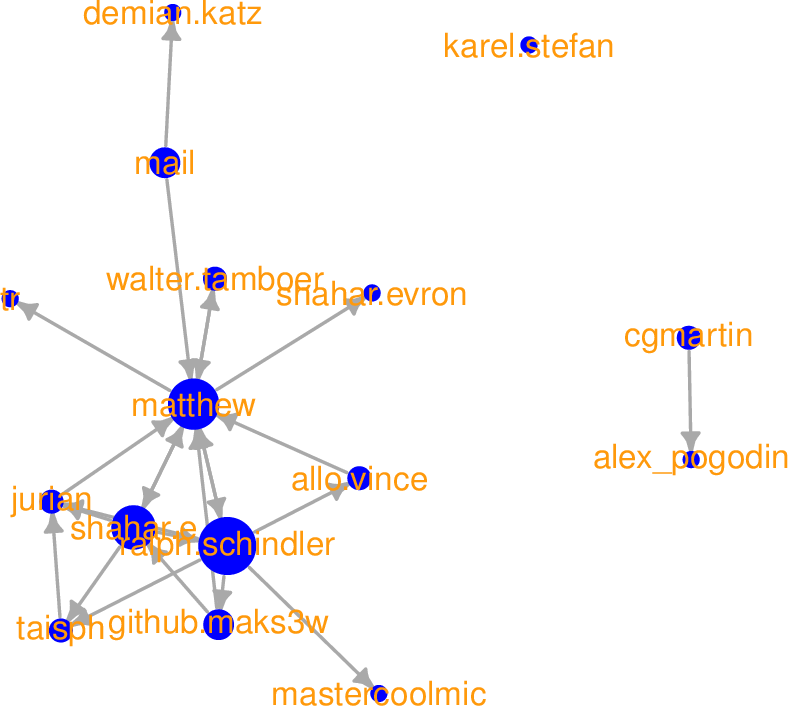
From Aristotle to Ringelmann: A large-scale analysis of team productivity and coordination in Open Source Software projects
|
[2016]
|
|
Scholtes, Ingo;
Mavrodiev, Pavlin;
Schweitzer, Frank
|
Empirical Software Engineering,
pages: 642-683,
volume: 21,
number: 2
|
more» «less
|
Abstract
Complex software development projects rely on the contribution of teams of developers, who are required to collaborate and coordinate their efforts. The productivity of such development teams, i.e., how their size is related to the produced output, is an important consideration for project and schedule management as well as for cost estimation. The majority of studies in empirical software engineering suggest that - due to coordination overhead - teams of collaborating developers become less productive as they grow in size. This phenomenon is commonly paraphrased as Brooks’ law of software project management, which states that “adding manpower to a software project makes it later”. Outside software engineering, the non-additive scaling of productivity in teams is often referred to as the Ringelmann effect, which is studied extensively in social psychology and organizational theory. Conversely, a recent study suggested that in Open Source Software (OSS) projects, the productivity of developers increases as the team grows in size. Attributing it to collective synergetic effects, this surprising finding was linked to the Aristotelian quote that “the whole is more than the sum of its parts”. Using a data set of 58 OSS projects with more than 580,000 commits contributed by more than 30,000 developers, in this article we provide a large-scale analysis of the relation between size and productivity of software development teams. Our findings confirm the negative relation between team size and productivity previously suggested by empirical software engineering research, thus providing quantitative evidence for the presence of a strong Ringelmann effect. Using fine-grained data on the association between developers and source code files, we investigate possible explanations for the observed relations between team size and productivity. In particular, we take a network perspective on developer-code associations in software development teams and show that the magnitude of the decrease in productivity is likely to be related to the growth dynamics of co-editing networks which can be interpreted as a first-order approximation of coordination requirements.
An ensemble perspective on multi-layer networks
|
[2016]
|
|
Wider, Nicolas;
Garas, Antonios;
Scholtes, Ingo;
Schweitzer, Frank
|
Interconnected Networks
|
more» «less
|
Abstract
We study properties of multi-layered, interconnected networks from an ensemble perspective, i.e. we analyze ensembles of multi-layer networks that share similar aggregate characteristics. Using a diffusive process that evolves on a multi-layer network, we analyze how the speed of diffusion depends on the aggregate characteristics of both intra- and inter-layer connectivity. Through a block-matrix model representing the distinct layers, we construct transition matrices of random walkers on multi-layer networks, and estimate expected properties of multi-layer networks using a mean-field approach. In addition, we quantify and explore conditions on the link topology that allow to estimate the ensemble average by only considering aggregate statistics of the layers. Our approach can be used when only partial information is available, like it is usually the case for real-world multi-layer complex systems.


The effect of R&D collaborations on firms' technological positions
|
[2015]
|
|
Tomasello, Mario Vincenzo;
Tessone, Claudio Juan;
Schweitzer, Frank
|
In Proceedings of the 10th International Forum IFKAD 2015
|
more» «less
|
Abstract
We develop an agent-based model to reproduce the processes of link formation and knowledge exchange in a Research and Development (R&D) inter-organizational network. In our model, agents form links based on their network features, i.e. their belonging to one of the network's circles of influence and their previous alliance history, and then exchange knowledge with their partners, thus modifying their positions in a metric knowledge space. Furthermore, we validate the model against real data using a two-step approach. Through the Thomson Reuters SDC alliance dataset, we estimate the model parameters related to the link formation, thus reproducing the topology of the resulting R&D network. Subsequently, using the NBER data on firm patents, we estimate the parameters related to the knowledge exchange process, thus evaluating the rate at which firms exchange knowledge and the duration of the R&D alliances themselves. The underlying knowledge space that we consider in our real example is defined by IPC patent classes, allowing for a precise quantification of every firm's knowledge position. Our novel data-driven approach allows us to unveil the complex interdependencies between the firms' network embeddedness and their technological positions. Through the validation of our model, we find that real R&D alliances have a duration of around two years, and that the subsequent knowledge exchange occurs at a very low rate. Most of the alliances, indeed, have no consequence on the partners' knowledge positions: this suggests that a firm's position - evaluated through its patents - is rather a determinant than a consequence of its R&D alliances. Finally, we propose an indicator of collaboration performance for the whole network. We find that the real R&D network does not maximize such an indicator. Our study shows that there exist configurations that can be both realistic and optimized with respect to the collaboration performance. Effective policies to obtain an optimized collaboration network - as suggested by our model - would incentivize shorter R&D alliances and higher knowledge exchange rates, for instance including rewards for quick co-patenting by allied firms.
Tumor Invasion Optimization by Mesenchymal-Amoeboid Heterogeneity
|
[2015]
|
|
Hecht, Inbal;
Bar - El, Yasmin;
Balmer, Frederic;
Natan, Sari;
Tsarfaty, Ilan;
Schweitzer, Frank;
Ben - Jacob, Eshel
|
Scientific Reports,
pages: 10622,
volume: 5
|
more» «less
|
Abstract
Metastasizing tumor cells migrate through the surrounding tissue and extracellular matrix toward the blood vessels, in order to colonize distant organs. They typically move in a dense environment, filled with other cells. In this work we study cooperative effects between neighboring cells of different types, migrating in a maze-like environment with directional cue. Using a computerized model, we measure the percentage of cells that arrive to the defined target, for different mesenchymal/amoeboid ratios. Wall degradation of mesenchymal cells, as well as motility of both types of cells, are coupled to metabolic energy-like resource level. We find that indirect cooperation emerges in mid-level energy, as mesenchymal cells create paths that are used by amoeboids. Therefore, we expect to see a small population of mesenchymals kept in a mostly-amoeboid population. We also study different forms of direct interaction between the cells, and show that energy-dependent interaction strength is optimal for the migration of both mesenchymals and amoeboids. The obtained characteristics of cellular cluster size are in agreement with experimental results. We therefore predict that hybrid states, e.g. epithelial-mesenchymal, should be utilized as a stress-response mechanism.

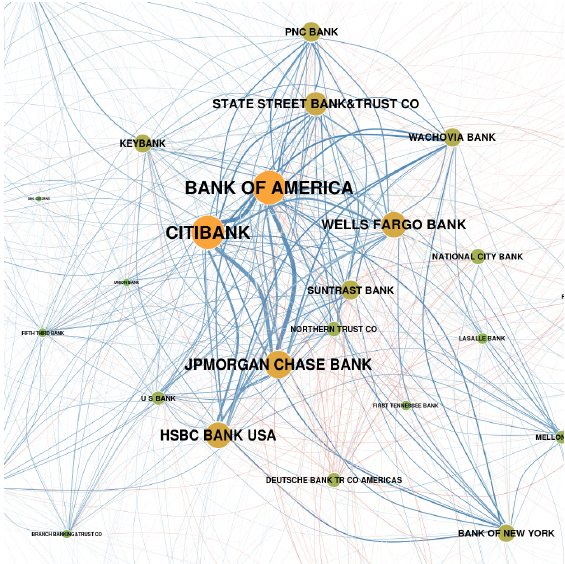
The Network of Counterparty Risk: Analysing Correlations in OTC Derivatives
|
[2015]
|
|
Nanumyan, Vahan;
Garas, Antonios;
Schweitzer, Frank
|
PLOS ONE,
pages: e0136638,
volume: 10
|
more» «less
|
Abstract
Counterparty risk denotes the risk that a party defaults in a bilateral contract. This risk not only depends on the two parties involved, but also on the risk from various other contracts each of these parties holds. In rather informal markets, such as the OTC (over-the-counter) derivative market, institutions only report their aggregated quarterly risk exposure, but no details about their counterparties. Hence, little is known about the diversification of counterparty risk. In this paper, we reconstruct the weighted and time-dependent network of counterparty risk in the OTC derivatives market of the United States between 1998 and 2012. To proxy unknown bilateral exposures, we first study the co-occurrence patterns of institutions based on their quarterly activity and ranking in the official report. The network obtained this way is further analysed by a weighted k-core decomposition, to reveal a core-periphery structure. This allows us to compare the activity-based ranking with a topology-based ranking, to identify the most important institutions and their mutual dependencies. We also analyse correlations in these activities, to show strong similarities in the behavior of the core institutions. Our analysis clearly demonstrates the clustering of counterparty risk in a small set of about a dozen US banks. This not only increases the default risk of the central institutions, but also the default risk of peripheral institutions which have contracts with the central ones. Hence, all institutions indirectly have to bear (part of) the counterparty risk of all others, which needs to be better reflected in the price of OTC derivatives.
Remarks
Find the Supporting Information at DOI:10.1371/journal.pone.0136638.s001

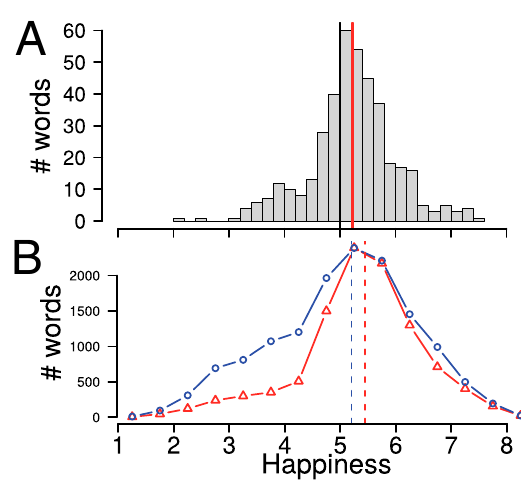
The language-dependent relationship between word happiness and frequency
|
[2015]
|
|
Garcia, David;
Garas, Antonios;
Schweitzer, Frank
|
Proceedings of the National Academy of Sciences,
pages: 201502909,
volume: 112,
number: 23
|
more» «less
|
Abstract
Dodds et al. (1) present a universal positivity bias—in 10 human languages—that they claim is independent of word frequency. This result contradicts previous findings (2, 3) in which a relationship between word happiness and frequency is reported for a variety of languages and large-scale datasets. To better understand this contradiction, we reanalyze the labMT (language assessment by Mechanical Turk) data produced in Dodds et al. (1) against a larger reference lexicon (3). Our reanalysis shows that the data used in Dodds et al. (1) does not support their claims.

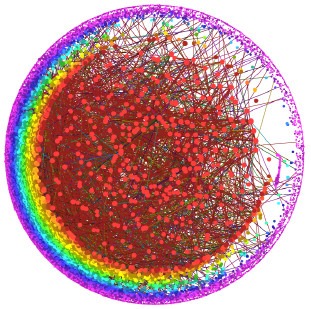
Emotions and Activity Profiles of Influential Users in Product Reviews Communities
|
[2015]
|
|
Tanase, Dorian;
Garcia, David;
Garas, Antonios;
Schweitzer, Frank
|
Frontiers in Physics,
volume: 3,
number: 87
|
more» «less
|
Abstract
Viral marketing seeks to maximize the spread of a campaign
through an online social network, often targeting influential nodes with high
centrality. In this article, we analyze behavioral aspects of influential
users in trust-based product reviews communities, quantifying emotional
expression, helpfulness, and user activity level. We focus on two independent
product review communities, Dooyoo and Epinions, in which
users can write product reviews and define trust links to filter product
recommendations. Following the patterns of social contagion processes, we
measure user social influence by means of the k-shell decomposition of trust
networks. For each of these users, we apply sentiment analysis to extract
their extent of positive, negative, and neutral emotional expression. In
addition, we quantify the level of feedback they received in their reviews,
the length of their contributions, and their level of activity over their
lifetime in the community. We find that users of both communities exhibit a
large heterogeneity of social influence, and that helpfulness votes and age
are significantly better predictors of the influence of an individual than
sentiment. The most active of the analyzed communities shows a particular
structure, in which the inner core of users is qualitatively different from
its periphery in terms of a stronger positive and negative emotional
expression. These results suggest that both objective and subjective aspects
of reviews are relevant to the communication of subjective experience.

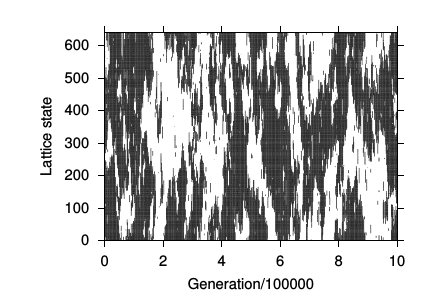
Neighborhood Approximations for Non-Linear Voter Models
|
[2015]
|
|
Schweitzer, Frank;
Behera, Laxmidhar
|
Entropy,
pages: 7658-7679,
volume: 17
|
more» «less
|
Abstract
Non-linear voter models assume that the opinion of an agent depends on the opinions of its neighbors in a non-linear manner. This allows for voting rules different from majority voting. While the linear voter model is known to reach consensus, non-linear voter models can result in the coexistence of opposite opinions. Our aim is to derive approximations to correctly predict the time dependent dynamics, or at least the asymptotic outcome, of such local interactions. Emphasis is on a probabilistic approach to decompose the opinion distribution in a second-order neighborhood into lower-order probability distributions. This is compared with an analytic pair approximation for the expected value of the global fraction of opinions and a mean-field approximation. Our reference case is averaged stochastic simulations of a one-dimensional cellular automaton. We find that the probabilistic second-order approach captures the dynamics of the reference case very well for different non-linearities, i.e., for both majority and minority voting rules, which only partly holds for the first-order pair approximation and not at all for the mean-field approximation. We further discuss the interesting phenomenon of a correlated coexistence, characterized by the formation of large domains of opinions that dominate for some time, but slowly change.

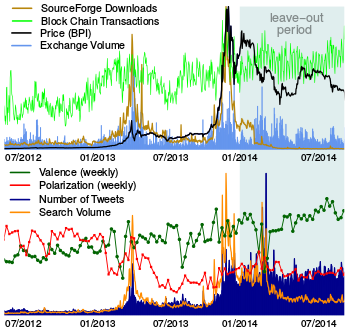
Social signals and algorithmic trading of Bitcoin
|
[2015]
|
|
Garcia, David;
Schweitzer, Frank
|
Royal Society Open Science,
volume: 2,
number: 150288
|
more» «less
|
Abstract
The availability of data on digital traces is growing to unprecedented sizes, but inferring actionable knowledge from large-scale data is far from being trivial. This is especially important for computational finance, where digital traces of human behaviour offer a great potential to drive trading strategies. We contribute to this by providing a consistent approach that integrates various datasources in the design of algorithmic traders. This allows us to derive insights into the principles behind the profitability of our trading strategies. We illustrate our approach through the analysis of Bitcoin, a cryptocurrency known for its large price fluctuations. In our analysis, we include economic signals of volume and price of exchange for USD, adoption of the Bitcoin technology and transaction volume of Bitcoin. We add social signals related to information search, word of mouth volume, emotional valence and opinion polarization as expressed in tweets related to Bitcoin for more than 3 years. Our analysis reveals that increases in opinion polarization and exchange volume precede rising Bitcoin prices, and that emotional valence precedes opinion polarization and rising exchange volumes. We apply these insights to design algorithmic trading strategies for Bitcoin, reaching very high profits in less than a year. We verify this high profitability with robust statistical methods that take into account risk and trading costs, confirming the long-standing hypothesis that trading-based social media sentiment has the potential to yield positive returns on investment.
Remarks
Online visualization at www.sg.ethz.ch/btc


Ideological and Temporal Components of Network Polarization in Online Political Participatory Media
|
[2015]
|
|
Garcia, David;
Abisheva, Adiya;
Schweighofer, Simon;
Serdult, Uwe;
Schweitzer, Frank
|
Policy and Internet,
pages: 46-79,
volume: 7,
number: 1
|
more» «less
|
Abstract
Political polarization is traditionally analyzed through the ideological stances of groups and parties, but it also has a behavioral component that manifests in the interactions between individuals. We present an empirical analysis of the digital traces of politicians in politnetz.ch, a Swiss online platform focused on political activity, in which politicians interact by creating support links, comments, and likes. We analyze network polarization as the level of intra-party cohesion with respect to inter-party connectivity, finding that supports show a very strongly polarized structure with respect to party alignment. The analysis of this multiplex network shows that each layer of interaction contains relevant information, where comment groups follow topics related to Swiss politics. Our analysis reveals that polarization in the layer of likes evolves in time, increasing close to the federal elections of 2011. Furthermore, we analyze the internal social network of each party through metrics related to hierarchical structures, information efficiency, and social resilience. Our results suggest that the online social structure of a party is related to its ideology, and reveal that the degree of connectivity across two parties increases when they are close in the ideological space of a multi-party system.


Sentiment cascades in the 15M movement
|
[2015]
|
|
Alvarez, Raquel;
Garcia, David;
Moreno, Yamir;
Schweitzer, Frank
|
EPJ Data Science,
volume: 4,
number: 6
|
more» «less
|
Abstract
Recent grassroots movements have suggested that online social networks might play a key role in their organization, as adherents have a fast, many-to-many, communication channel to help coordinate their mobilization. The structure and dynamics of the networks constructed from the digital traces of protesters have been analyzed to some extent recently. However, less effort has been devoted to the analysis of the semantic content of messages exchanged during the protest. Using the data obtained from a microblogging service during the brewing and active phases of the 15M movement in Spain, we perform the first large scale test of theories on collective emotions and social interaction in collective actions. Our findings show that activity and information cascades in the movement are larger in the presence of negative collective emotions and when users express themselves in terms related to social content. At the level of individual participants, our results show that their social integration in the movement, as measured through social network metrics, increases with their level of engagement and of expression of negativity. Our findings show that non-rational factors play a role in the formation and activity of social movements through online media, having important consequences for viral spreading.


Communication In Innovation Communities: An Analysis Of 100 Open Source Software Projects
|
[2014]
|
|
Geipel, Markus Michael;
Press, Kerstin;
Schweitzer, Frank
|
ACS - Advances in Complex Systems,
pages: 1550006,
volume: 17,
number: 07n08
|
more» «less
|
Abstract
We develop a model of innovation communities which allows us to address in a systematic way the influence of users and developers as well as communication between and within these groups. Based on this model, we derive a formal approach to quantify communication flows, community activity and community turnover. These measures are calculated using the data of 100 open source software projects. Our empirical analysis shows that: (i) Users play indeed a predominant role in communication, which points towards the vivid role of an active user community; (ii) communication is highly concentrated, which points towards the importance of active individuals and (iii) community turnover exhibits only little correlation with community segregation, which may allow to benefit from high turnover rates while keeping negative effects small. We argue that insight from this extensive analysis not only complements existing case studies, it also provides a reference frame to put these singular results into perspective when aiming at generalizations.

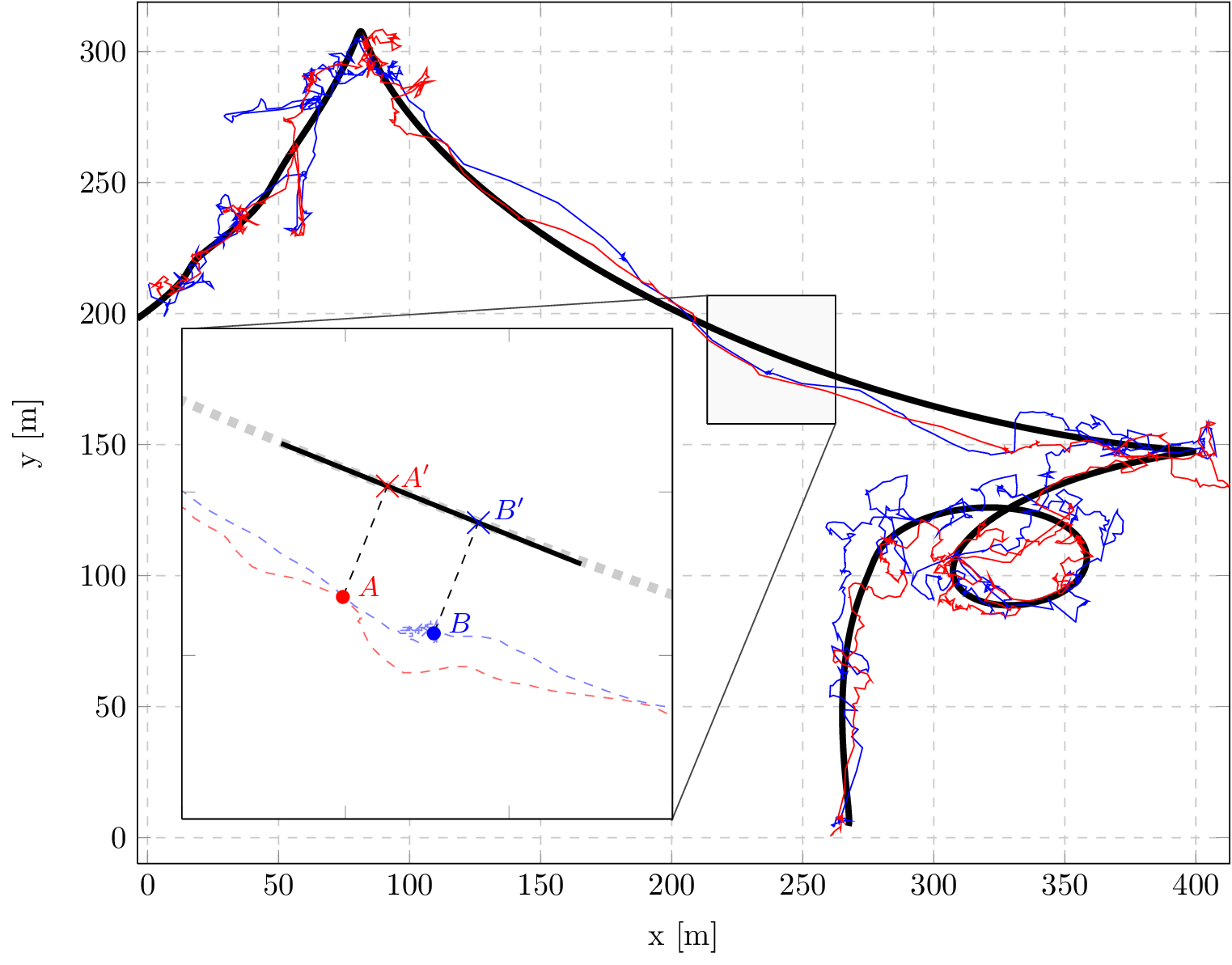
Dynamical coupling during collective animal motion
|
[2014]
|
|
Richardson, Tom O.;
Perony, Nicolas;
Tessone, Claudio Juan;
Bousquet, Christophe A.H.;
Manser, Marta B.;
Schweitzer, Frank
|
Submitted. arXiv:1311.1417
|
more» «less
|
Abstract
The measurement of information flows within moving animal groups has recently been a topic of considerable interest, and it has become clear that the individual(s) that drive collective movement may change over time, and that such individuals may not necessarily always lead from the front. However, methods to quantify the influence of specific individuals on the behaviour of other group members and the direction of information flow in moving group, are lacking on the level of empirical studies and theoretical models. Using high spatio-temporal resolution GPS trajectories of foraging meerkats, Suricata suricatta, we provide an information-theoretic framework to identify dynamical coupling between animals independent of their relative spatial positions. Based on this identification, we then compare designations of individuals as either drivers or responders against designations provided by the relative spatial position. We find that not only does coupling occur both from the frontal to the trailing individuals and vice versa, but also that the coupling direction is a non-linear function of the relative position. This provides evidence for (i) intermittent fluctuation of the coupling strength and (ii) alternation in the coupling direction within foraging meerkat pairs. The framework we introduce allows for a detailed description of the dynamical patterns of mutual influence between all pairs of individuals within moving animal groups. We argue that applying an information-theoretic perspective to the study of coordinated phenomena in animal groups will eventually help to understand cause and effect in collective behaviour.

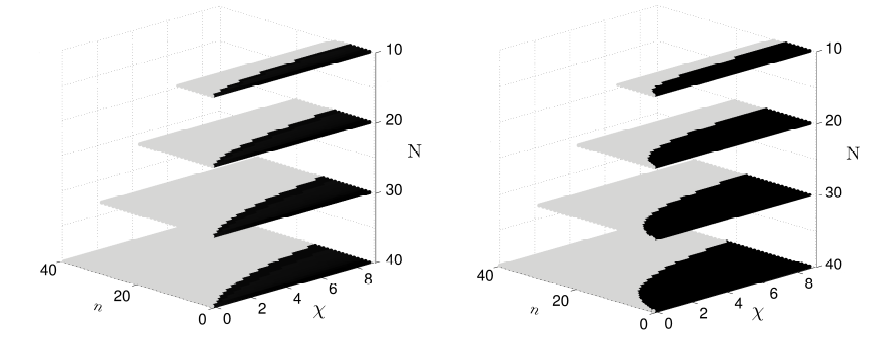
Quantifying the Impact of Leveraging and Diversification on Systemic Risk
|
[2014]
|
|
Tasca, Paolo;
Mavrodiev, Pavlin;
Schweitzer, Frank
|
Journal of Financial Stability,
pages: 43-52,
volume: 15,
number: 0
|
more» «less
|
Abstract
The excessive increase of leverage, i.e. the abuse of debt financing, is considered one of the primary factors in the default of financial institutions since it amplifies potential investment losses. On the other side, portfolio diversification acts to mitigate these losses. Systemic risk results from correlations between individual default probabilities that cannot be considered independent. Based on the structural framework by Merton (1974), we propose a model in which these correlations arise from overlaps in banks’ portfolios. Our main result is the finding of a critical level of diversification that separates two regimes: (i) a safe regime in which a properly chosen diversification strategy offsets the higher systemic risk engendered by increased leverage and (ii) a risky regime in which an inadequate diversification strategy and/or adverse market conditions, such as market size, market volatility and time horizon, cannot compensate the same increase in leverage. Our results are of relevance for financial regulators especially because the critical level of diversification may not coincide with the one that is individually optimal.

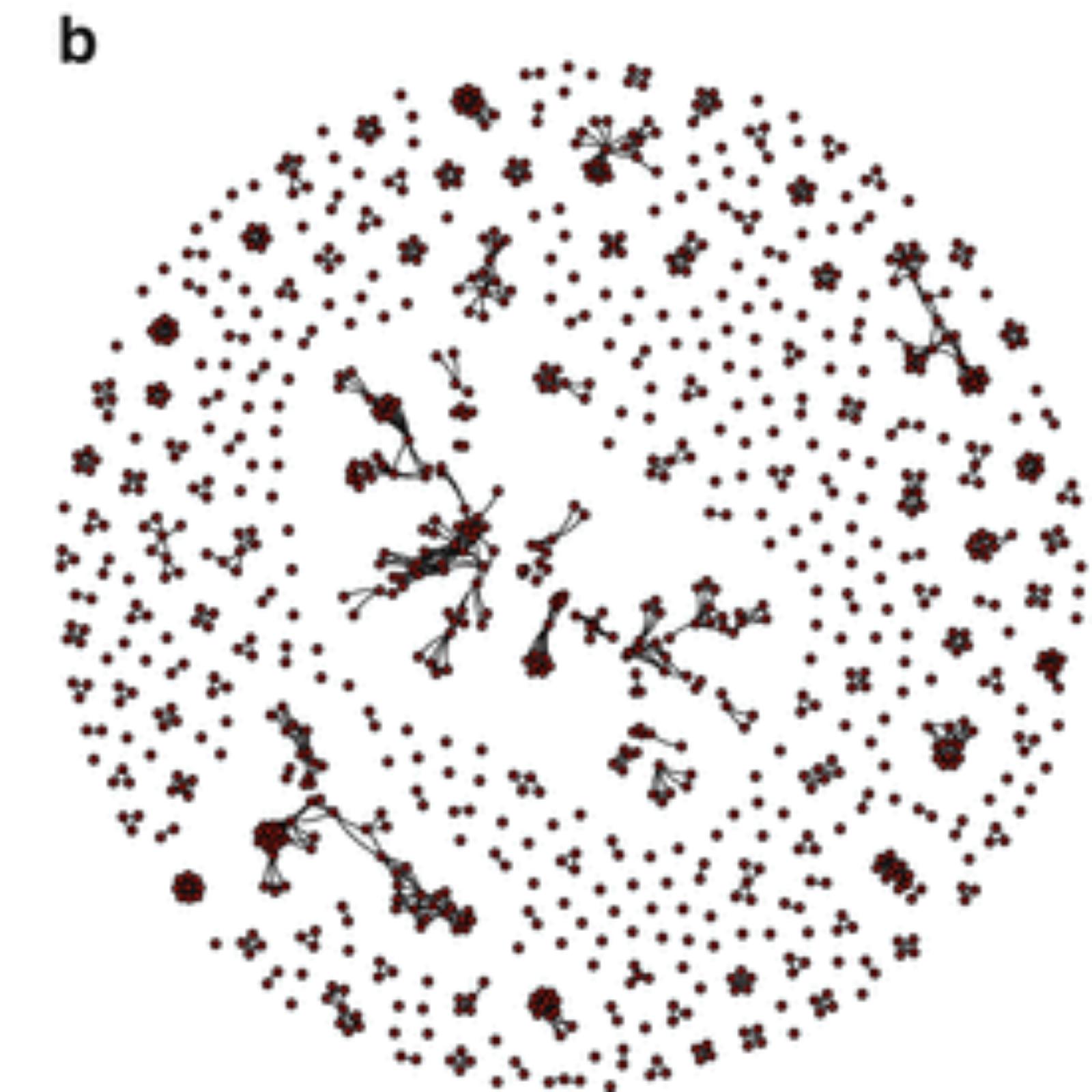
The Social Dimension of Information Ranking: A Discussion of Research Challenges and Approaches
|
[2014]
|
|
Schweitzer, Frank;
Scholtes, Ingo;
Pfitzner, Rene
|
Socioinformatics - The Social Impact of Interactions between Humans and IT
|
more» «less
|
Abstract
The extraction of relevant knowledge from the increasingly large amount
of information available in information repositories is one of the big challenges of our
time. Although it is clear that the social and the information layer of collaborative
knowledge spaces like the World Wide Web (WWW), scholarly publication databases
or Online Social Networks (OSNs) are inherently coupled and thus inseparable, the
question how the ranking and retrieval of information is influenced by the structure
and dynamics of the social systems that create it has been addressed at most partially.
In this talk, we will highlight associated research questions and challenges from an
ethical, social and computer science perspective and introduce a multiplex network
perspective that integrates both the social and the semantic layer of social information
systems.

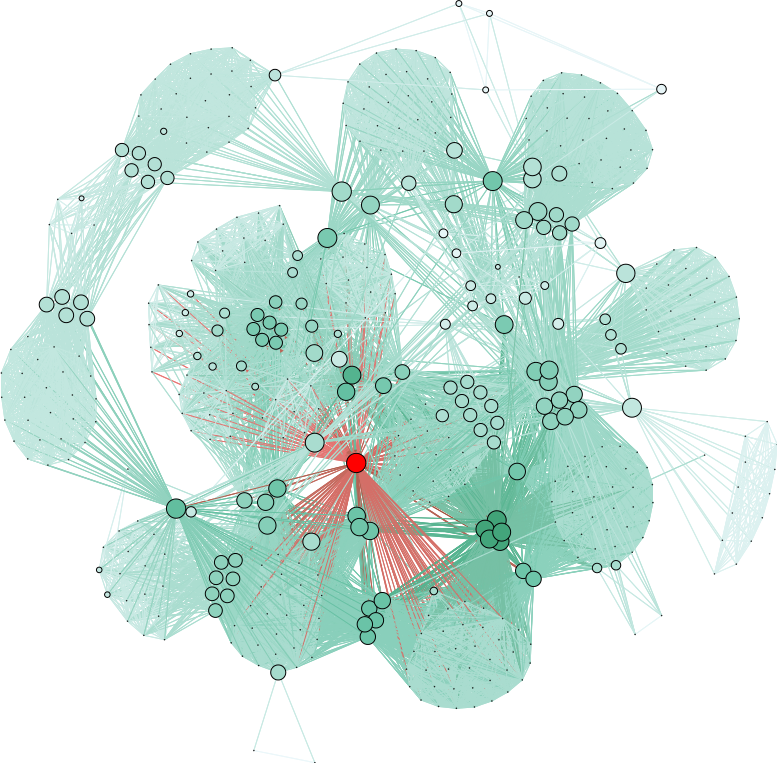
Predicting Scientific Success Based on Coauthorship Networks
|
[2014]
|
|
Sarigol, Emre;
Pfitzner, Rene;
Scholtes, Ingo;
Garas, Antonios;
Schweitzer, Frank
|
EPJ Data Science,
pages: 9,
volume: 3
|
more» «less
|
Abstract
We address the question to what extent the success of scientific articles is due to social influence. Analyzing a data set of over 100000 publications from the field of Computer Science, we study how centrality in the coauthorship network differs between authors who have highly cited papers and those who do not. We further show that a machine learning classifier, based only on coauthorship network centrality measures at time of publication, is able to predict with high precision whether an article will be highly cited five years after publication. By this we provide quantitative insight into the social dimension of scientific publishing - challenging the perception of citations as an objective, socially unbiased measure of scientific success.

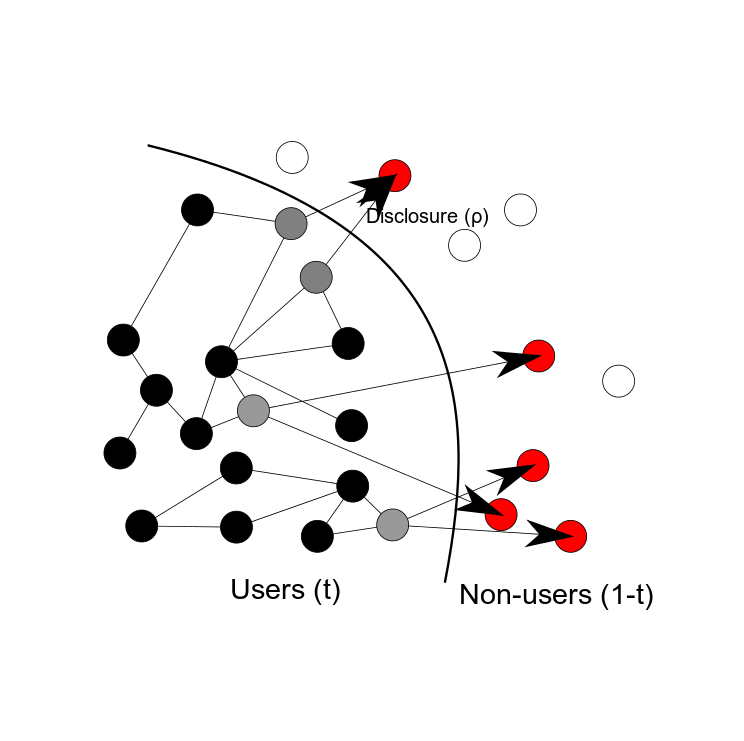
Online Privacy as a Collective Phenomenon
|
[2014]
|
|
Sarigol, Emre;
Garcia, David;
Schweitzer, Frank
|
In Proceedings of the 2nd Conference on Online Social Networks 2014,
pages: 95-105
|
more» «less
|
Abstract
The problem of online privacy is often reduced to individual decisions to hide or reveal personal information in online social networks (OSNs). However, with the increasing use of OSNs, it becomes more important to understand the role of the social network in disclosing personal information that a user has not revealed voluntarily: How much of our private information do our friends disclose about us, and how much of our privacy is lost simply because of online social interaction? Without strong technical effort, an OSN may be able to exploit the assortativity of human private features, this way constructing shadow profiles with information that users chose not to share. Furthermore, because many users share their phone and email contact lists, this allows an OSN to create full shadow profiles for people who do not even have an account for this OSN. We empirically test the feasibility of constructing shadow profiles of sexual orientation for users and non-users, using data from more than 3 Million accounts of a single OSN. We quantify a lower bound for the predictive power derived from the social network of a user, to demonstrate how the predictability of sexual orientation increases with the size of this network and the tendency to share personal information. This allows us to define a privacy leak factor that links individual privacy loss with the decision of other individuals to disclose information. Our statistical analysis reveals that some individuals are at a higher risk of privacy loss, as prediction accuracy increases for users with a larger and more homogeneous first-and second-order neighborhood of their social network. While we do not provide evidence that shadow profiles exist at all, our results show that disclosing of private information is not restricted to an individual choice, but becomes a collective decision that has implications for policy and privacy regulation.

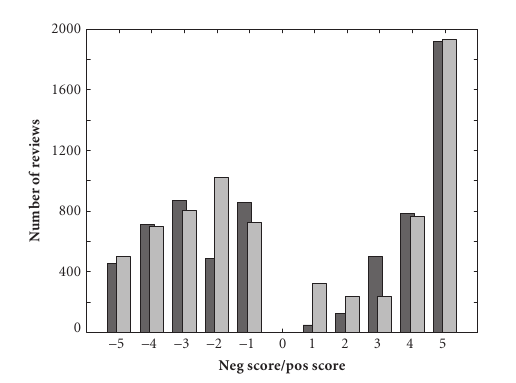
Modeling collective emotions in online social systems
|
[2014]
|
|
Garcia, David;
Garas, Antonios;
Schweitzer, Frank
|
Collective Emotions
|
more» «less
|
Abstract
Every day, millions of Internet users leave online traces that are publicly accessible. Data
about forum comments, video downloads, or product reviews provide a valuable insight
into human online behavior. The retrieval of datasets of unprecedented size may eventu-
ally also allow testing of hypotheses or validation of theories that have been developed in
the social sciences, for example, about preferences, social influence (Lorenz, 2009; Onnela
& Reed-Tsochas, 2010), trust, and cooperation (Walter, Battiston, Yildirim, & Schweitzer,
2011). This recent scientific development has led to the emerging field of computational
social science (Lazer et al., 2009) which combines methods and tools from different tech-
nical and social disciplines. Also, psychology can benefit from this development by get-
ting access to data without designing expensive experimental setups of limited size. For
example, the analysis of Twitter messages allows studying the influence of the circadian
cycles on human mood (Golder & Macy, 2011), and sentiment analysis of large-scale
datasets reveals patterns of emotional expression predicted by earlier theories (Garcia,
Garas, & Schweitzer, 2012).

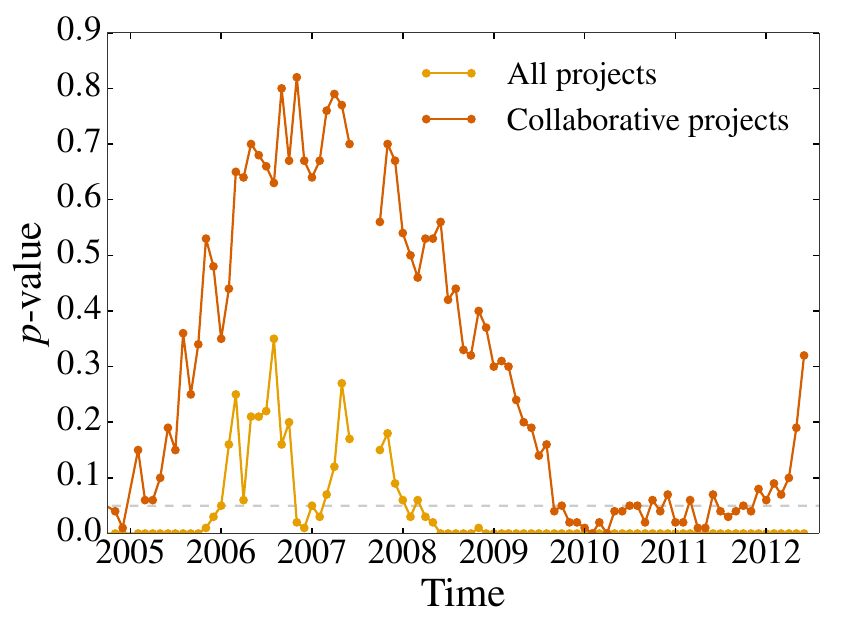
How do OSS projects change in number and size? A large-scale analysis to test a model of project growth
|
[2014]
|
|
Schweitzer, Frank;
Nanumyan, Vahan;
Tessone, Claudio Juan;
Xia, Xi
|
ACS - Advances in Complex Systems,
pages: 1550008,
volume: 17,
number: 07n08
|
more» «less
|
Abstract
Established open source software (OSS) projects can grow in size if new developers join, but also the number of OSS projects can grow if developers choose to found new projects. We discuss to what extent an established model for firm growth can be applied to the dynamics of OSS projects. Our analysis is based on a large-scale data set from SourceForge (SF) consisting of monthly data for 10 years, for up to 360,000 OSS projects and up to 340,000 developers. Over this time period, we find an exponential growth both in the number of projects and developers, with a remarkable increase of single-developer projects after 2009. We analyze the monthly entry and exit rates for both projects and developers, the growth rate of established projects and the monthly project size distribution. To derive a prediction for the latter, we use modeling assumptions of how newly entering developers choose to either found a new project or to join existing ones. Our model applies only to collaborative projects that are deemed to grow in size by attracting new developers. We verify, by a thorough statistical analysis, that the Yule–Simon distribution is a valid candidate for the size distribution of collaborative projects except for certain time periods where the modeling assumptions no longer hold. We detect and empirically test the reason for this limitation, i.e., the fact that an increasing number of established developers found additional new projects after 2009.

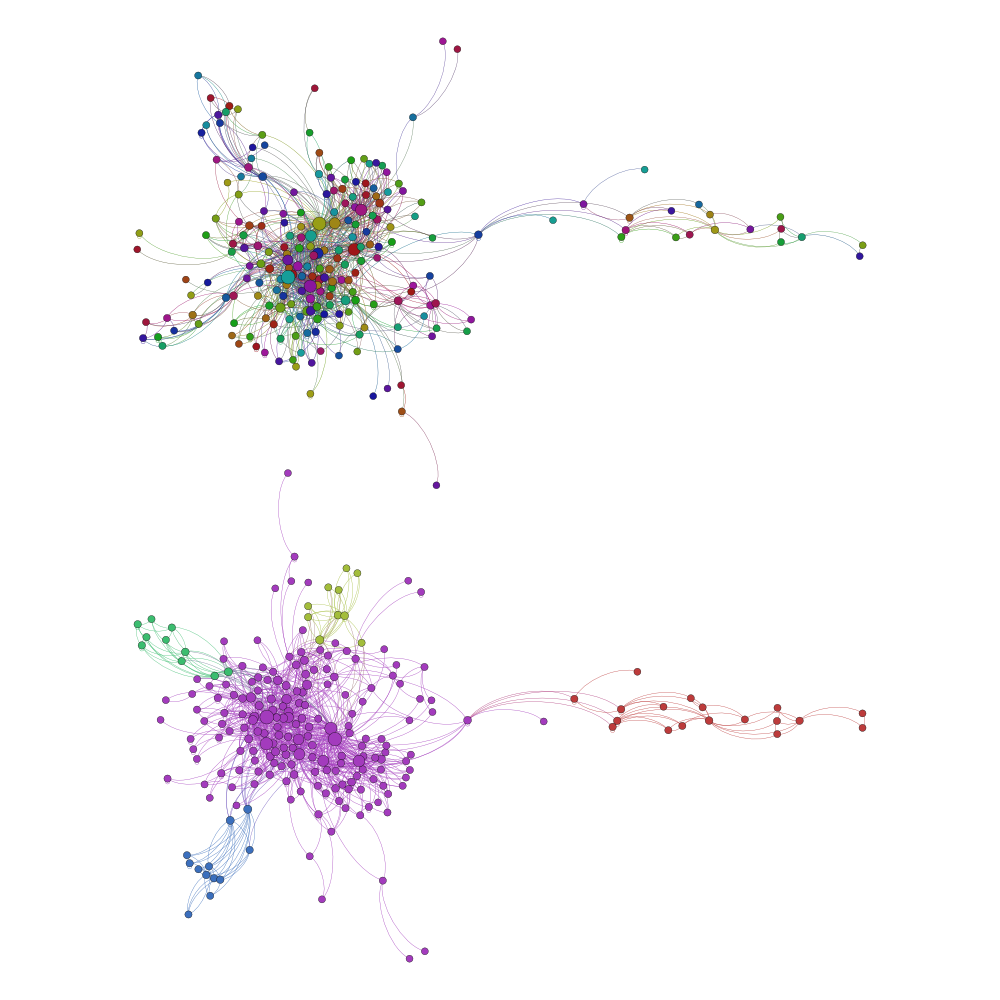
Automated Software Remodularization Based on Move Refactoring
|
[2014]
|
|
Zanetti, Marcelo Serrano;
Tessone, Claudio Juan;
Scholtes, Ingo;
Schweitzer, Frank
|
In Proceedings of the 13th International Conference on Modularity 2014,
pages: 73-84
|
more» «less
|
Abstract
Modular design is a desirable characteristic of complex software systems that can significantly improve their comprehensibility, maintainability and thus quality. While many software systems are initially created in a modular way, over time modularity typically degrades as components are reused outside the context where they were created. In this paper, we propose an automated strategy to remodularize software based on move refactoring, i.e. moving classes between packages without changing any other aspect of the source code. Taking a complex systems perspective, our approach is based on complex networks theory applied to the dynamics of software modular structures and its relation to an n-state spin model known as the Potts Model. In our approach, nodes are probabilistically moved between modules with a probability that nonlinearly depends on the number and module membership of their adjacent neighbors. The latter are defined by the underlying network of software dependencies. To validate our method, we apply it to a dataset of 39 Java open source projects in order to optimize their modularity. Comparing the source code generated by the developers with the optimized code resulting from our approach, we find that modularity (i.e. quantified in terms of a standard measure from the study of complex networks) improves on average by 166+-77 percent. In order to facilitate the application of our method in practical studies, we provide a freely available Eclipse plug-in.

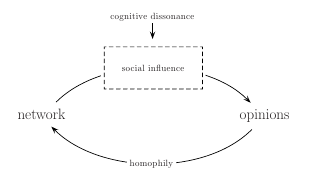
Dissonance minimization as a microfoundation of social influence in models of opinion formation
|
[2014]
|
|
Groeber, Patrick;
Lorenz, Jan;
Schweitzer, Frank
|
The Journal of Mathematical Sociology,
pages: 147-174,
volume: 38,
number: 3
|
more» «less
|
Abstract
Models of opinion formation are used to investigate many collective phenomena. While social influence often constitutes a basic mechanism, its implementation differs between the models. In this paper, we provide a general framework of social influence inspired by the social psychological concept of cognitive dissonance.We only premise that individuals strive to minimize dissonance resulting from different opinions compared to neighbor individuals in a given social network. Within a game theoretic context, we show that our concept of dissonance reduction exhibits the basic properties of a coordination process. We further show that different models of opinion formation can be represented as best response dynamics within our general framework. Thus, we offer a unifying perspective on heterogeneous models and link them to rational choice theory.
Editorial: Scientific networks and success in science
|
[2014]
|
|
Schweitzer, Frank
|
EPJ Data Science,
volume: 3,
number: 35
|
more» «less
|

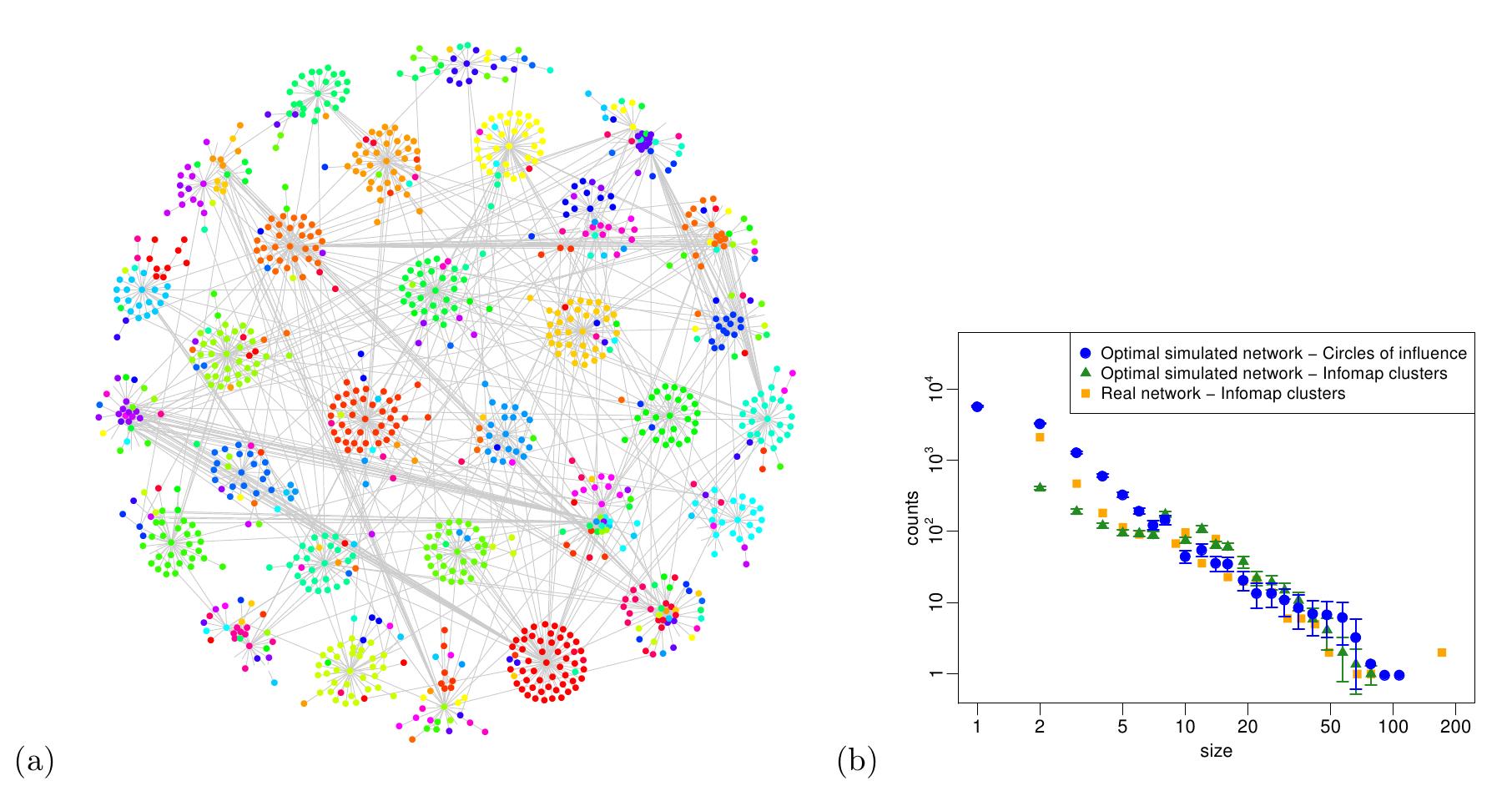
The Role of Endogenous and Exogenous Mechanisms in the Formation of R&D Networks
|
[2014]
|
|
Tomasello, Mario Vincenzo;
Perra, Nicola;
Tessone, Claudio Juan;
Karsai, M'arton;
Schweitzer, Frank
|
Scientific Reports,
pages: 5679,
volume: 4
|
more» «less
|
Abstract
We develop an agent-based model of strategic link formation in Research and Development (R&D) networks. Empirical evidence has shown that the growth of these networks is driven by mechanisms which are both endogenous to the system (that is, depending on existing alliances patterns) and exogenous (that is, driven by an exploratory search for newcomer firms). Extant research to date has not investigated both mechanisms simultaneously in a comparative manner. To overcome this limitation, we develop a general modeling framework to shed light on the relative importance of these two mechanisms. We test our model against a comprehensive dataset, listing cross-country and cross-sectoral R&D alliances from 1984 to 2009. Our results show that by fitting only three macroscopic properties of the network topology, this framework is able to reproduce a number of micro-level measures, including the distributions of degree, local clustering, path length and component size, and the emergence of network clusters. Furthermore, by estimating the link probabilities towards newcomers and established firms from the data, we find that endogenous mechanisms are predominant over the exogenous ones in the network formation, thus quantifying the importance of existing structures in selecting partner firms.

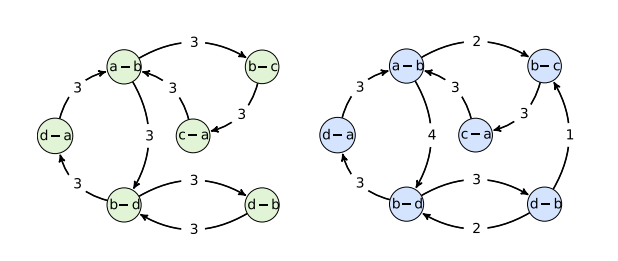
Causality-driven slow-down and speed-up of diffusion in non-Markovian temporal networks
|
[2014]
|
|
Scholtes, Ingo;
Wider, Nicolas;
Pfitzner, Rene;
Garas, Antonios;
Tessone, Claudio Juan;
Schweitzer, Frank
|
Nature Communications,
pages: 5024,
volume: 5
|
more» «less
|
Abstract
Recent research has highlighted limitations of studying complex systems with time-varying topologies from the perspective of static, time-aggregated networks. Non-Markovian characteristics resulting from the ordering of interactions in temporal networks were identified as one important mechanism that alters causality and affects dynamical processes. So far, an analytical explanation for this phenomenon and for the significant variations observed across different systems is missing. Here we introduce a methodology that allows to analytically predict causality-driven changes of diffusion speed in non-Markovian temporal networks. Validating our predictions in six data sets we show that compared with the time-aggregated network, non-Markovian characteristics can lead to both a slow-down or speed-up of diffusion, which can even outweigh the decelerating effect of community structures in the static topology. Thus, non-Markovian properties of temporal networks constitute an important additional dimension of complexity in time-varying complex systems.


How can social herding enhance cooperation?
|
[2013]
|
|
Schweitzer, Frank;
Mavrodiev, Pavlin;
Tessone, Claudio Juan
|
ACS - Advances in Complex Systems,
pages: 1350017-1-1350017-22,
volume: 16
|
more» «less
|
Abstract
We study a system in which N agents have to decide between two strategies θ_(i) (i ∈ 1... N), for defection or cooperation, when interacting with other n agents (either spatial neighbors or randomly chosen ones). After each round, they update their strategy responding nonlinearly to two different information sources: (i) the payoff a_(i)(θ_(i), f_(i)) received from the strategic interaction with their n counterparts, (ii) the fraction f_(i) of cooperators in this interaction. For the latter response, we assume social herding, i.e. agents adopt their strategy based on the frequencies of the different strategies in their neighborhood, without taking into account the consequences of this decision. We note that f_(i) already determines the payoff, so there is no additional information assumed. A parameter ζ defines to what level agents take the two different information sources into account. For the strategic interaction, we assume a Prisoner's Dilemma game, i.e. one in which defection is the evolutionary stable strategy. However, if the additional dimension of social herding is taken into account, we find instead a stable outcome where cooperators are the majority. By means of agent-based computer simulations and analytical investigations, we evaluate the critical conditions for this transition towards cooperation. We find that, in addition to a high degree of social herding, there has to be a nonlinear response to the fraction of cooperators. We argue that the transition to cooperation in our model is based on less information, i.e. on agents which are not informed about the payoff matrix, and therefore rely on just observing the strategy of others, to adopt it. By designing the right mechanisms to respond to this information, the transition to cooperation can be remarkably enhanced.


Enhancing consensus under opinion bias by means of hierarchical decision making
|
[2013]
|
|
Perony, Nicolas;
Pfitzner, Rene;
Scholtes, Ingo;
Tessone, Claudio Juan;
Schweitzer, Frank
|
ACS - Advances in Complex Systems,
pages: 1350020,
volume: 16
|
more» «less
|
Abstract
We study the role of hierarchical structures in a simple model of collective consensus formation based on the bounded confidence model with continuous individual opinions. For the particular variation of this model considered in this paper, we assume that a bias towards an extreme opinion is introduced whenever two individuals interact and form a common decision. As a simple proxy for hierarchical social structures, we introduce a two-step decision making process in which in the second step groups of like-minded individuals are replaced by representatives once they have reached local consensus, and the representatives in turn form a collective decision in a downstream process. We find that the introduction of such a hierarchical decision making structure can improve consensus formation, in the sense that the eventual collective opinion is closer to the true average of individual opinions than without it. In particular, we numerically study how the size of groups of like-minded individuals being represented by delegate individuals affects the impact of the bias on the final population-wide consensus. These results are of interest for the design of organisational policies and the optimisation of hierarchical structures in the context of group decision making.

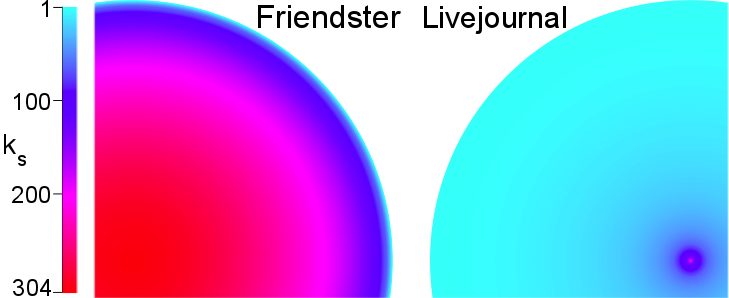
Social resilience in online communities: The autopsy of Friendster
|
[2013]
|
|
Garcia, David;
Mavrodiev, Pavlin;
Schweitzer, Frank
|
Proceedings of the 1st ACM Conference in Online Social Networks (COSN'13),
pages: 39-50
|
more» «less
|
Abstract
We empirically analyze five online communities: Friendster, Livejournal, Facebook, Orkut, Myspace, to identify causes for the decline of social networks. We define social resilience as the ability of a community to withstand changes. We do not argue about the cause of such changes, but concentrate on their impact. Changes may cause users to leave, which may trigger further leaves of others who lost connection to their friends. This may lead to cascades of users leaving. A social network is said to be resilient if the size of such cascades can be limited. To quantify resilience, we use the k-core analysis, to identify subsets of the network in which all users have at least k friends. These connections generate benefits (b) for each user, which have to outweigh the costs (c) of being a member of the network. If this difference is not positive, users leave. After all cascades, the remaining network is the k-core of the original network determined by the cost-to-benefit c/b ratio. By analysing the cumulative distribution of k-cores we are able to calculate the number of users remaining in each community. This allows us to infer the impact of the c/b ratio on the resilience of these online communities. We find that the different online communities have different k-core distributions. Consequently, similar changes in the c/b ratio have a different impact on the amount of active users. As a case study, we focus on the evolution of Friendster. We identify time periods when new users entering the network observed an insufficient c/b ratio. This measure can be seen as a precursor of the later collapse of the community. Our analysis can be applied to estimate the impact of changes in the user interface, which may temporarily increase the c/b ratio, thus posing a threat for the community to shrink, or even to collapse.

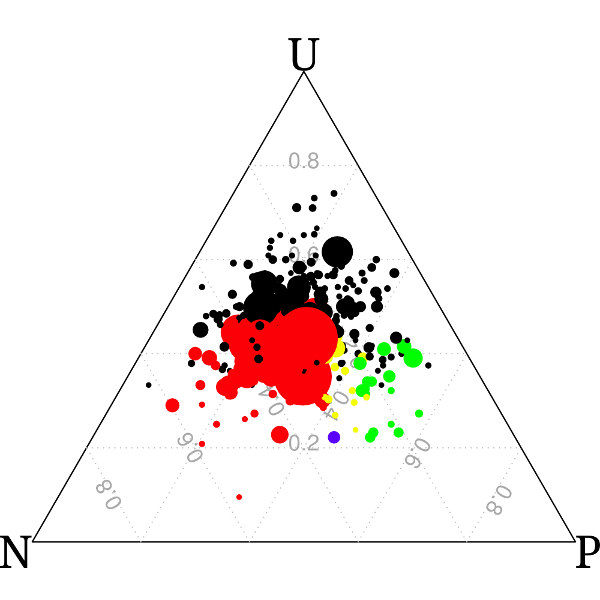
The Role of Emotions in Contributors Activity: A Case Study of the Gentoo Community
|
[2013]
|
|
Garcia, David;
Zanetti, Marcelo Serrano;
Schweitzer, Frank
|
In Proceedings of the International Conference on Social Computing and Its Applications,
pages: 410-417
|
more» «less
|
Abstract
We analyse the relation between the emotions and the activity of contributors in the Open Source Software project Gentoo. Our case study builds on extensive data sets from the project's bug tracking platform Bugzilla, to quantify the activity of contributors, and its mail archives, to quantify the emotions of contributors by means of sentiment analysis. The Gentoo project is known for a considerable drop in development performance after the sudden retirement of a central contributor. We analyse how this event correlates with the negative emotions, both in bilateral email discussions with the central contributor, and at the level of the whole community of contributors. We then extend our study to consider the activity patters on Gentoo contributors in general. We find that contributors are more likely to become inactive when they express strong positive or negative emotions in the bug tracker, or when they deviate from the expected value of emotions in the mailing list. We use these insights to develop a Bayesian classifier that detects the risk of contributors leaving the project. Our analysis opens new perspectives for measuring online contributor motivation by means of sentiment analysis and for real-time predictions of contributor turnover in Open Source Software projects.

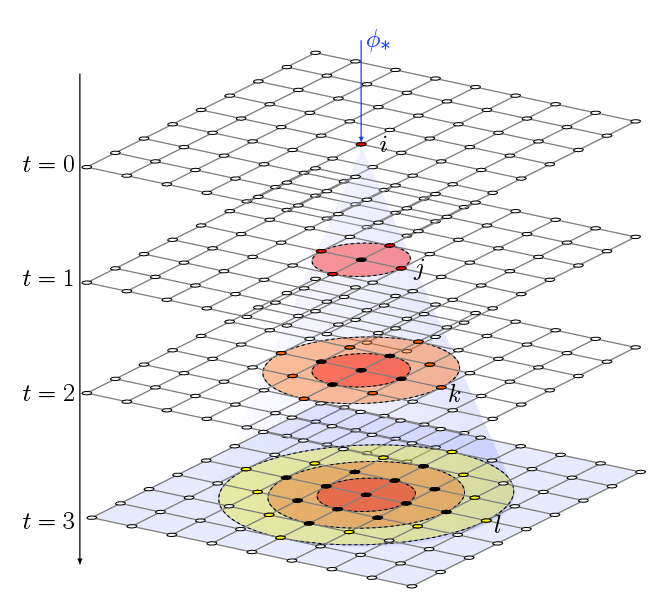
How big is too big? Critical shocks for systemic failure cascades
|
[2013]
|
|
Tessone, Claudio Juan;
Garas, Antonios;
Guerra, Beniamino;
Schweitzer, Frank
|
Journal of Statistical Physics,
pages: 765-783,
volume: 151,
number: 3
|
more» «less
|
Abstract
External or internal shocks may lead to the collapse of a system consisting of many agents. If the shock hits only one agent initially and causes it to fail, this can induce a cascade of failures among neighoring agents. Several critical constellations determine whether this cascade remains finite or reaches the size of the system, i.e. leads to systemic risk. We investigate the critical parameters for such cascades in a simple model, where agents are characterized by an individual threshold $$theta_i determining their capacity to handle a load $$alpha$$theta_i with 1-$$alpha being their safety margin. If agents fail, they redistribute their load equally to K neighboring agents in a regular network. For three different threshold distributions P($$theta), we derive analytical results for the size of the cascade, X(t), which is regarded as a measure of systemic risk, and the time when it stops. We focus on two different regimes, (i) EEE, an external extreme event where the size of the shock is of the order of the total capacity of the network, and (ii) RIE, a random internal event where the size of the shock is of the order of the capacity of an agent. We find that even for large extreme events that exceed the capacity of the network finite cascades are still possible, if a power-law threshold distribution is assumed. On the other hand, even small random fluctuations may lead to full cascades if critical conditions are met. Most importantly, we demonstrate that the size of the "big" shock is not the problem, as the systemic risk only varies slightly for changes of 10 to 50 percent of the external shock. Systemic risk depends much more on ingredients such as the network topology, the safety margin and the threshold distribution, which gives hints on how to reduce systemic risk.


Categorizing bugs with social networks: A case study on four open source software communities
|
[2013]
|
|
Zanetti, Marcelo Serrano;
Scholtes, Ingo;
Tessone, Claudio Juan;
Schweitzer, Frank
|
In Proceedings of the International Conference on Software Engineering,
pages: 1032-1041
|
more» «less
|
Abstract
Efficient bug triaging procedures are an important precondition for successful collaborative software engineering projects. Triaging bugs can become a laborious task particularly in open source software (OSS) projects with a large base of comparably inexperienced part-time contributors. In this paper, we propose an efficient and practical method to identify valid bug reports which a) refer to an actual software bug, b) are not duplicates and c) contain enough information to be processed right away. Our classification is based on nine measures to quantify the social embeddedness of bug reporters in the collaboration network. We demonstrate its applicability in a case study, using a comprehensive data set of more than 700, 000 bug reports obtained from the BUGZILLA installation of four major OSS communities, for a period of more than ten years. For those projects that exhibit the lowest fraction of valid bug reports, we find that the bug reporters’ position in the collaboration network is a strong indicator for the quality of bug reports. Based on this finding, we develop an automated classification scheme that can easily be integrated into bug tracking platforms and analyze its performance in the considered OSS communities. A support vector machine (SVM) to identify valid bug reports based on the nine measures yields a precision of up to 90.3% with an associated recall of 38.9%. With this, we significantly improve the results obtained in previous case studies for an automated early identification of bugs that are eventually fixed. Furthermore, our study highlights the potential of using quantitative measures of social organization in collaborative software engineering. It also opens a broad perspective for the integration of social network analysis in the design of support infrastructures.

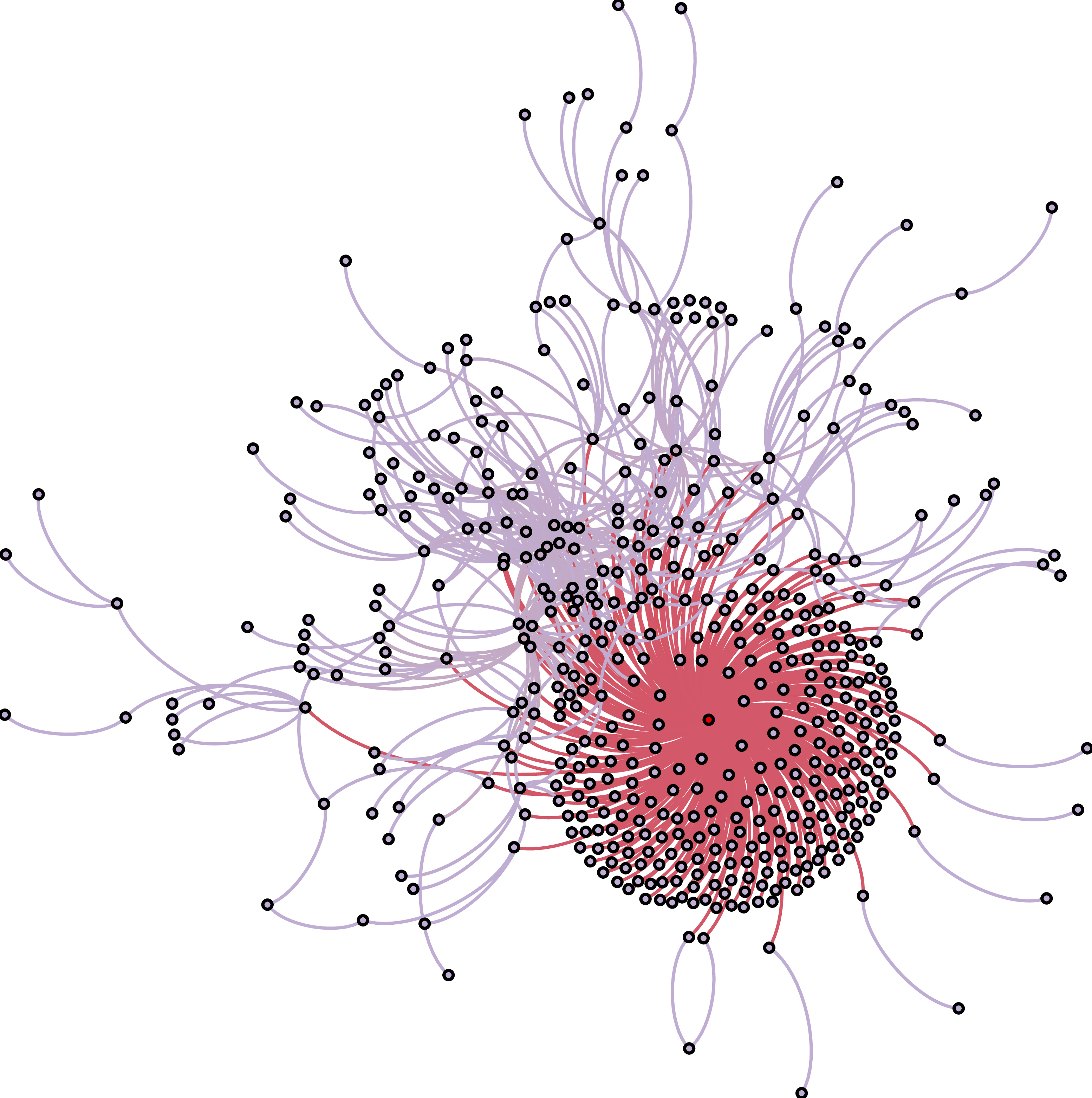
The rise and fall of a central contributor: Dynamics of social organization and performance in the Gentoo community
|
[2013]
|
|
Zanetti, Marcelo Serrano;
Scholtes, Ingo;
Tessone, Claudio Juan;
Schweitzer, Frank
|
In Proceedings of the International Workshop on Cooperative and Human Aspects of Software Engineering,
pages: 49-56
|
more» «less
|
Abstract
Social organization and division of labor crucially influence the performance of collaborative software engineering efforts. In this paper, we provide a quantitative analysis of the relation between social organization and performance in Gentoo, an Open Source community developing a Linux distribution. We study the structure and dynamics of collaborations as recorded in the project's bug tracking system over a period of ten years. We identify a period of increasing centralization after which most interactions in the community were mediated by a single central contributor. In this period of maximum centralization, the central contributor unexpectedly left the project, thus posing a significant challenge for the community. We quantify how the rise, the activity as well as the subsequent sudden dropout of this central contributor affected both the social organization and the bug handling performance of the Gentoo community. We analyze social organization from the perspective of network theory and augment our quantitative findings by interviews with prominent members of the Gentoo community which shared their personal insights.

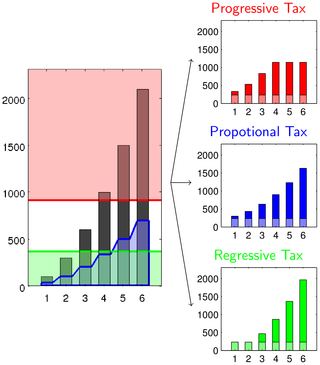
Redistribution spurs growth by using a portfolio effect on risky human capital
|
[2013]
|
|
Lorenz, Jan;
Paetzel, Fabian;
Schweitzer, Frank
|
PLOS ONE,
pages: e54904,
volume: 8,
number: 2
|
more» «less
|
Abstract
We demonstrate by mathematical analysis and systematic computer simulations that redistribution can lead to sustainable growth in a society. In accordance with economic models of risky human capital, we assume that dynamics of human capital is modeled as a multiplicative stochastic process which, in the long run, leads to the destruction of individual human capital. When agents are linked by fully redistributive taxation the situation might turn to individual growth in the long run. We consider that a government collects a proportion of income and reduces it by a fraction as costs for administration (efficiency losses). The remaining public good is equally redistributed to all agents. Sustainable growth is induced by redistribution despite the losses from the random growth process and despite administrative costs. Growth results from a portfolio effect. The findings are verified for three different tax schemes: proportional tax, taking proportionally more from the rich, and proportionally more from the poor. We discuss which of these tax schemes performs better with respect to maximize growth under a fixed rate of administrative costs, and the governmental income. This leads us to general conclusions about governmental decisions, the relation to public good games with free riding, and the function of taxation in a risk-taking society.

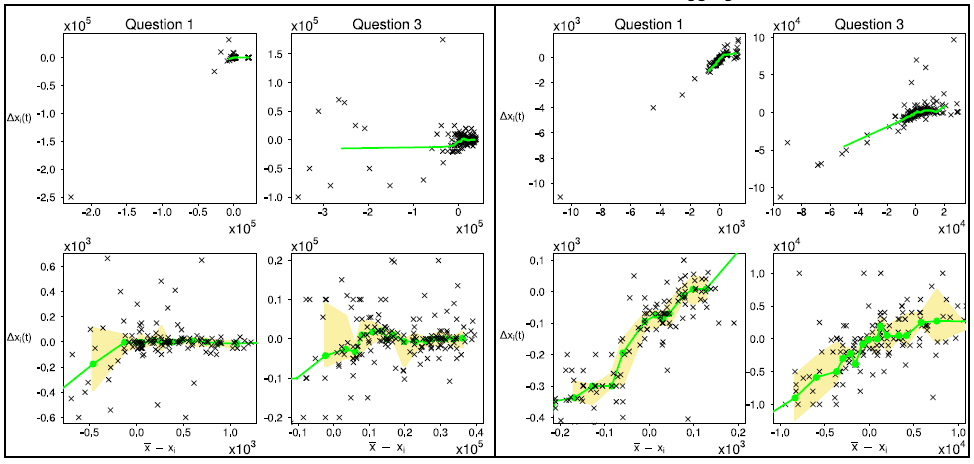
Quantifying the effects of social influence
|
[2013]
|
|
Mavrodiev, Pavlin;
Tessone, Claudio Juan;
Schweitzer, Frank
|
Scientific Reports,
volume: 3,
number: 1360
|
more» «less
|
Abstract
How do humans respond to indirect social influence when making decisions? We analysed an experiment where subjects had to repeatedly guess the correct answer to factual questions, while having only aggregated information about the answers of others. While the response of humans to aggregated information is a widely observed phenomenon, it has not been investigated quantitatively, in a controlled setting. We found that the adjustment of individual guesses depends linearly on the distance to the mean of all guesses. This is a remarkable, and yet surprisingly simple, statistical regularity. It holds across all questions analysed, even though the correct answers differ in several orders of magnitude. Our finding supports the assumption that individual diversity does not affect the response to indirect social influence. It also complements previous results on the nonlinear response in information-rich scenarios. We argue that the nature of the response to social influence crucially changes with the level of information aggregation. This insight contributes to the empirical foundation of models for collective decisions under social influence.

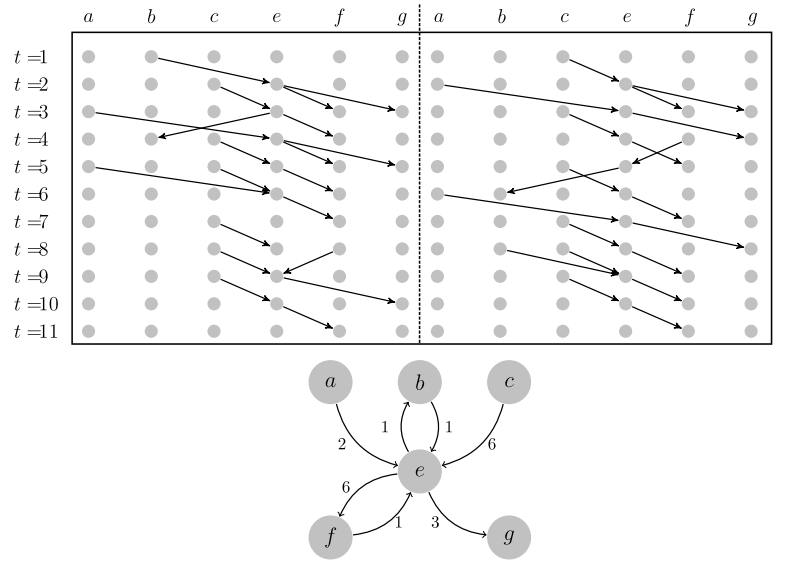
Betweenness preference: Quantifying correlations in the topological dynamics of temporal networks
|
[2013]
|
|
Pfitzner, Rene;
Scholtes, Ingo;
Garas, Antonios;
Tessone, Claudio Juan;
Schweitzer, Frank
|
Physical Review Letters,
pages: 198701,
volume: 110,
number: 19
|
more» «less
|
Abstract
Time-evolving interaction patterns studied in different contexts can be well represented bytemporal networks in which nodes are intermittently connected. In this Letter we introducethe notion of betweenness preference in the study of temporal networks. It captures how likelya certain node is to mediate interactions between particular pairs of its neighboring nodes.We argue that betweenness preference is an important correlation to consider in the analysisof temporal network data. In particular, it allows to assess to which extent paths existing intime-aggregated, static representations of temporal networks are actually feasible based onthe underlying sequence of interactions. We argue that betweenness preference correlationsare present in empirical data sets. We further show that neglecting betweenness preferencewill lead to significantly wrong statements about spreading dynamics in temporal networks.

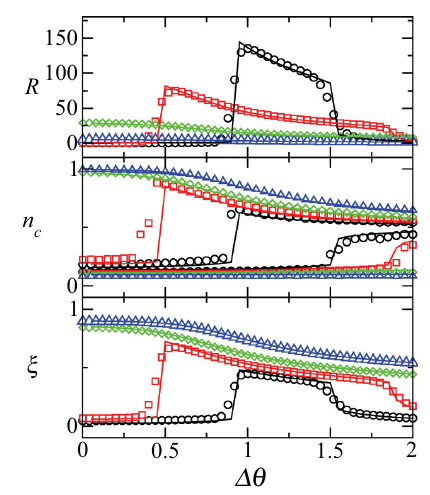
Diversity-induced resonance in the response to social norms
|
[2013]
|
|
Tessone, Claudio Juan;
Sanchez, Anxo;
Schweitzer, Frank
|
Physical Review E,
pages: 022803,
volume: 87
|
more» «less
|
Abstract
In this paper we focus on diversity-induced resonance, which was recently found in bistable, excitable, and other physical systems. We study the appearance of this phenomenon in a purely economic model of cooperating and defecting agents. An agent's contribution to a public good is seen as a social norm, so defecting agents face a social pressure, which decreases if free riding becomes widespread. In this model, diversity among agents naturally appears because of the different sensitivities towards the social norm. We study the evolution of cooperation as a response to the social norm (i) for the replicator dynamics and (ii) for the logit dynamics by means of numerical simulations. Diversity-induced resonance is observed as a maximum in the response of agents to changes in the social norm as a function of the degree of heterogeneity in the population. We provide an analytical, mean-field approach for the logit dynamics and find very good agreement with the simulations. From a socioeconomic perspective, our results show that, counterintuitively, diversity in the individual sensitivity to social norms may result in a society that better follows such norms as a whole, even if part of the population is less prone to follow them.

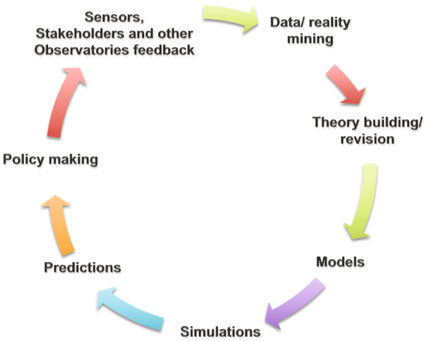
Exploratory of society
|
[2012]
|
|
Cederman, L. - E.;
Conte, R.;
Helbing, Dirk;
Nowak, A.;
Schweitzer, Frank;
Vespignani, Alessandro
|
The European Physical Journal Special Topics,
pages: 347-- 360,
volume: 214,
number: 1
|
more» «less
|
Abstract
A huge flow of quantitative social, demographic and behavioral data is becoming available that traces the activities and interactions of individuals, social patterns, transportation infrastructures and travel fluxes. This has caused, together with innovative computational techniques and methods for modeling social actions in hybrid (natural and artificial) societies, a qualitative change in the ways we model socio-technical systems. For the first time, society can be studied in a comprehensive fashion that addresses social and behavioral complexity. In other words we are in the position to envision the development of large data and computational cyber infrastructure defining an exploratory of society that provides quantitative anticipatory, explanatory and scenario analysis capabilities ranging from emerging infectious disease to conflict and crime surges. The goal of the exploratory of society is to provide the basic infrastructure embedding the framework of tools and knowledge needed for the design of forecast/anticipatory/crisis management approaches to socio technical systems, supporting future decision making procedures by accelerating the scientific cycle that goes from data generation to predictions.

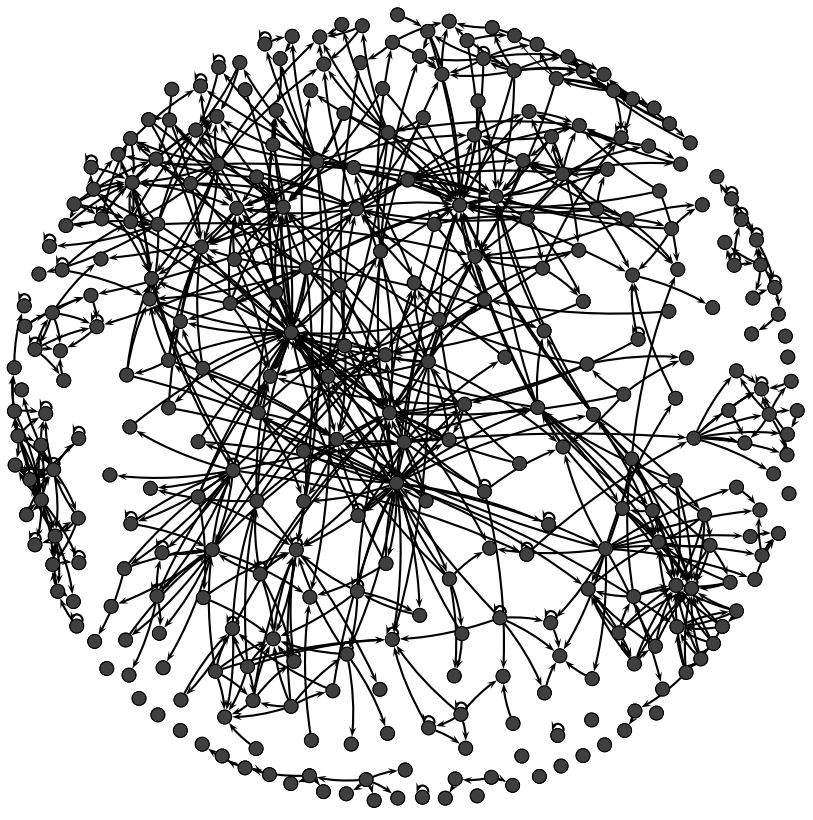
The Link between Dependency and Cochange: Empirical Evidence
|
[2012]
|
|
Geipel, Markus Michael;
Schweitzer, Frank
|
IEEE Transactions on Software Engineering,
pages: 1432-1444,
volume: 38,
number: 6
|
more» «less
|
Abstract
We investigate the relationship between class dependency and change propagation (cochange) in software written in Java. On the one hand, we find a strong correlation between dependency and cochange. Furthermore, we provide empirical evidence for the propagation of change along paths of dependency. These findings support the often alleged role of dependencies as propagators of change. On the other hand, we find that approximately half of all dependencies are never involved in cochanges and that the vast majority of cochanges pertain to only a small percentage of dependencies. This means that inferring the cochange characteristics of a software architecture solely from its dependency structure results in a severely distorted approximation of cochange characteristics. Any metric which uses dependencies alone to pass judgment on the evolvability of a piece of Java software is thus unreliable. As a consequence, we suggest to always take both the change characteristics and the dependency structure into account when evaluating software architecture.

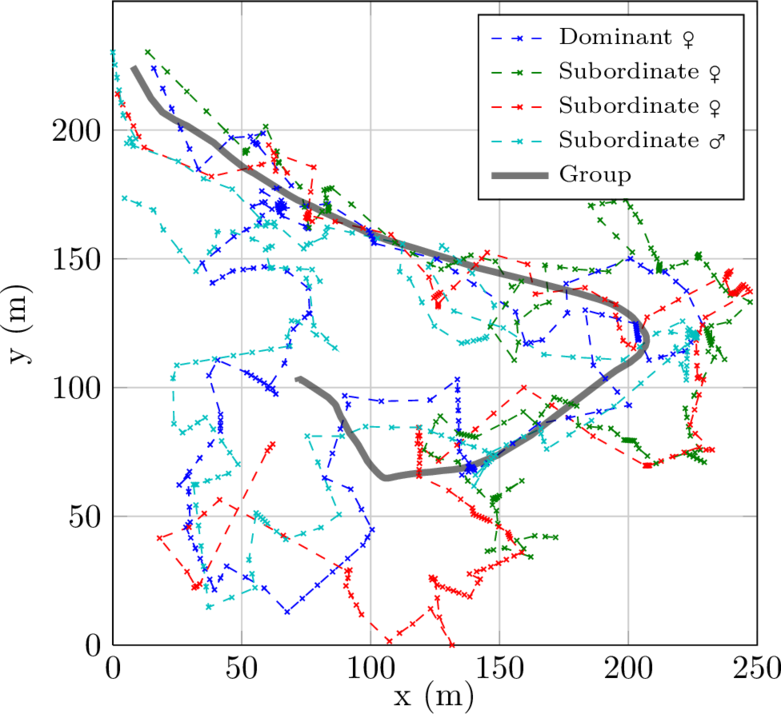
"Take me to your leader!": Inferring leadership in animal groups on the move
|
[2012]
|
|
Perony, Nicolas;
Richardson, Thomas R.;
Manser, Marta B.;
Schweitzer, Frank
|
Proceedings of the Thirteenth International Conference on the Simulation and Synthesis of Living Systems (Artificial Life 13)
|
more» «less
|
Remarks
Extended abstract

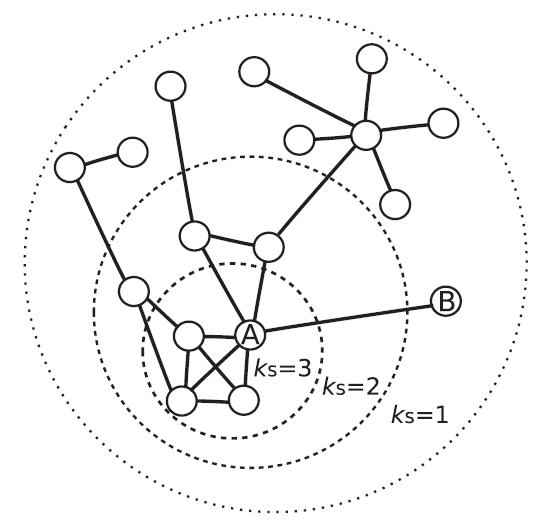
A k-shell decomposition method for weighted networks
|
[2012]
|
|
Garas, Antonios;
Schweitzer, Frank;
Havlin, Shlomo
|
New Journal of Physics,
pages: 083030,
volume: 14,
number: 8
|
more» «less
|
Abstract
We present a generalized method for calculating the k-shell structure of weighted networks. The method takes into account both the weight and the degree of a network, in such a way that in the absence of weights we resume the shell structure obtained by the classic k-shell decomposition. In the presence of weights, we show that the method is able to partition the network in a more refined way, without the need of any arbitrary threshold on the weight values. Furthermore, by simulating spreading processes using the susceptible-infectious-recovered model in four different weighted real-world networks, we show that the weighted k-shell decomposition method ranks the nodes more accurately, by placing nodes with higher spreading potential into shells closer to the core. In addition, we demonstrate our new method on a real economic network and show that the core calculated using the weighted k-shell method is more meaningful from an economic perspective when compared with the unweighted one.

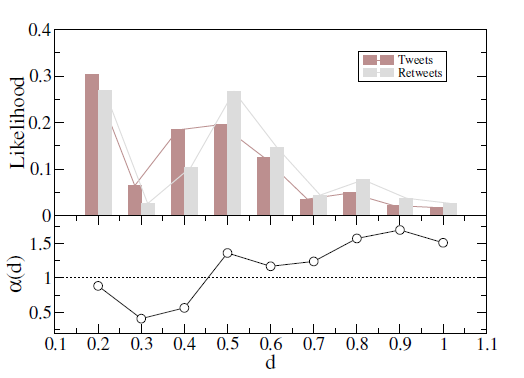
Emotional divergence influences information spreading in Twitter
|
[2012]
|
|
Pfitzner, Rene;
Garas, Antonios;
Schweitzer, Frank
|
Sixth International AAAI Conference on Weblogs and Social Media,
pages: 2-- 5
|
more» «less
|
Abstract
We analyze data about the micro-blogging site Twitter using sentiment extraction techniques. From an information per- spective, Twitter users are involved mostly in two processes: information creation and subsequent distribution (tweeting), and pure information distribution (retweeting), with pro- nounced preference to the first. However a rather substantial fraction of tweets are retweeted. Here, we address the role of the sentiment expressed in tweets for their potential after- math. We find that although the overall sentiment (polarity) does not influence the probability of a tweet to be retweeted, a new measure called emotional divergence does have an im- pact. In general, tweets with high emotional diversity have a better chance of being retweeted, hence influencing the dis- tribution of information.

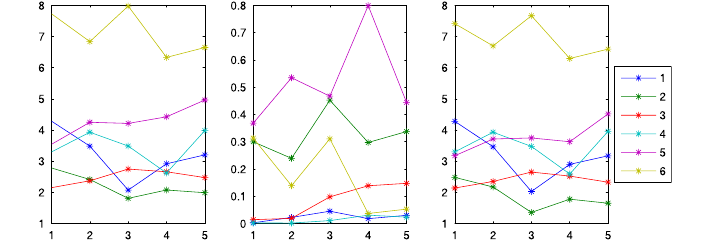
Effects of social influence on the wisdom of crowds
|
[2012]
|
|
Mavrodiev, Pavlin;
Tessone, Claudio Juan;
Schweitzer, Frank
|
In Proceedings of the conference on Collective Intelligence 2012
|
more» «less
|
Abstract
Wisdom of crowds refers to the phenomenon that the aggregate prediction or forecast of a group of individuals can be surprisingly more accurate than most individuals in the group, and sometimes - than any of the individuals comprising it. This article models the impact of social influence on the wisdom of crowds. We build a minimalistic representation of individuals as Brownian particles coupled by means of social influence. We demonstrate that the model can reproduce results of a previous empirical study. This allows us to draw more fundamental conclusions about the role of social influence: In particular, we show that the question of whether social influence has a positive or negative net effect on the wisdom of crowds is ill-defined. Instead, it is the starting configuration of the population, in terms of its diversity and accuracy, that directly determines how beneficial social influence actually is. The article further examines the scenarios under which social influence promotes or impairs the wisdom of crowds.


The efficiency and stability of R&D networks
|
[2012]
|
|
Koenig, Michael D;
Battiston, Stefano;
Napoletano, Mauro;
Schweitzer, Frank
|
Games and Economic Behavior,
pages: 694-713,
volume: 75,
number: 2
|
more» «less
|
Abstract
We investigate the efficiency and stability of R&D networks in a model with network-dependent indirect spillovers. We show that the efficient network structure critically depends on the marginal cost of R&D collaborations. When the marginal cost is low, the complete graph is efficient, while high marginal costs imply that the efficient network is asymmetric and has a nested structure. Regarding the stability of network structures, we show the existence of both symmetric and asymmetric equilibria. The efficient network is stable for small industry size and small cost. In contrast, for large industry size, there is a wide region of cost in which the efficient network is not stable. This implies a divergence between efficiency and stability in large industries.

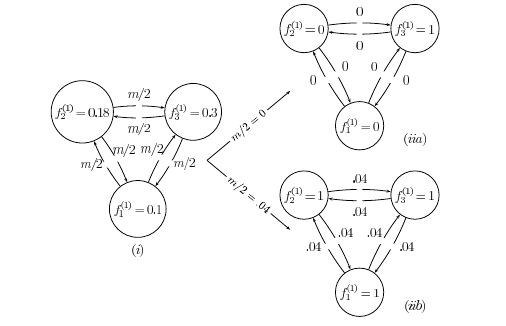
Optimal migration promotes the outbreak of cooperation in heterogeneous populations
|
[2012]
|
|
Schweitzer, Frank;
Behera, Laxmidhar
|
ACS - Advances in Complex Systems,
pages: 1250059,
volume: 15,
number: supp01
|
more» «less
|
Abstract
We consider a population of agents that are heterogeneous with respect to (i) their strategy when interacting ng times with other agents in an iterated prisoners dilemma game, (ii) their spatial location on K different islands. After each generation, agents adopt strategies proportional to their average payoff received. Assuming a mix of two cooperating and two defecting strategies, we first investigate for isolated islands the conditions for an exclusive domination of each of these strategies and their possible coexistence. This allows to define a threshold frequency for cooperation that, dependent on ng and the initial mix of strategies, describes the outbreak of cooperation in the absense of migration. We then allow migration of a fixed fraction of the population after each generation. Assuming a worst case scenario where all islands are occupied by defecting strategies, whereas only one island is occupied by cooperators at the threshold frequency, we determine the optimal migration rate that allows the outbreak of cooperation on all islands. We further find that the threshold frequency divided by the number of islands, i.e. the relative effort for invading defecting islands with cooperators decreases with the number of islands. We also show that there is only a small bandwidth of migration rates, to allow the outbreak of cooperation. Larger migration rates destroy cooperation.


A tunable mechanism for identifying trusted nodes in large scale distributed networks
|
[2012]
|
|
Chandra, Joydeep;
Scholtes, Ingo;
Ganguly, Niloy;
Schweitzer, Frank
|
Proceedings of 11th IEEE International Conference on Trust, Security and Privacy in Computing and Communications (TrustCom 2012)
|
more» «less
|
Abstract
In this paper, we propose a simple randomized
protocol for identifying trusted nodes based on personalized
trust in large scale distributed networks. The problem of
identifying trusted nodes, based on personalized trust, in a
large network setting stems from the huge computation and
message overhead involved in exhaustively calculating and
propagating the trust estimates by the remote nodes. However,
in any practical scenario, nodes generally communicate with
a small subset of nodes and thus exhaustively estimating the
trust of all the nodes can lead to huge resource consumption.
In contrast, our mechanism can be tuned to locate a desired
subset of trusted nodes, based on the allowable overhead, with
respect to a particular user. The mechanism is based on a
simple exchange of random walk messages and nodes counting
the number of times they are being hit by random walkers
of nodes in their neighborhood. Simulation results to analyze
the effectiveness of the algorithm show that using the proposed
algorithm, nodes identify the top trusted nodes in the network
with a very high probability by exploring only around 45% of
the total nodes, and in turn generates nearly 90% less overhead
as compared to an exhaustive trust estimation mechanism,
named TrustWebRank. Finally, we provide a measure of the
global trustworthiness of a node; simulation results indicate
that the measures generated using our mechanism differ by
only around 0.6% as compared to TrustWebRank.

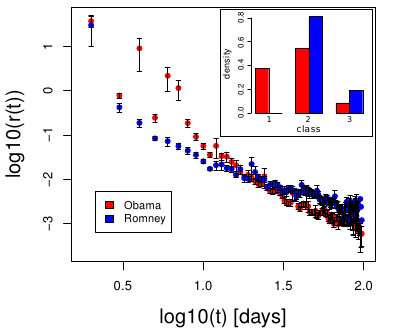
Political polarization and popularity in online participatory media : An integrated approach
|
[2012]
|
|
Garcia, David;
Mendez, Fernando;
Serdult, Uwe;
Schweitzer, Frank
|
In Proceedings of the Proceedings of the first edition workshop on Politics, elections and data - PLEAD '12
|
more» «less
|
Abstract
We present our approach to online popularity and its applications to political science, aiming at the creation of agentbased models that reproduce patterns of popularity in participatory media. We illustrate our approach analyzing a dataset from Youtube, composed of the view statistics and
comments for the videos of the U.S. presidential campaigns of 2008 and 2012. Using sentiment analysis, we quantify the collective emotions expressed by the viewers, finding that democrat campaigns elicited more positive collective emotions than republican campaigns. Techniques from computational social science allow us to measure virality of the videos of each campaign, to find that democrat videos are shared faster but republican ones are remembered longer inside the community. Last we present our work in progress in voting advice applications, and our results analyzing the
data from choose4greece.com. We show how we assess the policy differences between parties and their voters, and how voting advice applications can be extended to test our agentbased models.

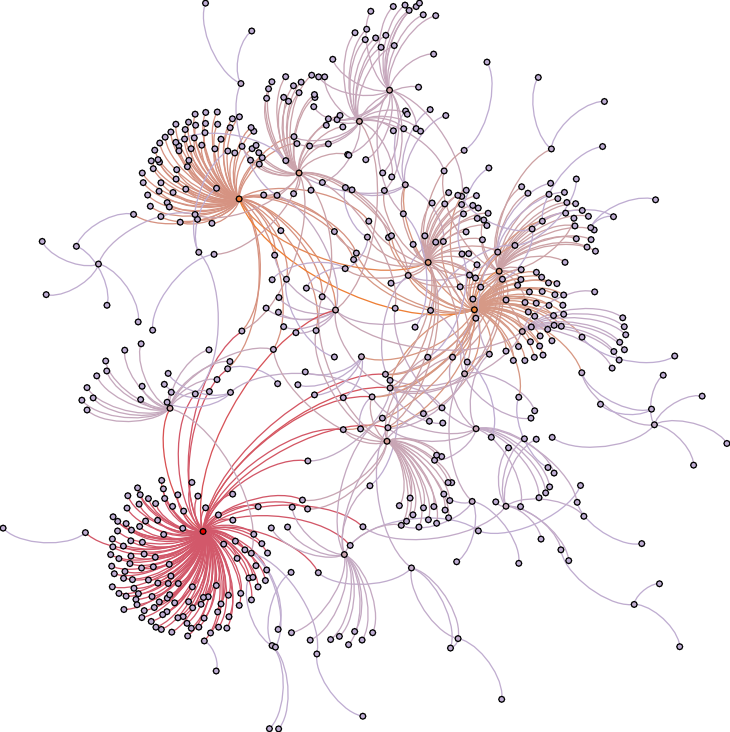
A quantitative study of social organisation in open source software communities
|
[2012]
|
|
Zanetti, Marcelo Serrano;
Sarigol, Emre;
Scholtes, Ingo;
Tessone, Claudio Juan;
Schweitzer, Frank
|
In Proceedings of the 2012 Imperial College Computing Student Workshop
|
more» «less
|
Abstract
The success of open source projects crucially depends on the voluntary contributions of a suf-
ficiently large community of users. Apart from the mere size of the community, interesting
questions arises when looking at the evolution of structural features of collaborations between
community members. In this article, we discuss several network analytic proxies that can be
used to quantify different aspects of the social organisation in social collaboration networks. We
particularly focus on measures that can be related to the cohesiveness of the communities, the
distribution of responsibilities and the resilience against turnover of community members. We
present a comparative analysis on a large-scale data set that covers the full history of collabor-
ations between users of 14 major open source software communities. Our analysis covers both
aggregate and time-evolving measures and highlights differences in the social organisation across
communities. We argue that our results are a promising first step towards the definition of
suitable, potentially multi-dimensional, resilience and risk indicators for open source software
communities.

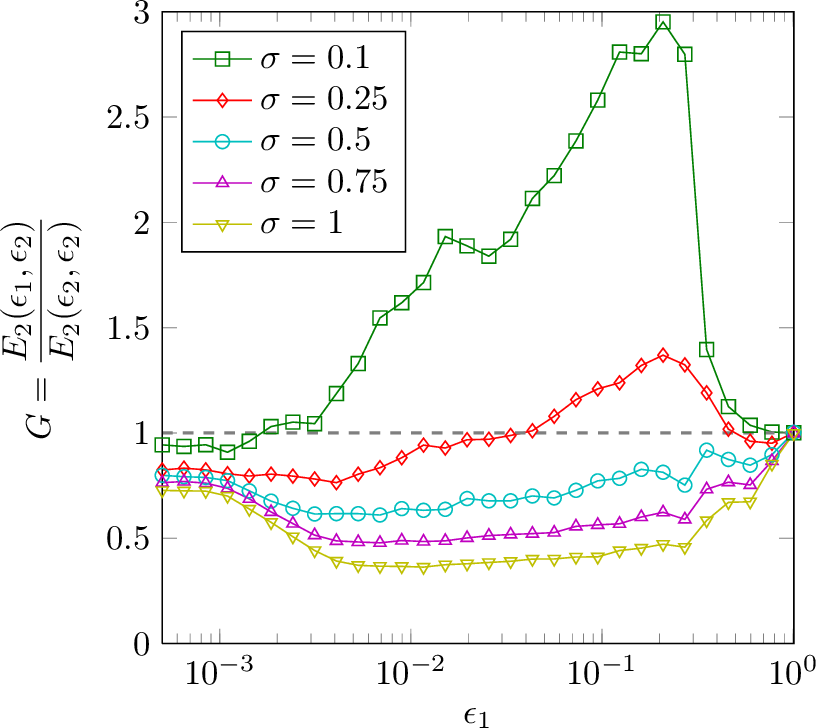
Hierarchical consensus formation reduces the influence of opinion bias
|
[2012]
|
|
Perony, Nicolas;
Pfitzner, Rene;
Scholtes, Ingo;
Schweitzer, Frank;
Tessone, Claudio Juan
|
In ECMS 2012 - Proceedings of the 26th European Conference on Modelling and Simulation
|
more» «less
|
Abstract
We study the role of hierarchical structures in a simple model of collective consensus formation based on the bounded confidence model with continuous individual opinions. For the particular variation of this model considered in this paper, we assume that a bias towards an extreme opinion is introduced whenever two individuals interact and form a common decision. As a simple proxy for hierarchical social structures, we introduce a two-step decision making process in which in the second step groups of like-minded individuals are replaced by representatives once they have reached local consensus, and the representatives in turn form a collective decision in a downstream process. We find that the introduction of such a hierarchical decision making structure can improve consensus formation, in the sense that the eventual collective opinion is closer to the true average of individual opinions than without it. In particular, we numerically study how the size of groups of like-minded individuals being represented by delegate individuals affects the impact of the bias on the final population-wide consensus. These results are of interest for the design of organisational policies and the optimisation of hierarchical structures in the context of group decision making.


Time-explicit graphs: A framework for dynamic network analysis
|
[2012]
|
|
Pfitzner, Rene;
Scholtes, Ingo;
Tessone, Claudio Juan;
Garas, Antonios;
Schweitzer, Frank
|
Extended Poster Abstract at Summer School "Modeling and Analysis of Novel Mechanisms in Future Internet Applications", Würzburg
|
more» «less
|
Abstract
When dealing with networks of several kind, network theory provides the theoretical framework and the practical tools to analyze them. Mostly analysis focuses on steady networks, i.e. networks with fixed topology. However, real-world scenarios often deal with (highly) dynamic topologies. As of today, the question of how to investigate such scenarios, e.g. defining a meaningful notion of “temporal centrality”, has generally not been answered. In this poster we present research pointing out the obstacles arising in this endeavor as well as a possible framework to address those issues, which we call time-explicit graphs.
Editorial
|
[2012]
|
|
Schweitzer, Frank;
Vespignani, Alessandro
|
EPJ Data Science,
pages: 1,
volume: 1,
number: 1
|
more» «less
|
Abstract
Science is changing, all the time. Some consider external factors to be the major driving force, such as new discoveries, or new technologies that provide deeper insights into known systems. Others consider internal factors to be more important, such as the never-ending search for eternal truths or, at least, for the theoretical unification of diverse observations. Yet others believe that science is a social endeavor and its evolution is governed by forces very similar to those that cause fashions to change, with new research topics seeming to catch our attention and established topics falling out of vogue. We have come to believe that all of these arguments apply, and that the various impacts on scientific progress are even mutually dependent. Fashionable topics co-evolve with technological advances, as do new discoveries with overarching theories.

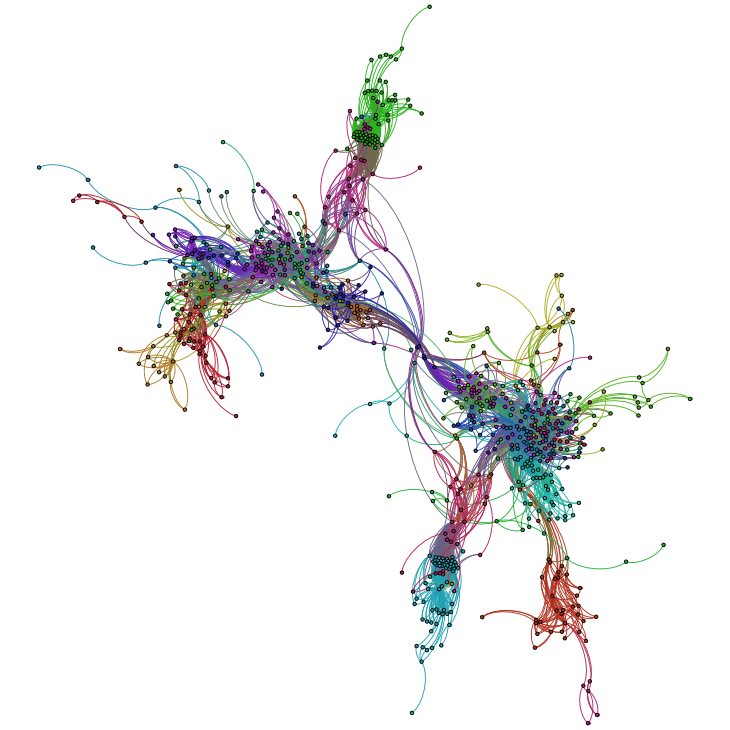
A network perspective on software modularity
|
[2012]
|
|
Zanetti, Marcelo Serrano;
Schweitzer, Frank
|
Architecture of Computing Systems (ARCS) Workshops 2012
|
more» «less
|
Abstract
Modularity is a desirable characteristic for software systems. In this article we propose to use a quantitative method from complex network sciences to estimate the coherence between the modularity of the dependency network of large open source Java projects and their decomposition in terms of Java packages. The results presented in this article indicate that our methodology offers a promising and reasonable quantitative approach with potential impact on software engineering processes.

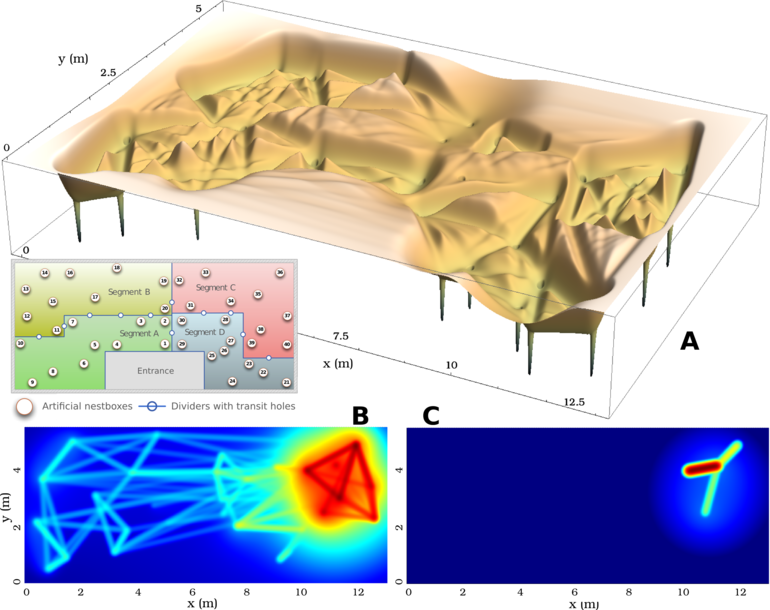
How random is social behaviour? Disentangling social complexity through the study of a wild house mouse population
|
[2012]
|
|
Perony, Nicolas;
Tessone, Claudio Juan;
Koenig, Barbara;
Schweitzer, Frank
|
PLOS Computational Biology,
pages: e1002786,
volume: 8,
number: 11
|
more» «less
|
Abstract
From the synchronised beauty of fish schools to the rigorous hierarchy of ant colonies, animals often display awe-inspiring collective behaviour. In recent years, principles of statistical physics have helped to unveil some simple mechanisms behind the emergence of such collective dynamics. Among the most elementary tools used to explain group behaviour are random processes, a typical example being the so-called “random walk”. In this paper, we have developed a framework based on such random assumptions to study the spatial and social structure of a population of wild house mice. We introduce the concept of perceptual landscape to describe the spatial behaviour of animals, whilst including all sensory and social constraints they are subject to: the perceptual landscape effectively maps the environment of animals as they perceive it. By applying our assumptions to a multi-agent model, we are able to reveal that much of the high-level social behaviour observed in the mouse population can indeed be explained through the many interactions of randomly moving individuals. This raises the question of how much of what we often regard as complex natural phenomena may, in fact, be the result of exceedingly simple forces.


Positive words carry less information than negative words
|
[2012]
|
|
Garcia, David;
Garas, Antonios;
Schweitzer, Frank
|
EPJ Data Science,
pages: 3,
volume: 1
|
more» «less
|
Abstract
We show that the frequency of word use is not only determined by the word length [1] and the average information content [2], but also by its emotional content.We have analysed three established lexica of affective word usage in English, German, and Spanish, to verify that these lexica have a neutral, unbiased, emotional content. Taking into account the frequency of word usage, we find that words with a positive emotional content are more frequently used. This lends support to Pollyanna hypothesis [3] that there should be a positive bias in human expression. We also find that negative words contain more information than positive words, as the informativeness of a word increases uniformly with its valence decrease. Our findings support earlier conjectures about (i) the relation between word frequency and information content, and (ii) the impact of positive emotions on communication and social links.

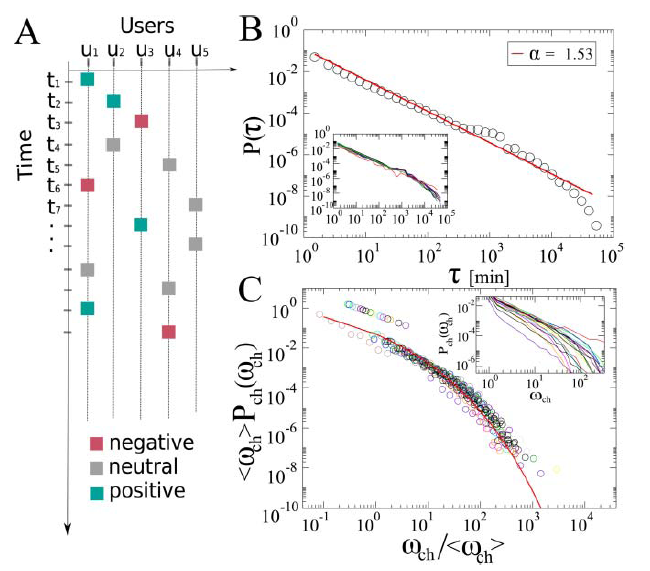
Emotional persistence in online chatting communities
|
[2012]
|
|
Garas, Antonios;
Garcia, David;
Skowron, Marcin;
Schweitzer, Frank
|
Scientific Reports,
pages: 402,
volume: 2
|
more» «less
|
Abstract
How do users behave in online chatrooms, where they instantaneously read and write posts? We analyzed about 2.5 million posts covering various topics in Internet relay channels, and found that user activity patterns follow known power-law and stretched exponential distributions, indicating that online chat activity is not different from other forms of communication. Analysing the emotional expressions (positive, negative, neutral) of users, we revealed a remarkable persistence both for individual users and channels. I.e. despite their anonymity, users tend to follow social norms in repeated interactions in online chats, which results in a specific emotional “tone” of the channels. We provide an agent-based model of emotional interaction, which recovers qualitatively both the activity patterns in chatrooms and the emotional persistence of users and channels. While our assumptions about agent's emotional expressions are rooted in psychology, the model allows to test different hypothesis regarding their emotional impact in online communication.

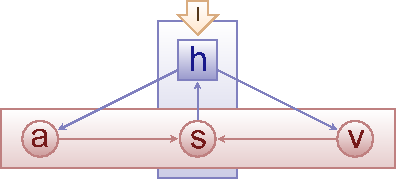
Modeling online collective emotions
|
[2012]
|
|
Garcia, David;
Schweitzer, Frank
|
Proceedings of the 2012 workshop on Data-driven user behavioral modelling and mining from social media-DUBMMSM '12, CIKM2012
|
more» «less
|
Abstract
A common phenomenon on the Internet is the appearance of collective emotions, in which many users share an emotional state. Online communities allow users to emotionally interact with large amounts of other users, creating collective states faster than in offline interaction. We present our modeling framework for collective emotions in online communities. This framework allows the analysis and design of agent-based models, including the dynamics of psychological states under emotional interaction. We illustrate the applications of our framework through an overview of two different models. Based on this framework, our first model of emotions in product reviews communities reproduces the empirical distribution of emotions towards products in Amazon. The second model within our framework reproduces the emergence of emotional persistence at the individual and collective level. This persistence pattern is similar to the one revealed by our statistical analysis of IRC chatrooms. Further applications of our framework aim at reproducing collective features of emotions in a variety of online communities.

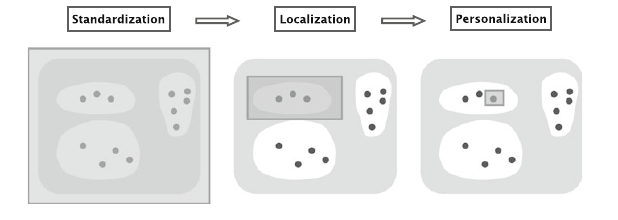
Moving recommender systems from on-line commerce to retail stores
|
[2012]
|
|
Walter, Frank Edward;
Battiston, Stefano;
Yildirim, Mahir;
Schweitzer, Frank
|
Information Systems and e-Business Management,
pages: 367-- 393,
volume: 10,
number: 3
|
more» «less
|
Abstract
The increasing diversity of consumers’ demand, as documented by the debate on the long tail of the distribution of sales volume across products, represents a challenge for retail stores. Recommender systems offer a tool to cope with this challenge. The recent developments in information technology and ubiquitous computing makes it feasible to move recommender systems from the on-line commerce, where they are widely used, to retail stores. In this paper, we aim to bridge the management literature and the computer science literature by analysing a number of issues that arise when applying recommender systems to retail stores: these range from the format of the stores that would benefit most from recommender systems to the impact of coverage and control of recommender systems on customer loyalty and competition among retail stores.
Editorial: Agents and multi-agent systems
|
[2011]
|
|
Schweitzer, Frank;
Taylor, Matthew E.
|
ACS - Advances in Complex Systems,
pages: iii-- iv,
volume: 14,
number: 2
|
more» «less
|
Abstract
The agent concept is one of the very few concepts which have been able to cross the borders of scientific disciplines, finding applications not only in computer science and artificial intelligence, but also in biology, economics, engineering, and the social sciences. Thus it is only natural that the research frontiers in this fast growing field develop along interdisciplinary problems. These include the ability of agents to evolve, e.g. through adaptation and learning, but also the emergence of systemic properties which result from the interplay of large numbers of agents, rather than from carefully designed single agent behavior.


Agent-based modeling of intracellular transport
|
[2011]
|
|
Birbaumer, Mirko;
Schweitzer, Frank
|
The European Physical Journal B,
pages: 245-- 255,
volume: 82,
number: 3
|
more» «less
|
Abstract
We develop an agent-based model of the motion and pattern formation of vesicles. These intracellular particles can be found in four different modes of (undirected and directed) motion and can fuse with other vesicles. While the size of vesicles follows a log-normal distribution that changes over time due to fusion processes, their spatial distribution gives rise to distinct patterns. Their occurrence depends on the concentration of proteins which are synthesized based on the transcriptional activities of some genes. Hence, differences in these spatio-temporal vesicle patterns allow indirect conclusions about the (unknown) impact of these genes. By means of agent-based computer simulations we are able to reproduce such patterns on real temporal and spatial scales. Our modeling approach is based on Brownian agents with an internal degree of freedom, $θ$, that represents the different modes of motion. Conditions inside the cell are modeled by an effective potential that differs for agents dependent on their value $θ$. Agent’s motion in this effective potential is modeled by an overdampted Langevin equation, changes of $θ$ are modeled as stochastic transitions with values obtained from experiments, and fusion events are modeled as space-dependent stochastic transitions. Our results for the spatio-temporal vesicle patterns can be used for a statistical comparison with experiments. We also derive hypotheses of how the silencing of some genes may affect the intracellular transport, and point to generalizations of the model.

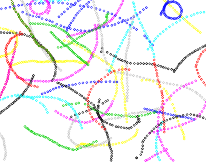
Testing an agent-based model of bacterial cell motility: How nutrient concentration affects speed distribution
|
[2011]
|
|
Garcia, Victor;
Birbaumer, Mirko;
Schweitzer, Frank
|
The European Physical Journal B,
pages: 235-- 244,
volume: 82,
number: 3-4
|
more» «less
|
Abstract
We revisit a recently proposed agent-based model of active biological motion and compare its predictions with own experimental findings for the speed distribution of bacterial cells, Salmonella typhimurium. Agents move according to a stochastic dynamics and use energy stored in an internal depot for metabolism and active motion. We discuss different assump-tions of how the conversion from internal to kinetic energy d(v) may depend on the actual speed, to conclude that d2v$ξ$ with either $ξ$ = 2 or 1 < $ξ$ < 2 are promising hypotheses. To test these, we compare the model’s prediction with the speed distribution of bacteria which were obtained in media of different nutrient concentration and at different times. We find that both hypotheses are in line with the experimental observations, with $ξ$ between 1.67 and 2.0. Regarding the influence of a higher nutrient concentration, we conclude that the take-up of energy by bacterial cells is indeed increased. But this energy is not used to increase the speed, with 40µm/s as the most probable value of the speed distribution, but is rather spend on metabolism and growth.

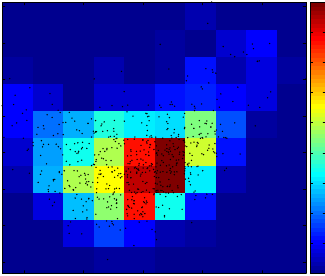
Emotions in product reviews – empirics and models
|
[2011]
|
|
Garcia, David;
Schweitzer, Frank
|
Proceedings of 2011 IEEE International Conference on Privacy, Security, Risk, and Trust, and IEEE International Conference on Social Computing, PASSAT/SocialCom,
pages: 483--488
|
more» «less
|
Abstract
Online communities provide Internet users with means to overcome some information barriers and constraints, such as the difficulty to gather independent information about products and firms. Product review communities allow customers to share their opinions and emotions after the purchase of a product. We introduce a new dataset of product reviews from Amazon.com, with emotional information extracted by sentiment detection tools. Our statistical analysis of this data provides evidence for the existence of polemic reviews, as well as for the coexistence of positive and negative emotions inside reviews. We find a strong bias towards large values in the expression of positive emotions, while negative ones are more evenly distributed. We identified different time dynamics of the creation of reviews dependent on the presence of marketing and word of mouth effects. We define an agent-based model of the users of product review communities using a modeling framework for online emotions. This model can reproduce the scenarios of response to external influences, as well as some properties of the distributions of positive and negative emotions expressed in product reviews. This analysis and model can provide guidelines to manufacturers on how to increase customer satisfaction and how to measure the emotional impact of marketing campaigns through reviews data.

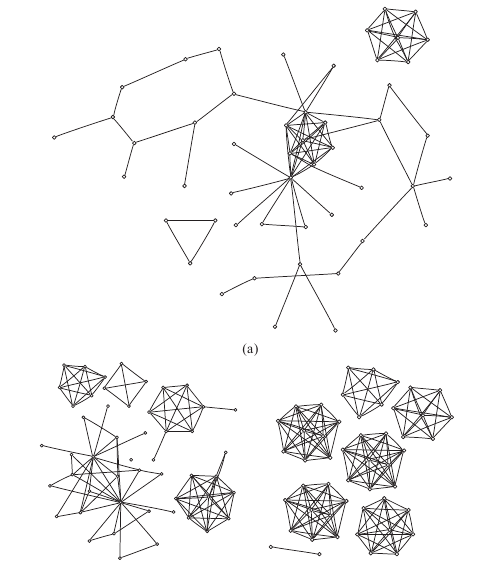
Recombinant knowledge and the evolution of innovation networks
|
[2011]
|
|
Koenig, Michael D;
Battiston, Stefano;
Napoletano, Mauro;
Schweitzer, Frank
|
Journal of Economic Behavior & Organization,
pages: 145–164,
volume: 79,
number: 3
|
more» «less
|
Abstract
We introduce a new model for the evolution of networks of firms exchanging knowledge in R&D partnerships. Innovation is assumed to result from the recombination of knowledge among firms in an R&D intensive industry. The decision of two firms to establish a new partnerships or to terminate an existing one, is based on their marginal revenues and costs, which in turn depend on the position they occupy in the network. Moreover, the formation of a collaboration has significant external effects on the other firms in the same connected component of the network. We show that this decentralized partner selection process leads to the existence of multiple equilibrium structures. Finally, by means of computer simulations, we study the properties of the emerging equilibrium networks and we show that they reproduce the stylized facts of R&D networks.


Sustainable growth in complex networks
|
[2011]
|
|
Tessone, Claudio Juan;
Geipel, Markus Michael;
Schweitzer, Frank
|
Europhysics Letters,
pages: 58005,
volume: 96,
number: 5
|
more» «less
|
Abstract
Based on the analysis of the dependency network in 18 Java projects, we develop a novel model of network growth which considers both preferential attachment and the addition of new nodes with a heterogeneous distribution of their initial degree, k0. Empirically we find that the cumulative distributions of initial and final degrees in the network follow power law behaviours: 1−P(k0)∝k1−$α$ as a function of the network size, we find empirically K(N)∝N$β$,where $β$ ∈[1.25, 2] (for small N), while converging to $β$ ∼1 for large N. This indicates a transition from a growth regime with increasing network density towards a sustainable regime, which prevents a collapse due to 0 ,and 1−P(k)∝k1−$γ$, respectively. For the total number of links ever increasing dependencies. Our theoretical framework allows us to predict relations between the exponents $α$, $β$, $γ$, which also link issues of software engineering and developer activity. These relations are verified by means of computer simulations and empirical investigations. They indicate that the growth of real Open Source Software networks occurs on the edge between two regimes, which are dominated either by the initial degree distribution of added nodes, or by the preferential attachment mechanism. Hence, the heterogeneous degree distribution of newly added nodes, found empirically, is essential to describe the laws of sustainable growth in networks.

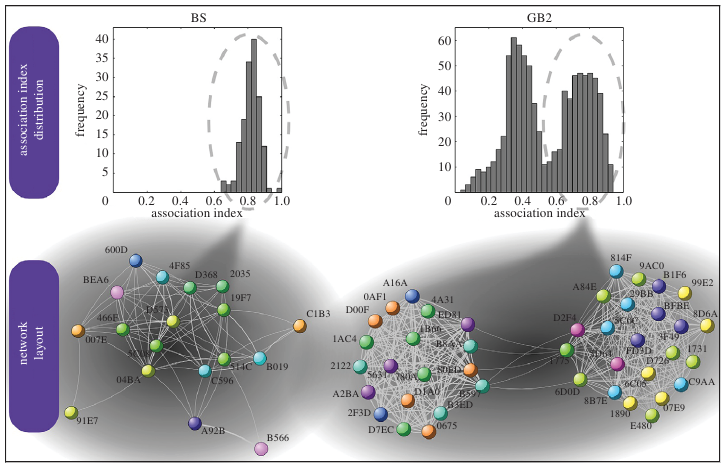
Bats are able to maintain long-term social relationships despite the high fission-fusion dynamics of their groups.
|
[2011]
|
|
Kerth, Gerald;
Perony, Nicolas;
Schweitzer, Frank
|
Proceedings of the Royal Society B: Biological Sciences,
pages: 2761-2767,
volume: 278,
number: 1719
|
more» «less
|
Abstract
Elephants, dolphins, as well as some carnivores and primates maintain social links despite their frequent splitting and merging in groups of variable composition, a phenomenon known as fission-fusion. Information on the dynamics of social links and interactions among individuals is of high importance to the understanding of the evolution of animal sociality, including that of humans. However, detailed long-term data on such dynamics in wild mammals with fully known demography and kin structures are scarce. Applying a weighted network analysis on 20 500 individual roosting observations over 5 years, we show that in two wild Bechstein's bat colonies with high fission-fusion dynamics, individuals of different age, size, reproductive status and relatedness maintain long-term social relationships. In the larger colony, we detected two stable subunits, each comprising bats from several family lineages. Links between these subunits were mainly maintained by older bats and persisted over all years. Moreover, we show that the full details of the social structure become apparent only when large datasets are used. The stable multi-level social structures in Bechstein's bat colonies resemble that of elephants, dolphins and some primates. Our findings thus may shed new light on the link between social complexity and social cognition in mammals.
Remarks
Gerald Kerth and Nicolas Perony contributed equally to the study.
Featured in Science Editor's Choice (DOI: 10.1126/science.331.6023.1366-d).
Among the Proc. R. Soc. B most-read articles in February 2011.
Reply to Farrell: Improved individual estimation success can imply collective tunnel vision
|
[2011]
|
|
Rauhut, Heiko;
Lorenz, Jan;
Schweitzer, Frank;
Helbing, Dirk
|
Proceedings of the National Academy of Sciences (PNAS),
pages: E626,
volume: 108,
number: 36
|
more» «less
|
Abstract
Analyzing the data of the wisdom of crowd experiment by Lorenz et al. (1), Farrell (2) points out that information exchange improves individual estimates of answers to factual questions. He furthermore suggests that information exchange increases individual rewards and that this comes with an increase in confidence in their estimates. However, it has to be noted that individual rewards were revealed only after subjects specified their confidence. [This also shows that the reference to Danchin et al. (3) is not fitting, because in the foraging example, subjects were constantly aware of the external metric, namely the success of the foraging activities of other individuals.] Moreover, although the original experiment was designed to study social interaction effects, Farrell applies a psychological perspective. In fact, Farrell's commentary (2) focuses on individual-level effects, whereas Lorenz et al. (1) concentrated on group-level effects and show how aggregating micro-outcomes can lead to unexpected macro-level effects.

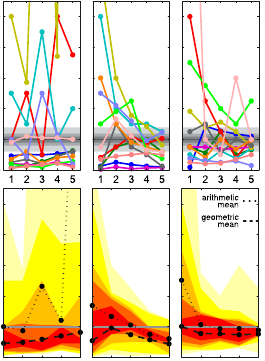
How social influence can undermine the wisdom of crowd effect
|
[2011]
|
|
Lorenz, Jan;
Rauhut, Heiko;
Schweitzer, Frank;
Helbing, Dirk
|
Proceedings of the National Academy of Sciences (PNAS),
pages: 9020-- 9025,
volume: 108,
number: 22
|
more» «less
|
Abstract
Social groups can be remarkably smart and knowledgeable when their averaged judgements are compared with the judgements of individuals. Already Galton [Galton F (1907) Nature 75:7] found evidence that the median estimate of a group can be more accu-rate than estimates of experts. This wisdom of crowd effect was recently supported by examples from stock markets, political elections, and quiz shows [Surowiecki J (2004) The Wisdom of Crowds]. In contrast, we demonstrate by experimental evidence (N = 144) that even mild social influence can undermine the wisdom of crowd effect in simple estimation tasks. In the exper-iment, subjects could reconsider their response to factual ques-tions after having received average or full information of the responses of other subjects. We compare subjects’ convergence of estimates and improvements in accuracy over five consecutive estimation periods with a control condition, in which no informa-tion about others’ responses was provided. Although groups are initially “wise,” knowledge about estimates of others narrows the diversity of opinions to such an extent that it undermines the wisdom of crowd effect in three different ways. The “social influence effect” diminishes the diversity of the crowd without improvements of its collective error. The “range reduction effect” moves the position of the truth to peripheral regions of the range of estimates so that the crowd becomes less reliable in providing expertise for external observers. The “confidence ef-fect” boosts individuals’ confidence after convergence of their estimates despite lack of improved accuracy. Examples of the revealed mechanism range from misled elites to the recent global financial crisis.
Sind die Physiker schuld an der Finanzkrise?
|
[2011]
|
|
Schweitzer, Frank
|
Physik Journal,
pages: 3,
volume: 10,
number: 4
|
more» «less
|
Abstract
Seit den 1990er-Jahren sind Physikerinnen und Physiker vermehrt in Banken, Versicherungen, im Fondsmanagement und in Unternehmensberatungen tätig – ein Trend, der weiterhin anhält und auch international zu beobachten ist. Sind sie qualifiziert für diese anspruchsvollen Aufgaben und kennen sie die Konsequenzen ihres Handelns? Oder werden ihre analytischen Fähigkeiten, ihr Talent zur Datenanalyse und zur Modellierung komplizierter Systeme überschätzt? Sind Physiker gar Schuld an der weltweiten Finanzkrise?
Editorial: Sozio- und Ökonophysik sind etablierte Forschungsfelder
|
[2010]
|
|
Schweitzer, Frank
|
Physik in unserer Zeit,
pages: 3,
volume: 6,
number: 41
|
more» «less
|
Abstract
Das Ganze ist mehr als die Summe seiner Teile“, lehrte schon Aristoteles. Wenn sich die „Teile“ zusammenschließen und miteinander in Wechselwirkung treten, entsteht also etwas Neues für das Gesamtsystem. Dieses lässt sich nicht auf den Beitrag der einzelnen Teile reduzieren. Die Wissenschaftstheorie bezeichnet diesen Vorgang als Emergenz. Damit wird zumeist ein Mehrwert für das Ganze generiert: Die Leitfähigkeit von Metallen entsteht, sofern eine kritische Mindestanzahl von Atomen beteiligt ist – ein typisches Beispiel aus der Physik. In biologischen Systemen schließen sich Zellen zu Organismen mit neuer Funktionalität zusammen, in der Volkswirtschaft generieren Produktion und Warenaustausch einer Vielzahl von Akteuren einen Mehrwert im ökonomischen Sinne, der die Grundlage des Wachstums bildet.

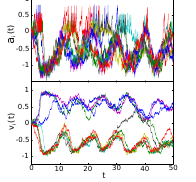
An agent-based model of collective emotions in online communities
|
[2010]
|
|
Schweitzer, Frank;
Garcia, David
|
The European Physical Journal B,
pages: 533-- 545,
volume: 77,
number: 4
|
more» «less
|
Abstract
We develop an agent-based framework to model the emergence of collective emotions, which is applied to online communities. Agent’s individual emotions are described by their valence and arousal. Using the concept of Brownian agents, these variables change according to a stochastic dynamics, which also considers the feedback from online communication. Agents generate emotional information, which is stored and distributed in a field modeling the online medium. This field affects the emotional states of agents in a non-linearmanner.We derive conditions for the emergence of collective emotions, observable in a bimodal valence distribution. Dependent on a saturated or a superlinear feedback between the information field and the agent’s arousal, we further identify scenarios where collective emotions only appear once or in a repeated manner. The analytical results are illustrated by agent-based computer simulations. Our framework provides testable hypotheses about the emergence of collective emotions, which can be verified by data from online communities.

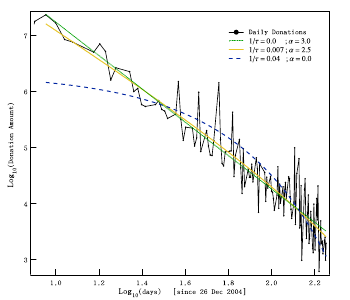
Power law signature of media exposure in human response waiting time distributions
|
[2010]
|
|
Crane, Riley;
Schweitzer, Frank;
Sornette, Didier
|
Physical Review E,
pages: 1-- 6,
volume: 81,
number: 5
|
more» «less
|
Abstract
We study the humanitarian response to the destruction brought by the tsunami generated by the Sumatra earthquake of December 26, 2004, as measured by donations, and find that it decays in time as a power law ~ 1/t^(alpha) with alpha = 2.5 + /-0.1. This behavior is suggested to be the rare outcome of a priority queuing process in which individuals execute tasks at a rate slightly faster than the rate at which new tasks arise. We believe this to be the first empirical evidence documenting this recently predicted regime, and provide additional independent evidence that suggests it arises as a result of the intense focus placed on this donation "task" by the media.

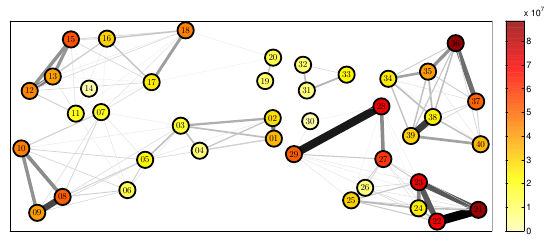
A stochastic model of social interaction in wild house mice
|
[2010]
|
|
Perony, Nicolas;
Koenig, Barbara;
Schweitzer, Frank
|
Proceedings of the European Conference on Complex Systems 2010
|
more» «less
|
Abstract
We investigate to what extent the interaction dynamics of a population of wild
house mouse (Mus musculus domesticus) in their environment can be explained
by a simple stochastic model. We use a Markov chain model to describe the transitions
of mice in a discrete space of nestboxes, and implement a multi-agent simulation of the
model. We find that some important features of our behavioural dataset can be
reproduced using this simplified stochastic representation, and discuss
the improvements that could be made to our model in order to increase the accuracy
of its predictions. Our findings have implications for the understanding of the
complexity underlying social behaviour in the animal kingdom and the cognitive
requirements of such behaviour.
Editorial: Complex networks
|
[2009]
|
|
Scalas, Enrico;
Schweitzer, Frank
|
ACS - Advances in Complex Systems,
pages: 1,
volume: 12,
number: 01
|
more» «less
|
Abstract
This topical issue features regular submissions to Advances in Complex Systems focusing on ‘Complex Networks’ from different perspectives. They have been selected by the editors to appear together in this issue, to highlight current research trends.
‘Complex Networks’ is a booming research area for quite a few years now. Since the work of Watts and Strogatz on ‘small world networks’ published in 1998 (a paper for which Google Scholar lists 7417 citations as of 14th February 2009), a networkmania has exploded in many applied fields of science. This led to the rediscovery of various results already present in the mathematical literature on graphs. However, the increasing interest on networks also led to the rediscovery of some gems in sociology, including the work of Granovetter on social networks already published in 1973.
Today, research on complex networks has expanded to various branches of science, ranging from biology to transportation, from economics to linguistics. Hence, it is becoming a truly interdisciplinary endeavor. It is worth noticing that the research in these areas is increasingly driven by available data, in addition to extending theoretical concepts to characterize these networks.


How groups can foster consensus: The case of local cultures
|
[2009]
|
|
Groeber, Patrick;
Schweitzer, Frank;
Press, Kerstin
|
Journal of Aritifical Societies and Social Simulation,
pages: 1-- 22,
volume: 12,
number: 2
|
more» «less
|
Abstract
A local culture denotes a commonly shared behaviour within a cluster of firms. Similar to social norms or conventions, it is an emergent feature resulting from the firms' interaction in an economic network. To model these dynamics, we consider a distributed agent population, representing e.g. firms or individuals. Further, we build on a continuous opinion dynamics model with bounded confidence ($ epsilon$), which assumes that two agents only interact if differences in their behaviour are less than $ epsilon$. Interaction results in more similarity of behaviour, i.e. convergence towards a common mean. This framework is extended by two major concepts: (i) The agent's in-group consisting of acquainted interaction partners is explicitly taken into account. This leads to an effective agent behaviour reflecting that agents try to continue to interact with past partners and thus to keep sufficiently close to them. (ii) The in-group network structure changes over time, as agents can form new links to other agents with sufficiently close effective behaviour or delete links to agents no longer close in behaviour. Thus, our model provides a feedback mechanism between the agents' behaviour and their in-group structure. Studying its consequences by means of agent-based computer simulations, we find that for narrow-minded agents (low $ epsilon$) the additional feedback helps to find consensus more often, whereas for open-minded agents (high $ epsilon$) this does not hold. This counterintuitive result is explained by simulations of the network evolution.
Economic Networks: What do we know and What do we need to know?
|
[2009]
|
|
Schweitzer, Frank;
Fagiolo, Giorgio;
Sornette, Didier;
Vega - Redondo, Fernando;
White, Douglas R.
|
Advances in Complex Systems,
pages: 407-- 422,
volume: 12,
number: 04
|
more» «less
|
Abstract
We examine the emergent field of economic networks and explore its ability to shed light on the global and volatile economy where credit, ownership, innovation, invest-ment, and virtually every other economic activity is carried at a scale and scope that respects no geographical, organizational, or political boundaries. In this context, the study of economic networks and their dynamics must reflect the vast complexity of the interaction patterns and integrate it with a realistic account of the incentives and information that govern agents’ behavior. The interplay of both has been shown to pro-duce metastabilities, system crashes, and emergent structures in ways that are yet only poorly understood. Meeting this exciting scientific challenge requires a combination of time-series analysis, complexity theory, and simulation with the analytical tools that have been developed by game theory, as well as graph and matrix theories. We argue that this will help achieving a better integration of theory and data models and provide a better understanding of the potentials and risks of modern economic systems.

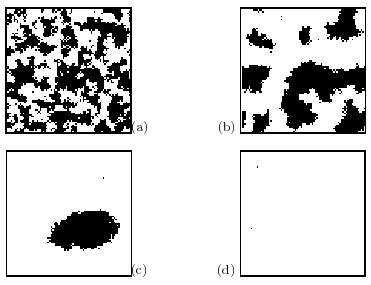
Nonlinear voter models: The transition from invasion to coexistence
|
[2009]
|
|
Schweitzer, Frank;
Behera, Laxmidhar
|
The European Physical Journal B,
pages: 301-- 318,
volume: 67,
number: 3
|
more» «less
|
Abstract
In nonlinear voter models the transitions between two states depend in a nonlinear manner on the frequencies of these states in the neighborhood. We investigate the role of these nonlinearities on the global outcome of the dynamics for a homogeneous network where each node is connected to $m = 4$ neighbors. The paper unfolds in two directions. We first develop a general stochastic framework for frequency dependent processes from which we derive the macroscopic dynamics for key variables, such as global frequencies and correlations. Explicite expressions for both the mean-field limit and the pair approximation are obtained. We then apply these equations to determine a phase diagram in the parameter space that distinguishes between different dynamic regimes. The pair approximation allows us to identify three regimes for nonlinear voter models: (i) complete invasion, (ii) random coexistence, and-- most interestingly-- (iii) correlated coexistence. These findings are contrasted with predictions from the mean-field phase diagram and are confirmed by extensive computer simulations of the microscopic dynamics.

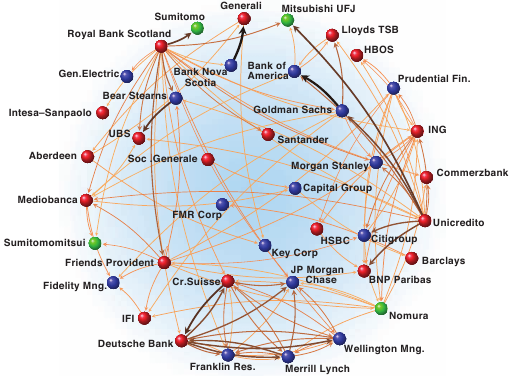
Economic networks: The new challenges
|
[2009]
|
|
Schweitzer, Frank;
Fagiolo, Giorgio;
Sornette, Didier;
Vega - Redondo, Fernando;
Vespignani, Alessandro;
White, Douglas R.
|
Science (New York, N.Y.),
pages: 422-- 425,
volume: 325,
number: 5939
|
more» «less
|
Abstract
The current economic crisis illustrates a critical need for new and fundamental understanding of the structure and dynamics of economic networks. Economic systems are increasingly built on interdependencies, implemented through trans-national credit and investment networks, trade relations, or supply chains that have proven difficult to predict and control. We need, therefore, an approach that stresses the systemic complexity of economic networks and that can be used to revise and extend established paradigms in economic theory. This will facilitate the design of policies that reduce conflicts between individual interests and global efficiency, as well as reduce the risk of global failure by making economic networks more robust.

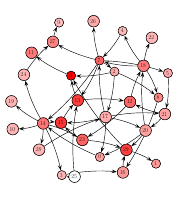
Modeling evolving innovation networks
|
[2009]
|
|
Koenig, Michael D;
Battiston, Stefano;
Schweitzer, Frank
|
Innovation Networks . New Approaches in Modelling and Analyzing
|
more» «less
|
Abstract
We develop a new framework for modeling innovation networks which evolve over time. The nodes in the network represent firms, whereas the directed links represent unilateral interactions between the firms. Both nodes and links evolve according to their own dynamics and on different time scales. The model assumes that firms produce knowledge based on the knowledge exchange with other firms, which involves both costs and benefits for the participating firms. In order to increase their knowledge production, firms follow different strategies to create and/or to delete links with other firms. Dependent on the information firms take into account for their decision, we find the emergence of different network structures. We analyze the conditions for the existence of these structures within a mathematical approach and underpin our findings by extensive computer simulations which show the evolution of the networks and their equilibrium state. In the discussion of the results, particular attention is given to the emergence of direct and indirect reciprocity in knowledge exchange, which refers to the emergence of cycles in the network structure. In order to motivate our modeling framework, in the first part of the chapter we give a broad overview of existing literature from economics and physics. This shows that our framework bridges and extends two different lines of research, namely the study of equilibrium networks with simple topologies and the dynamic approach of hypercycle models.

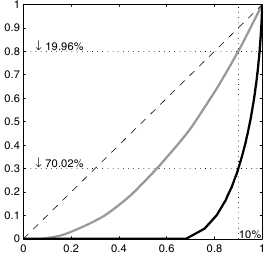
Software change dynamics: Evidence from 35 Java projects
|
[2009]
|
|
Geipel, Markus Michael;
Schweitzer, Frank
|
Proceedings of the the 7th joint meeting of the European software engineering conference and the ACM SIGSOFT symposium on The foundations of software engineering
|
more» «less
|
Abstract
In this paper we investigate the relationship between class dependency and change propagation in Java software. By analyzing 35 large Open Source Java projects, we find that in the majority of the projects more than half of the dependencies are never involved in change propagation. Furthermore, our analysis shows that only a few dependencies are transmitting the majority of change propagation events. An additional analysis reveals that this concentration cannot be explained by the different ages of the dependencies. The conclusion is that the dependency structure alone is a poor measure for the change dynamics. This contrasts with current literature.
Editorial: The complex systems section of EPJ B
|
[2009]
|
|
Schweitzer, Frank
|
The European Physical Journal B,
pages: 269-- 270,
volume: 67,
number: 3
|
more» «less
|
Abstract
EPJ B now receives more than 1000 submissions per year, and accounting for almost half of these, the ‘Complex Systems’ section has become popular to a degree where we are proud to offer you for the first time a regular issue of the journal containing original papers only from this area. They were not specially submitted for this issue, but instead were all recently accepted and selected from among our growing set of regular submissions from the fields of statistical, nonlinear and interdisciplinary physics.


Personalised and Dynamic Trust in Social Networks
|
[2009]
|
|
Walter, Frank Edward;
Battiston, Stefano;
Schweitzer, Frank
|
Proceedings of the third ACM conference on Recommender systems,
pages: 197-- 204
|
more» «less
|
Abstract
We propose a novel trust metric for social networks which is suitable for application in recommender systems. It is personalised and dynamic and allows to compute the indirect trust between two agents which are not neighbours based on the direct trust between agents that are neighbours. In analogy to some personalised versions of PageRank, this metric makes use of the concept of feedback centrality and overcomes some of the limitations of other trust metrics.In particular, it does not neglect cycles and other patterns characterising social networks, as some other algorithms do. In order to apply the metric to recommender systems, we propose a way to make trust dynamic over time. We show by means of analytical approximations and computer simulations that the metric has the desired properties. Finally, we carry out an empirical validation on a dataset crawled from an Internet community and compare the performance of a recommender system using our metric to one using collaborative filtering.

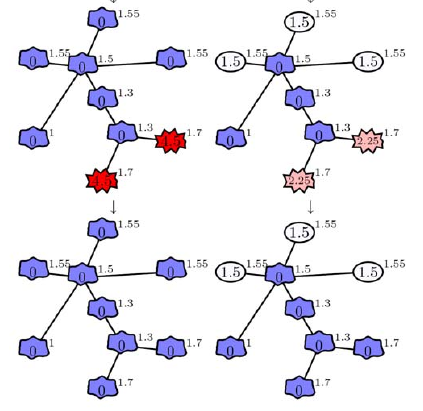
Systemic risk in a unifying framework for cascading processes on networks
|
[2009]
|
|
Lorenz, Jan;
Battiston, Stefano;
Schweitzer, Frank
|
The European Physical Journal B,
pages: 441-- 460,
volume: 71,
number: 4
|
more» «less
|
Abstract
We introduce a general framework for models of cascade and contagion processes on networks, to identify their commonalities and differences. In particular, models of social and financial cascades, as well as the fiber bundle model, the voter model, and models of epidemic spreading are recovered as special cases. To unify their description, we define the net fragility of a node, which is the difference between its fragility and the threshold that determines its failure. Nodes fail if their net fragility grows above zero and their failure increases the fragility of neighbouring nodes, thus possibly triggering a cascade. In this framework, we identify three classes depending on the way the fragility of a node is increased by the failure of a neighbour. At the microscopic level, we illustrate with specific examples how the failure spreading pattern varies with the node triggering the cascade, depending on its position in the network and its degree. At the macroscopic level, systemic risk is measured as the final fraction of failed nodes, X∗,and for each of the three classes we derive a recursive equation to compute its value. The phase diagram of X∗ as a function of the initial conditions, thus allows for a prediction of the systemic risk as well as a comparison of the three different model classes. We could identify which model class leads to a first-order phase transition in systemic risk, i.e. situations where small changes in the initial conditions determine a global failure. Eventually, we generalize our framework to encompass stochastic contagion models. This indicates the potential for further generalizations.


A complementary view on the growth of directory trees
|
[2009]
|
|
Geipel, Markus Michael;
Tessone, Claudio Juan;
Schweitzer, Frank
|
The European Physical Journal B,
pages: 641-- 648,
volume: 71,
number: 4
|
more» «less
|
Abstract
Trees are a special sub-class of networks with unique properties, such as the level distribution which has often been overlooked.We analyse a general tree growth model proposed by Klemm et al. [Phys. Rev. Lett. 95, 128701 (2005)] to explain the growth of user-generated directory structures in computers. The model has a single parameter q which interpolates between preferential attachment and random growth. Our analysis results in three contributions: first, we propose a more efficient estimation method for q based on the degree distribution, which is one specific representation of the model. Next, we introduce the concept of a level distribution and analytically solve the model for this representation. This allows for an alternative and independent measure of q.We argue that, to capture real growth processes, the q estimations from the degree and the level distributions should coincide. Thus, we finally apply both representations to validate the model with synthetically generated tree structures, as well as with collected data of user directories. In the case of real directory structures, we show that q measured from the level distribution are incompatible with q measured from the degree distribution. In contrast to this, we find perfect agreement in the case of simulated data. Thus, we conclude that the model is an incomplete description of the growth of real directory structures as it fails to reproduce the level distribution. This insight can be generalised to point out the importance of the level distribution for modeling tree growth.
Editorial: Risk, markets, games, and networks
|
[2009]
|
|
Schweitzer, Frank;
Battiston, Stefano;
Tessone, Claudio Juan
|
The European Physical Journal B,
pages: 439-- 440,
volume: 71,
number: 4
|
more» «less
|
Abstract
The 20 research articles collected in this issue share, in addition to their topical relations, one important feature: they present results obtained from research groups associated in the COST action P10 ‘Physics of Risk’. COST is an intergovernmental framework for ‘European Cooperation in Science and Technology’, allowing the coordination of research on a European level. The action P10 was funded between September 2003 and June 2008 and involved more than 80 scientists in 21 countries across Europe. The main objective of the action was to apply methods developed in statistical physics to accomplish a new quantitative understanding of the assessment of risk. This way it departed from usual activities in the field of risk management. In fact, in recent years statistical physics has successfully contributed to many interdisciplinary fields ranging from regulatory networks in biology to financial market models. Therefore, a transfer of methods and tools from statistical physics into the area of risk assessment should be a promising endeavour.
Decelerating microdynamics can accelerate macrodynamics in the voter model
|
[2008]
|
|
Tessone, Claudio Juan;
Schweitzer, Frank
|
Physical Review Letters,
pages: 1-- 4,
volume: 101,
number: 1
|
more» «less
|
Abstract
For the voter model, we study the effect of a memory-dependent transition rate. We assume that the transition of a spin into the opposite state decreases with the time it has been in its current state. Counterintuitively, we find that the time to reach a macroscopically ordered state can be accelerated by slowing down the microscopic dynamics in this way. This holds for different network topologies, including fully connected ones. We find that the ordering dynamics is governed by two competing processes which either stabilize the majority or the minority state. If the first one dominates, it accelerates the ordering of the system. The conclusions of this Letter are not restricted to the voter model, but remain valid to many other spin systems as well.

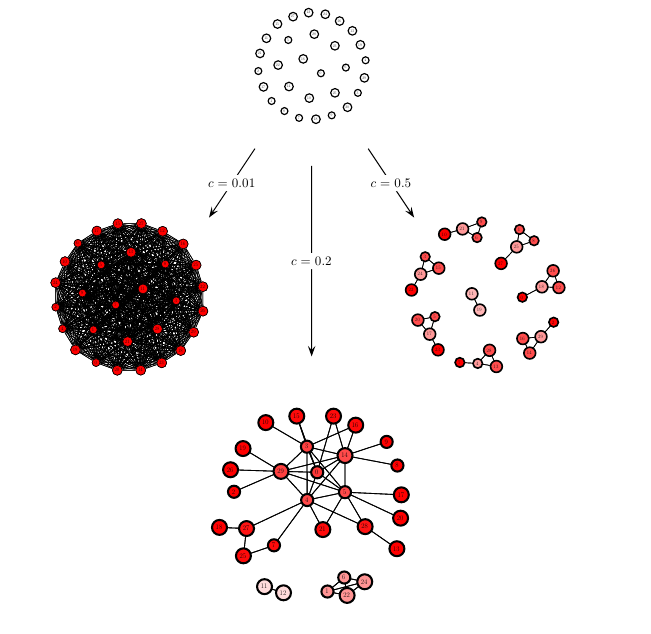
On Algebraic Graph Theory and the Dynamics of Innovation Networks
|
[2008]
|
|
Koenig, Michael D;
Battiston, Stefano;
Napoletano, Mauro;
Schweitzer, Frank
|
Networks and Heterogeneous Media,
pages: 201-- 219,
volume: 3,
number: 2
|
more» «less
|
Abstract
We investigate some of the properties and extensions of a dynamic innovation network model recently introduced in [Koenig et al. Games and Eco. Beh. 75-2 p694-p713 (2012)]. In the model, the set of efficient graphs ranges, depending on the cost for maintaining a link, from the complete graph to the (quasi-) star, varying within a well defined class of graphs. However, the interplay between dynamics on the nodes and topology of the network leads to equilibrium networks which are typically not efficient and are characterized, as observed in empirical studies of R&D networks, by sparseness, presence of clusters and heterogeneity of degree. In this paper, we analyze the relation between the growth rate of the knowledge stock of the agents from R&D collaborations and the properties of the adjacency matrix associated with the network of collaborations. By means of computer simulations we further investigate how the equilibrium network is affected by increasing the evaluation time $ tau$ over which agents evaluate whether to maintain a link or not. We show that only if $ tau$ is long enough, efficient networks can be obtained by the selfish link formation process of agents, otherwise the equilibrium network is inefficient. This work should assist in building a theoretical framework of R&D networks from which policies can be derived that aim at fostering efficient innovation networks.
A Model of a Trust-based Recommendation System in a Social Network
|
[2008]
|
|
Walter, Frank Edward;
Battiston, Stefano;
Schweitzer, Frank
|
JAAMAS,
pages: 57-- 74,
volume: 16,
number: 1
|
more» «less
|
Abstract
In this paper, we present a model of a trust-based recommendation system on a social network. The idea of the model is that agents use their social network to reach information and their trust relationships to filter it. We investigate how the dynamics of trust among agents affect the performance of the system by comparing it to a frequency-based recommendation system. Furthermore, we identify the impact of network density, preference heterogeneity among agents, and knowledge sparseness to be crucial factors for the performance of the system. The system self-organises in a state with performance near to the optimum; the performance on the global level is an emergent property of the system, achieved without explicit coordination from the local interactions of agents.

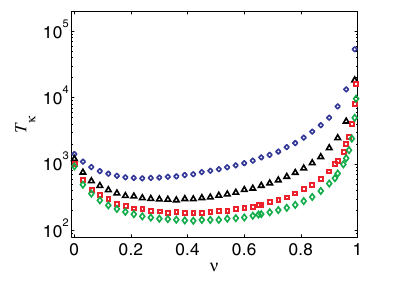
Slower is faster: Fostering consensus formation by heterogeneous interia
|
[2008]
|
|
Tessone, Claudio Juan;
Schweitzer, Frank
|
ACS - Advances in Complex Systems,
pages: 551-563,
volume: 11,
number: 4
|
more» «less
|
Abstract
We investigate an extension of the voter model in which voters are equipped with an individual inertia to change their opinion. This inertia depends on the persistence time of a voter's current opinion (ageing). We focus on the case of only two different inertia values: zero if a voter just changed towards a new opinion and nu otherwise. We are interested in the average time to reach consensus, i.e. the state in which all voters have adopted the same opinion. Adding inertia to the system means to slow down the dynamics at the voter's level, which should presumably lead to a slower consensus formation. As an unexpected outcome of our inertial voter dynamics, there is a parameter region of nu where an increasing inertia leads to a faster consensus formation. These results rest on the heterogeneity of voters which evolves through the described ageing. In a control setting of homogeneous inertia values, we only find monotonously increasing consensus times. In the paper, we present dynamical equations for the mean-field case which allow for analytical insight into the observed slower-is-faster effect.

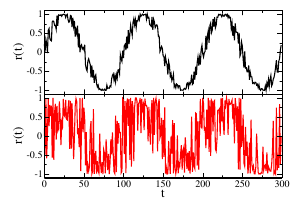
Risk-seeking versus risk-avoiding investments in noisy periodic environments
|
[2008]
|
|
Navarro - Barrientos, Jesus Emeterio;
Walter, Frank Edward;
Schweitzer, Frank
|
International Journal of Modern Physics C,
pages: 971-- 994,
volume: 19,
number: 6
|
more» «less
|
Abstract
We study the performance of various agent strategies in an artificial investment scenario. Agents are equipped with a budget, x(t), and at each time step invest a particular fraction, q(t), of their budget. The return on investment (RoI), r(t), is characterized by a periodic function with different types and levels of noise. Risk-avoiding agents choose their fraction q(t) proportional to the expected positive RoI, while risk-seeking agents always choose a maximum value qmax if they predict the RoI to be positive (“everything on red”). In addition to these different strategies, agents have different capabilities to predict the future r(t), dependent on their internal complexity. Here, we compare “zero-intelligent” agents using technical analysis (such as moving least squares) with agents using reinforcement learning or genetic algorithms to predict r(t). The performance of agents is measured by their average budget growth after a certain number of time steps. We present results of extensive computer simulations, which show that, for our given artificial environment, (i) the risk-seeking strategy outperforms the risk-avoiding one, and (ii) the genetic algorithm was able to find this optimal strategy itself, and thus outperforms other prediction approaches considered.


Investments in random environments
|
[2008]
|
|
Navarro - Barrientos, Jesus Emeterio;
Cantero, Ruben;
Rodrigues, Joao F.;
Schweitzer, Frank
|
Physica A,
pages: 2035-- 2046,
volume: 387,
number: 8-9
|
more» «less
|
Abstract
We present analytical investigations of a multiplicative stochastic process that models a simple investor dynamics in a random environment. The dynamics of the investor's budget, $x(t)$, depends on the stochasticity of the return on investment, $r(t)$, for which different model assumptions are discussed. The fat-tail distribution of the budget is investigated and compared with theoretical predictions. Weare mainly interested in the most probable value $x_mp$ of the budget that reaches a constant value over time. Based on an analytical investigation of the dynamics, we are able to predict $x_mp^stat$. We find a scaling law that relates the most probable value to the characteristic parameters describing the stochastic process. Our analytical results are confirmed by stochastic computer simulations that show a very good agreement with the predictions.

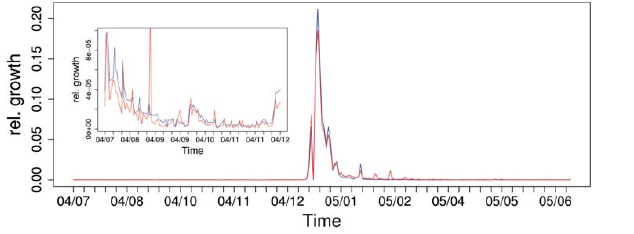
The epidemics of donations: Logistic growth and power-laws.
|
[2008]
|
|
Schweitzer, Frank;
Mach, Robert
|
PLOS ONE,
pages: e1458,
volume: 3,
number: 1
|
more» «less
|
Abstract
This paper demonstrates that collective social dynamics resulting from individual donations can be well described by an epidemic model. It captures the herding behavior in donations as a non-local interaction between individual via a time-dependent mean field representing the mass media. Our study is based on the statistical analysis of a unique dataset obtained before and after the tsunami disaster of 2004. We find a power-law behavior for the distributions of donations with similar exponents for different countries. Even more remarkably, we show that these exponents are the same before and after the tsunami, which accounts for some kind of universal behavior in donations independent of the actual event. We further show that the time-dependent change of both the number and the total amount of donations after the tsunami follows a logistic growth equation. As a new element, a time-dependent scaling factor appears in this equation which accounts for the growing lack of public interest after the disaster. The results of the model are underpinned by the data analysis and thus also allow for a quantification of the media influence.

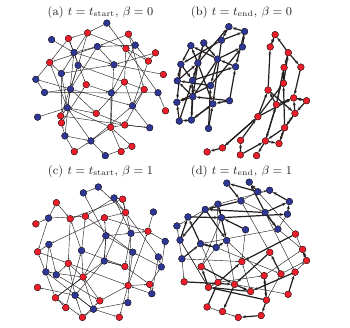
Coping with information overload through trust-based networks
|
[2008]
|
|
Walter, Frank Edward;
Battiston, Stefano;
Schweitzer, Frank
|
Managing Complexity: Insights, concepts, Applications
|
more» «less
|
Abstract
Over the recent decade, the Internet has conquered people’s homes and life: they pursue an increasing amount of activities on the World Wide Web and this has fundamentally impacted the lifestyle of society. For example, people use their computers for communication with others, to buy and sell products on-line, to search for information, and to carry out many more tasks. Along this development, so far unknown ways of marketing, trading and information sharing are booming. This situation is made possible by a set of related emerging technologies centred around the Internet – just to mention a few: collaborative work and information sharing environments, peer-to-peer networks, and rating, recommendation, and reputation systems. At the economic level, the impact of these technologies is already very high and it is expected to grow even more in the future. The Internet has become a social network, “linking people, organisations, and knowledge” [2] and it has taken the role of a platform on which people pursue an increasing amount of tasks that they have usually only done in the real-world. An approach looking at these emerging technologies and their effects from a complex systems perspective can, as wewill show in this chapter, be very useful.

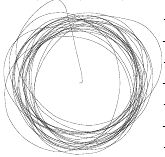
Modeling vortex swarming in daphnia
|
[2007]
|
|
Mach, Robert ;
Schweitzer, Frank
|
Bulletin of mathematical biology,
pages: 539-- 562,
volume: 69,
number: 2
|
more» «less
|
Abstract
Based on experimental observations in Daphnia, we introduce an agent-based model for the motion of single and swarms of animals. Each agent is described by a stochastic equation that also considers the conditions for active biological motion. An environmental potential further reflects local conditions for Daphnia, such as attraction to light sources. This model is sufficient to describe the observed cycling behavior of single Daphnia. To simulate vortex swarming of many Daphnia, i.e. the collective rotation of the swarm in one direction, we extend the model by considering avoidance of collisions. Two different ansatzes to model such a behavior are developed and compared. By means of computer simulations of a multi-agent system we show that local avoidance-as a special form of asymmetric repulsion between animals-leads to the emergence of a vortex swarm. The transition from uncorrelated rotation of single agents to the vortex swarming as a function of the swarm size is investigated. Eventually, some evidence of avoidance behavior in Daphnia is provided by comparing experimental and simulation results for two animals.


The nature of production and organisation An N/K model of modularity, (dis)integration and performance
|
[2007]
|
|
Press, Kerstin;
Geipel, Markus Michael;
Schweitzer, Frank
|
Druid: appropriability, proximity, routines and innovation
|
more» «less
|
Abstract
This paper investigates the link between product modularity and (dis)integration. A theoretic model benchmarks relative performance of (dis)integration for different degrees of modularity. As in existing work, (nearly) modular production processes befit disintegration while non-modular ones require integration. However, modularity and disintegration only lead to greater product differentiation if there is competition. Empirical evidence is then used to investigate, whether the link between product modularity and disintegration is encompassing or whether a role for some large, integrated firms (systems integrators) remains. This aspect is found to depend on the type of industry studied.

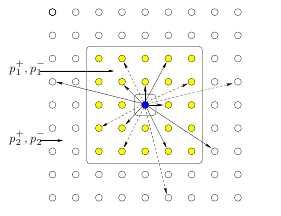
Coexistence of social norms based on in-and out-group interactions
|
[2007]
|
|
Groeber, Patrick;
Fent, Thomas;
Schweitzer, Frank
|
ACS - Advances in Complex Systems,
pages: 271-- 286,
volume: 10,
number: 2
|
more» «less
|
Abstract
The question how social norms can emerge from microscopic interactions between individuals is a key problem in social sciences to explain collective behavior. In this paper we propose an agent-based model to show that randomly distributed social behavior by way of local interaction converges to a state with a multimodal distribution of behavior. This can be interpreted as a coexistence of different social norms, a result that goes beyond previous investigations. The model is discrete in time and space, behavior is characterized in a continuous state space. The adaptation of social behavior by each agent is based on attractive and repulsive forces caused by friendly and adversary relations among agents. The model is analyzed both analytically and by means of spatio-temporal computer simulations. It provides conditions under which we find convergence towards a single norm, coexistence of two opposing norms, and coexistence of a multitude of norms. For the latter case, we also show the evolution of the spatio-temporal distribution of behavior.
Review of Biology, Sociology, Geology by Computational Physicists (Monograph Series on Nonlinear Science and Complexity)
|
[2007]
|
|
Schweitzer, Frank;
Geipel, Markus Michael
|
JASSS-The Journal of artificial societes and social simulation,
volume: 10,
number: 1
|
more» «less
|

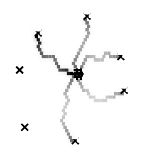
Multi-agent approach to the self-organization of networks
|
[2007]
|
|
Schweitzer, Frank
|
Understanding and Managing Complex Agent-Based Dynamical Networks
|
more» «less
|
Abstract
Is it possible to link a set of nodes without using preexisting positional information or any kind of long-range attraction of the nodes? Can the process of generating positional information, i.e. the detection of ``unknown'' nodes and the estabishment of chemical gradients, \emph{and} the process of network formation, i.e. the establishment of links between nodes, occur in parallel, on a comparable time scale, as a process of co-evolution? The paper discusses a model where the generation of relevant information for establishing the links between nodes results from the interaction of many \emph{agents}, i.e. subunits of the system that are capable of performing some activities. Their collective interaction is based on (indirect) communication, which also includes memory effects and the dissemination of information in the system. The relevant (``pragmatic'') information that leads to the establishment of the links then emerges from an evolutionary interplay of selection and reamplification.

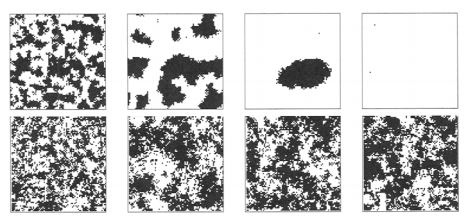
Collective decisions in multi-agent systems
|
[2007]
|
|
Schweitzer, Frank
|
Advancing Social Simulation: The First World Congress
|
more» «less
|
Abstract
Decision making, in a simple sense, means a selection among alternatives. It is one of the fundamental processes in economics but also in social systems. If these systems consist of many interacting elements — which we call agents here — the system dynamics may be described on two different levels: the microscopic level, where the decisions of the individual agents occur and the macroscopic level where a certain collective behavior can be observed.


Emergence and Evolution of Coalitions in Buyer-Seller Networks
|
[2007]
|
|
Walter, Frank Edward;
Battiston, Stefano;
Schweitzer, Frank
|
Emergent Intelligence of Networked Agents
|
more» «less
|
Abstract
We investigate the dynamics of the creation, development, and breakup of social networks formed by coalitions of agents. As an application, we consider coalition formation in a consumer electronic market. In our model, agents have benefits and costs from establishing a social network by participating in a coalition. Buyers benefit in terms of volume discount and better match of their preferences. Sellers benefit in terms of better predictability of sales volumes. The model allows us to investigate the stability and size of the coalitions as well as the performance of the market in terms of utility of the agents. We find that the system exhibits three different dominating regimes: individual purchasing behaviour, i.e., no social network exists among the agents, formation of several heterogenous coalitions, i.e., a number of social networks which are not connected, as well as condensation to a giant coalition, i.e., a social network involving all agents.

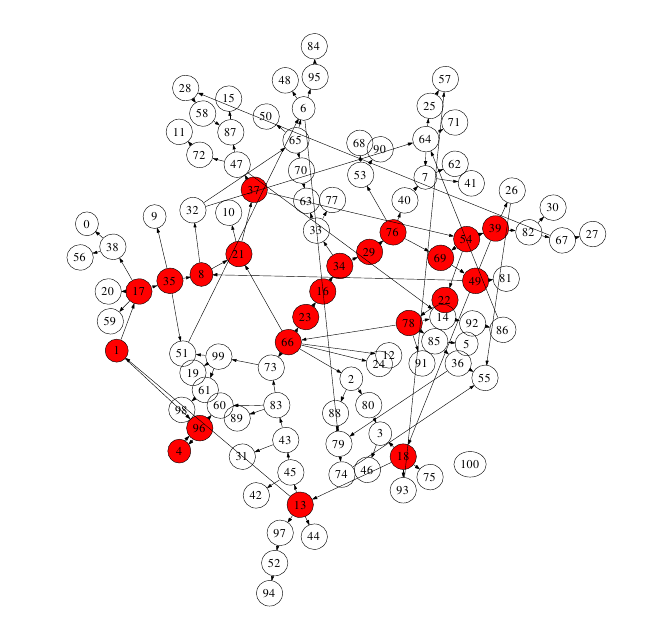
Aggregate dynamics in an evolutionary network model
|
[2007]
|
|
Seufert, A. M.;
Schweitzer, Frank
|
International Journal of Modern Physics C,
pages: 1659-- 1674,
volume: 18,
number: 10
|
more» «less
|
Abstract
We analyze a model of interacting agents (e.g. prebiotic chemical species) which are represented by nodes of a network, whereas their interactions are mapped onto directed links between these nodes. On a fast time scale, each agent follows an eigendynamics based on catalytic support from other nodes, whereas on a much slower time scale the network evolves through selection and mutation of its nodes-agent. In the first part of the paper, we explain the dynamics of the model by means of characteristic snapshots of the network evolution and confirm earlier findings on crashes and recoveries in the network structure. In the second part, we focus on the aggregate behavior of the network dynamics. We show that the disruptions in the network structure are smoothed out, so that the average evolution can be described by a growth regime followed by a satura-tion regime, without an initial random regime. For the saturation regime, we obtain a logarithmic scaling between the average connectivity per node ls and a parameter m, describing the average incoming connectivity, which is independent of the system size N.
Konkurrenz, Selektion und Innovation in oekonomischen Systemen
|
[2006]
|
|
Schweitzer, Frank;
Gerald, Silverberg
|
Irreversible Prozesse und Selbstorganisation
|
more» «less
|
Abstract
Bereits in den 1970er Jahren hat Ebeling gezeigt, dass Modelle der praebiotischen Evolution auch zur Beschreibung oekonomischer Systeme herangezogen werden koennen. Insbesondere konnten aus der Formalisierung von oekonomischen Theorien (Mehrwerttheorie von Marx, Innovationsdynamik von Nelson und Winter) Gleichungen fuer die Konkurrenz von Produzenten bzw. Technologien hergeleitet werden. Diese Ergebnisse werden hier zusammengefasst und gewuerdigt. Im zweiten Teil des Aufsatzes diskutieren wir neuere Ansaetze, um Innovation und Selektion in oekonomischen Systemen zu modellieren-wohei die Beziehungen zu Netzwerken und zu biologischen Evolutionsmodellen im Vordergund stehen.
Impact of Trust on the Performance of a Recommendation System in a Social Network
|
[2006]
|
|
Battiston, Stefano;
Walter, Frank Edward;
Schweitzer, Frank
|
Proceedings of the Workshop on Trust at the Fifth International Joint Conference on Autonomous Agents and Multi-Agent Systems (AAMAS'06)
|
more» «less
|
Abstract
Social agents naturally use their social and professional networks to filter information
by trustworthiness. In this paper, we present a model of an automated distributed recom-
mendation system on a social network and we investigate how the dynamics of trust among
agents affect the performance of the system. Agents search their social network for recom-
mendations on items to be consumed and the propagation of the query through agents at
several degrees of separation enhances the efficiency of their search. Moreover, agents have
heterogeneous preferences so that trust between neighbours can be used to filter information
coming from remote agents. We identify the range of the density of the network and the
degree of heterogeneity of agent preferences in which trust improves the performance of the
recommendation system.

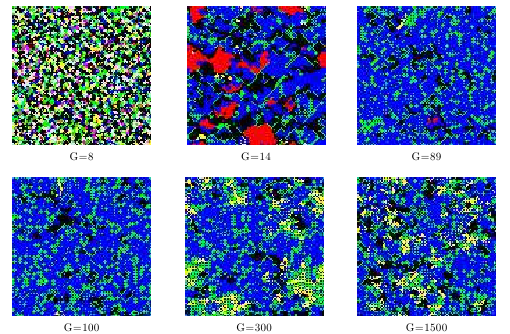
Agents with heterogeneous strategies interacting in a spatial IPD
|
[2005]
|
|
Schweitzer, Frank;
Mach, Robert ;
Heinz, Muehlenbein
|
Lecture Notes in Economics and Mathematical Systems
|
more» «less
|
Abstract
We use a spatial iterated Prisoner’s Dilemma game (IPD) to investigate the spatial-temporal evolution of heterogeneity in agents’ strategies. In our model, N agents are spatially distributed on a lattice and each agent is assumed to interact with her 4 local neighbors a number of ng times during each generation. If the agent has a one-step memory for the last action of each individual neighbor, this results in a total of eight different strategies for the game. After each generation, the agent will be replaced by an offspring that adopts the strategy of her most successful neighbor. The agents are heterogeneous in that they play different strategies dependent on (i) their past experience, (ii) their local neighborhood. The spatial-temporal distribution of these strategies is investigated by means of computer simulations on a cellular automaton. In particular, we study the incluence of ng on the dynamics of the global frequencies of the different strategies and the conditions for a stationary (frozen) or non-stationary (dynamic) coexistence of particular strategies on a spatial scale.
Coordination of decisions in a spatial model of brownian agents
|
[2004]
|
|
Schweitzer, Frank
|
The Complex Dynamics of Economic Interaction Lecture Notes in Economics and Mathematical Systems vol 531
|
more» «less
|
Abstract
Brownian agents denote a particular class of heterogeneous agents that combines features of reactive and reflexive agent concepts. As one major advance, the Brownian agent concept allows the derivation of macroscopic equations from the agent dynamics, which can be used to analyze and predict the behavior of the MAS. As an application of the concept, we discuss a binary choice problem where individual decisions are based on different local information generated by the agents. The spatial coordination of decisions in a multi-agent community is investigated both analytically and by means of stochastic computer simulations. We find that dependent on two essential parameters describing the local impact and the spatial dissemination of information either a definite stable minority/majority relation (single-attractor regime) or a broad range of possible values (multi-attractor regime) occurs. In the latter case, the outcome of the decision process becomes rather diverse and hard to predict, both with respect to the fraction of the majority and their spatial distribution. We also show that a more “efficient” information dissemination of a subpopulation provides a suitable way to stabilize their majority status and to reduce “diversity” and uncertainty in the decision process.
Talks»
«Talks
Talks
DemocraSci - 127 Years of the Swiss Parliament
[May 20, 2019]
Swiss Federal Archives, Berne, Switzerland
DemocraSci - Greetings from the Swiss Parliament
[May 13, 2019]
Project Information Day, Swiss Data Science Center, Berne, Switzerland
Quantifying social systems: From insights to impact
[April 26, 2019]
Symposium "Computational Social Science - Quo Vadis?", Department of Informatics, University of Zurich, Switzerland
Activity Matters: An Agent-based Framework of Active Matter with Applications in Biological and Social Systems
[Jan. 23, 2019]
Institute for Theoretical Physics, University of Bremen, Germany
Das Briefkorrespondenznetzwerk der Reformatoren
[Jan. 21, 2019 - Jan. 22, 2019]
Historical letter workshop, Heidelberg
"Ich sehe was, das du nicht siehst"? - Welche Informationen kann die Netzwerkanalyse liefern?
[Jan. 21, 2019]
Heidelberger Akademie der Wissenschaften, Heidelberg, Germany
Data-Driven Modeling of Social and Economic Interactions
[Nov. 19, 2018]
Seminar "Computational Social Science", ETH Zurich, Switzerland
Activity Matters: An Agent-based Framework of Active Matter with Applications in Biological and Social Systems
[Nov. 16, 2018]
MPIDS Seminar, Max Planck Institute for Dynamics and Self-Organization, Göttingen, Germany
Kooperationsnetzwerke von Firmen und von Wissenschaftlern: Was sagen die Daten, die Modelle - und die Ökonomen?
[Nov. 15, 2018]
Ringvorlesung "Caring, Sharing, Cooperation", Universität Göttingen, Germany
Doppelte Botschaften: Wie Emotionen unsere Online-Mitteilungen beeinflussen
[Oct. 4, 2018]
Senioren-Universität, Universität Zurich, Switzerland
Activity Matters: Modeling complex systems beyond complex networks (invited talk)
[Sept. 23, 2018 - Sept. 28, 2018]
Conference on Complex Systems - CSS 2018, Thessaloniki, Greece
Reputation, Ownership and Control (invited talk)
[Sept. 12, 2018 - Sept. 14, 2018]
Econophysics Colloquium 2018, Palermo, Italy
How can we benefit from the complex network approach to economic systems? (invited talk)
[Aug. 29, 2018 - Aug. 31, 2018]
Asia Pacific Econophysics Conference, Chinese Culture University, Taipei, Taiwan
Activity Matters - An Agent-based Framework of Active Matter with Applications in Biological and Social Systems
[Aug. 27, 2018]
Department of Physics, Hongkong University of Science and Technology, Hongkong
Quantifying Resilience of Social Organizations
[June 7, 2018 - June 9, 2018]
Complexity Science Hub Workshop "Improving Resilience in Complex Systems", Vienna, Austria
What is the productivity of research teams?
[May 24, 2018]
Complexity Science Hub Conference "Complexity - Where do we go from here?" Vienna, Austria
The rise and fall of firm collaborations - Insights from a large-scale analysis of R&D networks
[March 29, 2018]
Data-Driven Innovation Lab, Singapore University of Technology and Design, Singapore
Quantifying resilience of social organizations
[March 26, 2018]
FRS Lunch Talk, Singapore-ETH-Centre, CREATE, Singapore
Kollektive Dynamik in Sozialen Systemen: Netzwerke, Emotionen und Big Data (plenary talk)
[March 11, 2018 - March 16, 2018]
DPG-Frühjahrstagung, Berlin, Germany
Precursors of conflict: Measuring polarization
[Jan. 26, 2018]
6th Risk Center Dialogue Event: Big data, big promises: The next generation of conflict forecasting, ETH Zurich, Switzerland
Spreading influence in social networks: From link-centric to node-centric models (keynote)
[Nov. 29, 2017 - Dec. 1, 2017]
6th International Conference on Complex Networks and Their Applications, Lyon, France
Quantifying resilience of social organizations
[Nov. 14, 2017]
ETH Risk Center Seminar Series, ETH Zurich, Switzerland
The rise and fall of firm collaborations - Insights from a large-scale analysis of R&D networks
[March 20, 2017]
Department of Economics, National Chengchi University, Taipei, Taiwan
The rise and fall of firm collaborations - Insights from a large-scale analysis of R&D networks
[March 16, 2017]
Departmental Research Seminar, Department of Management and Marketing & Department of Logistics and Maritime Studies, Hong Kong Polytechnic University, Hong Kong
Spreading influence in social networks: From link-centric to node-centric models
[March 15, 2017]
Workshop on Complex and Social Networks, Department of Computer Science and Engineering, Indian Institute of Technology, Kharagpur, India
Spreading influence in social networks: From link-centric to node-centric models
[March 14, 2017]
Department of Electrical Engineering, Indian Institute of Technology, Kanpur, India
How can we benefit from the complex network approach to socio-economic systems?
[March 10, 2017]
Dayalbagh Educational Institute (Deemed University), Agra, India
How can we benefit from the complex network approach to socio-economic systems?
[March 6, 2017]
Department of Computer Science and Engineering, National Institute of Technology, Delhi, India
Ökonophysik - Perspektiven einer konfliktreichen Beziehung
[Jan. 25, 2017]
Bad Honnefer Industriegespräche, Physikzentrum Bad Honnef, Germany
Resilience of Social Organizations
[Dec. 11, 2016 - Dec. 13, 2016]
Workshop "Social Network Analysis: Law, Institutions and Transnational Governance", Tel Aviv, Israel
Mastering the Challenges of our Digital Society
[Nov. 4, 2016]
Risk Center Workshop, Zurich, Switzerland
The collaboration network of Werner Ebeling
[Oct. 21, 2016]
BCS CCS Colloquium "Irreversible Processes and Self-Organization", Berlin, Germany
Modellierung sozio-ökonomischer Systeme
[Oct. 1, 2016]
Tagung "Ordnung im Chaos - Physik komplexer Systeme", Ebermannstadt, Germany
Modeling emotional agents: Data, Interaction, Simulation
[Sept. 19, 2016 - Sept. 23, 2016]
Invited talk at Social Simulation Conference, Rome, Italy
Resilience of social organizations, Visions for Complexity
[May 23, 2016]
Opening conference of the Complexity Science Hub, Vienna, Austria
Engineering social systems: Networks, control and big data
[April 21, 2016 - April 22, 2016]
CESUN Europe Event "Comprehensive Engineering: Systems and Social Science - Humanities - Big data - Complexity", Delft, Netherlands
With a little help from your friends: The impact of social networks on publication success
[March 8, 2016 - March 11, 2016]
PEERE Meeting on "Taking stock of peer review" and 2nd Workshop on Simulating the Social Processes of Science (SSPOS II), Valencia, Spain
A multi-layer network perspective on systemic risk
[Jan. 28, 2016 - Jan. 29, 2016]
Macro Financial Modeling Winter 2016 Meeting, NYU Stern School of Business, New York, NY, USA
(Re)constructing economic networks: What is missing in big data?
[Nov. 23, 2015]
Workshop "Complexity and Big Data in Finance", Delft Data Science, Delft University of Technology, The Netherlands
Let's TWEET about Bitcoin: How social signals drive the Bitcoin price
[Nov. 18, 2015]
ETH Alumni Math Phys Lecture 2015: "Bitcoin - flip oder flop?", ETH Zurich, Switzerland
Systemic risks for privacy in online interaction
[Nov. 2, 2015]
ETH Risk Center Partnership Council, ETH Zurich, Switzerland
Networks at work: The systemic feedback on scientific quality
[Nov. 1, 2015 - Nov. 2, 2015]
2nd Workshop "Governance of Science: The (Mis-)Measurement of Scientific Quality", Hannover, Germany
Networks at work: The systemic feedback on scientific quality
[Oct. 7, 2015 - Oct. 9, 2015]
Conference From Data to Knowledge, Mons, Belgium
How can we benefit from the complex network approach to economic systems?
[Sept. 17, 2015 - Sept. 19, 2015]
EAEPE - European Association for Evolutionary Political Economy, Annual Conference, Genoa, Italy
Agent-based modeling of R&D networks: Simulation, calibration, validation
[Sept. 14, 2015 - Sept. 16, 2015]
Econophysics Colloquium 2015, Prague, Czech Republic
Predicting scientific success based on coauthorship networks
[June 2, 2015]
Satellite Workshop "Dynamics on and of Complex Networks VIII", NetSci 2015, Zaragoza, Spain
The rise and fall of collaborations - Insights from a large-scale analysis of R& D networks
[June 1, 2015 - June 5, 2015]
International School and Conference on Network Science (NetSci 2015), Zaragoza, Spain
Stability, adaptation and control - An application to complex social networks
[May 26, 2015]
Physikalisches Kolloquium, University of Konstanz, Germany
Agent-based modeling of collaboration networks: How models meet data
[May 21, 2015 - May 23, 2015]
"20th Annual Workshop on the Economic Science with Heterogeneous Interacting Agents" (WEHIA) Sophia Antipolis, France
Activity Matters: Mobility, Communication, Collective Emotions
[May 20, 2015 - May 22, 2015]
CECAM Workshop "Collective dynamics in physics, biology and social sciences" University College Dublin, Ireland
Resilience of Social Organizations - Measures, Models, Mechanisms
[May 12, 2015]
ETH Risk Center Seminar Series, ETH Zurich, Switzerland
The limits to scaling - and how to get beyond
[May 8, 2015 - May 9, 2015]
Symposium "Too big to scale", Zürcher Hochschule der Künste, Zurich, Switzerland
Science is done by people
[April 21, 2015 - April 22, 2015]
Workshop "The peer review past, present and future", ETH Zurich, Switzerland
Predicting systemic risk in complex networks
[March 25, 2015]
School of Reliability and Systems Engineering, Beijing University of Aeronautics and Astronautics (Beihang University), Beijing, China
Predicting success in collaboration networks
[March 24, 2015]
Department of Systems Science, School of Management, Beijing Normal University, Beijing, China
Modeling emotional agents: Data, Interaction, Simulation
[Feb. 4, 2015]
School of Physics and Astronomy, Tel Aviv University, Tel Aviv, Israel
Predicting systemic risk - Cascading processes in complex networks
[Feb. 3, 2015]
Department of Mathematics, Bar-Ilan University, Ramat-Gan, Israel
Modeling emotional agents: Data, Interaction, Simulation
[Dec. 1, 2014]
GESIS - Leibniz-Institut für Sozialwissenschaften Köln
How we collaborate - A complex network approach
[Nov. 24, 2014 - Nov. 26, 2014]
Second Annual KnowEscape Conference, Thessaloniki, Greece
Introduction to systems thinking and dynamics
[Oct. 2, 2014]
The Club of Rome, Impact Hub Zürich
How we collaborate - A complex network approach
[June 4, 2014]
International School and Conference on Network Science (NetSci 2014), Berkeley, California CA, USA
Beyond aggregated networks - What we got wrong and will have to get right
[June 3, 2014]
Satellite Workshop: Higher-Order Models in Network Science, NetSci 2014, Berkeley CA, USA
Analysing temporal bipartite social networks
[June 2, 2014]
Satellite Workshop: Multiple Network Modeling, Analysis and Mining, NetSci 2014, Berkeley CA, USA
Modeling user behavior in online social network
[May 27, 2014]
AI Seminar, Information Science Institute, University of Southern California, Marina del Rey CA, USA
Success and failure - A complex network approach
[May 9, 2014]
Institute for Theoretical Physics, Wroclaw University, Wroclaw, Poland
Beyond simulating science - What do we learn from data? And how do we verify our models?
[April 7, 2014]
Lorentz Centre Workshop Simulating the Social Processes of Science, Leiden, The Netherlands
Predicting systemic risk - Cascading processes in complex networks
[March 21, 2014]
Physikalisches Kolloquium, University of Basel, Basel, Switzerland
Making better use of online media for marketing - Collective emotions and social influence in product reviews
[March 19, 2014]
Seminar: IT for Marketing Management, Zurich, Switzerland
Utilizing Social Influence: Empirics and Modeling
[Dec. 6, 2013]
Research Seminar, Institute for Futures Studies, Stockholm, Sweden
Selbstorganisation und Evolution im Spiegel von Faust II
[Nov. 28, 2013]
Forschungskolloquium, Collegium Helveticum, Zurich, Switzerland
The rise and fall of collaborations: Insights from a large-scale analysis of R&D networks
[Nov. 18, 2013 - Nov. 19, 2013]
ESHIA Winter Workshop, Nanyang TEchnological University, Singapore
The rise and fall of collaborations: Insights from a large-scale analysis of R&D networks
[Nov. 14, 2013]
KAIST Globar Seminar, Department of Management Science, Korean Advanced Institute for Science and Technology (KAIST), Deajeon, Korea
Cascading process in complex networks: From systemic risk in banking networks to the collapse of Friendster
[Nov. 13, 2013]
Colloquium talk, Physics Department, Pohang University of Science and Technology (POSTECH), Pohang, Korea
Cascading process in complex networks: From systemic risk in banking networks to the collapse of Friendster
[Nov. 11, 2013]
Physics Department, Seoul National University, Seoul, Korea
Success and Failure: A Complex Network Perspective, Complexity Forum, Centre of Complexity Science}
[Oct. 23, 2013]
University of Warwick, UK
Merging the Known and the Unknown - The Concept of Brownian Agents, Conference "Probabilistic Modeling in Science and Philosophy"
[Oct. 12, 2013 - Oct. 12, 2013]
Oeschger Centre for Climate Change Research, University of Bern, Switzerland
Success and Failure: A Complex Network Approach
[Sept. 13, 2013 - Sept. 15, 2013]
2013 Chinese Conference 'Complex Networks', HangZhou, China
Predicting Success
[June 28, 2013]
ISI Torino/CRT Foundation, Torino, Italy
Doppelte Botschaften - Wie Emotionen unsere Online-Mitteilungen beeinflussen
[April 14, 2013]
Treffpunkt Science City: Kommunikation - Zeichen, Sprachen, Botschaften, Zurich, Switzerland
Modeling Systemic Risk
[April 9, 2013]
Workshop on Complexity Models for Systemic Instabilities and Crises , Leiden, Netherlands
Collective Dynamics in Cyberspace: Chaos or Order?
[Jan. 9, 2013]
Physikalisches Kolloquium, University of Chemnitz, Chemnitz, Germany
Model validation for multilevel economic networks
[Nov. 19, 2012]
Foundational Research on Multilevel Complex Networks and Systems (MULTIPLEX) Kickoff Meeting, Lucca, Italy
Systemic Risk in Economic and Financial Networks
[July 11, 2012 - July 13, 2012]
COST MP0801 Annual Meeting, National University of Ireland, Galway, Ireland
Can we design social herding to enhance cooperation?
[July 2, 2012 - July 4, 2012]
Workshop on Agent-Based Models and Complex Techno-Social Systems, ETH Zurich, Switzerland
The next level of modeling social interaction: How to detect, quantify and utilize emotional influence
[June 5, 2012]
Aalto Complexity Networks Factory, Sannäs, Finland
Systemic Risk in Economic and Financial Networks
[June 5, 2012]
Aalto Systems Forum, Aalto School of Economics, Aalto University, Helsinki, Finland
Systemic risk
[April 24, 2012]
ETH Risk Center Seminar Series, ETH Zurich, Switzerland
The Wisdom of Crowds Effect at Work: The Good, The Bad, and The Ugly
[March 25, 2012 - March 30, 2012]
Deutsche Physikalische Gesellschaft (DPG) Annual Conference, Berlin, Germany
Response to social norms enhancement by heterogeneous populations
[March 25, 2012 - March 30, 2012]
Deutsche Physikalische Gesellschaft (DPG) Annual Conference, Berlin, Germany
When it pays off to pay tax: Insights from coupled multiplicative stochastic processes
[March 25, 2012 - March 30, 2012]
Deutsche Physikalische Gesellschaft (DPG) Annual Conference, Berlin, Germany
Sociophysics models of emotions in blog debates, newsgroups, and MySpace discussions
[March 16, 2012]
Review Meeting "Cyberemotions", Brussels, Belgium
The surprising power of social influence in the digital age
[Dec. 1, 2011]
U.S.-Swiss Dialogue, NYU Stern School of Business, New York University, New York NY, USA
Our Friends, our beliefs, our emotions: How computational social science reads our digital traces
[Nov. 29, 2011]
ETH Alumni NEC & Swissnex, Boston MA, USA
The next level of modeling social interaction: How to detect, quantify and utilize emotional influence
[Nov. 22, 2011]
Laboratory for Information and Decision Systems Seminar, MIT, Cambridge MA, USA
Collective Emotions on the Internet - How to quantify and model emotional influence
[Nov. 18, 2011]
The School of Informatics and Computing Colloquium Series, Indiana University, Bloomington IL, USA
Systemic risk in economic and financial networks
[Nov. 17, 2011]
School of Industrial Engineering Seminar, Purdue University, West Lafayette IN, USA
The next level of modeling social interaction: How to detect, quantify and utilize emotional influence
[Nov. 16, 2011]
Northwestern Institute on Complex Systems Seminars, Northwestern University, Evanston IL, USA
Systemic risk in economic and financial networks
[Oct. 21, 2011]
Special Seminar, Laboratory for Information and Decision Systems, MIT, Cambridge MA, USA
The next level of modeling social interaction: How to detect, quantify and utilize emotional influence
[Oct. 17, 2011]
Center for Complex Network Research & Barabasi Lab Seminar, Northeastern University, Boston MA, USA
Open source software as a complex network
[Oct. 4, 2011]
Center for the Study of Complex Systems Seminar Series, University of Michigan, Ann Arbor MI, USA
SocioAware Agents -- Better Agents?
[Oct. 3, 2011 - Oct. 7, 2011]
Distinguished Lecture, 1st International Workshop on Socio-Aware Networked Computing Systems, 5th IEEE International Conference on Self-Adaptive and Self-Organizing Systems, Ann Arbor MI, USA
Open source software as a complex network
[Aug. 11, 2011]
Division of Computer Science, Nanyang Technological University, Singapore
Systemic risk in economic networks
[Aug. 4, 2011 - Aug. 6, 2011]
Singapore Economic Review Conference, Singapore
The risk to fail
[June 20, 2011 - June 23, 2011]
International Workshop 'Coping with Crises in Complex Socio-Economic Systems', Zurich, Switzerland
An Agent-based Model of Collective Emotions in Online Communities
[May 3, 2011]
Department of Biological Physics, Eötvös Lorand University, Budapest, Hungary
Sociophysics models of collective emotions in online communities
[March 21, 2011]
Review Meeting "Cyberemotions", Brussels, Belgium
Collective Dynamics of Firms: A Statistical Physics Approach, Tutorial
[March 13, 2011 - March 18, 2011]
Deutsche Physikalische Gesellschaft (DPG) Annual Conference, Dresden, Germany
An Agent-Based Model of Collective Emotions in Online Communities
[March 13, 2011 - March 18, 2011]
Deutsche Physikalische Gesellschaft (DPG) Annual Conference, Dresden, Germany
Systemic Risk in Economic Networks
[Dec. 8, 2010 - Dec. 10, 2010]
ESF SCSS Exploratory Workshop: Information and Behaviour in Networks, Oxford, UK
Public Lecture: Complex Networks
[Nov. 26, 2010]
Department of Physics, University of Vienna, Vienna, Austria
Modeling Collective Emotions: A Stochastic Approach Based on Brownian Agents
[Nov. 26, 2010 - Nov. 28, 2010]
COST MP0801 Workshop "Complex Stochastic Dynamics", Vienna, Austria
Modeling Collective Emotions in Online Communities
[Nov. 9, 2010]
CCSS Seminar "Modeling Complex Socio-Economic Systems and Crises", ETH Zurich, Zurich, Switzerland
Research on Systemic Risk: Contributions of ETH Zurich to FOC
[Oct. 12, 2010 - Oct. 13, 2010]
FOC Kickoff Meeting, Rome, Italy
Special Lectures: Collective Dynamics of Firms
[Oct. 4, 2010]
Graduate School of System Design and Management, Keio University, Yokohama, Japan
The Hidden Complexity of Open Source Software
[Sept. 30, 2010]
Business School, University of Science and Technology, Shanghai, China
Brownian Motion Scaled Up: Einstein's Theory and the Collective Dynamics of Brownian Agents
[Sept. 29, 2010]
The Nobel Lectures at the 'Albert Einstein' Exhibition, China Science and Technology Museum No 5, Beijing, China
Personalized and Dynamic Trust in Social Networks
[June 29, 2010 - July 4, 2010]
Sunbelt XXX Social Networks Conference, Riva del Garda, Italy
Open Source Software as a Complex Network
[May 26, 2010 - May 28, 2010]
COST MP 0801 Second Annual Meeting, Sunny Beach, Bulgaria
Open Source Software: Networks of Social and Functional Dependencies
[May 10, 2010 - May 14, 2010]
The International Workshop and Conference on Network Science (NetSci) School and Conference, Boston, USA
The hidden complexity of open source software
[March 21, 2010 - March 26, 2010]
Deutsche Physikalische Gesellschaft (DPG) conference, Regensburg, Germany
OSS Projects - Software Structure, Dynamics, Communivation
[March 14, 2010 - March 19, 2010]
Workshop Mining Software Archives, Ascona, Switzerland
Economic Networks: Micro and Macro Perspectives
[March 8, 2010]
Interdisciplinary Colloquium, Jacobs University Bremen, Bremen, Germany
Modeling Collective Emotions in Cyberspace
[Jan. 21, 2010 - Jan. 23, 2010]
Project Workshop Cyberemotions, Wolverhampton, UK
Modeling collective interactions in social systems
[Nov. 30, 2009]
Workshop 'Simulating Complex Organizations', Center for Advanced Studies, Ludwig-Maximilian University Munich, Munich, Germany
Predicting Systemic Risk: The role of contagion and cascades
[Nov. 4, 2009 - Nov. 7, 2009]
9th Asia-Pacific Complex Systems Conference Complex'09, Tokyo, Japan
Economic Networks: Mirco and Macro Perspectives
[Sept. 28, 2009 - Sept. 30, 2009]
Symposium: Fraontiers in Network Science, Berlin, Germany
Mechanismus of systemic risk: Contagion, reinforcement, redistribution
[Aug. 31, 2009 - Sept. 12, 2009]
Conference: Complexity, Mathematics and Socio-Economic Problems, Bielefeld, Germany
Economic Networks: Micro and Macro Perspectives
[June 29, 2009 - July 3, 2009]
The International Workshop and Conference on Network Science (NetSci), Venice, Italy
Mechanisms of Systemic Risk: Contagion, Reinforcement, Redistribution
[May 28, 2009 - May 30, 2009]
NET 2009: Evolution of Complexity & COST MP0801 Meeting, Rome, Italy
Mechanisms of Systemic Risk: Contagion, Reinforcement, Redistribution
[Feb. 23, 2009 - Feb. 25, 2009]
Complex’2009 - The First International Conference on Complex Sciences: Theory and Applications, Shanghai, China
Modeling Collective Interactions in Social Systems
[Feb. 12, 2009 - Feb. 14, 2009]
Cyberemotions Kickoff Meeting, Warsaw, Poland
Nonlinear Voter Models: The Transition from Invasion to Coexistence
[Dec. 1, 2008 - Dec. 5, 2008]
XVI Conference on Nonequilibrium Statistical Mechanics and Nonlinear Physics (MEDYFINOL'08), Punta del Este, Uruguay
Dynamics of Economic Networks
[Nov. 25, 2008 - Nov. 29, 2008]
Conference: Physics Applied to Economics and Social Sciences (PAESS'08), Porto Alegre, Brazil
Evolving social networks: The influence of costs benefits, and preferences
[Sept. 12, 2008 - Sept. 13, 2008]
5th Conference on Applications of Social Network Analysis (ASNA), Zurich, Switzerland
Collective Dynamics of Companies - A Complex Systems Perspective, Part 1: Models of Company Growth
[Aug. 30, 2008 - Sept. 8, 2008]
Summer School: Non-Equilibrium Dynamics of Large-Scale Complex Systems, Ambleside, UK
Collective Dynamics of Companies - A Complex Systems Perspective, Part 2: Models of Company Interaction
[Aug. 30, 2008 - Sept. 8, 2008]
Summer School: Non-Equilibrium Dynamics of Large-Scale Complex Systems, Ambleside, UK
The costs of interaction - and how they shape the social network
[Aug. 18, 2008 - Aug. 23, 2008]
International Workshop on Challenges and Visions in the Social Sciences, ETH Zurich, Zurich, Switzerland
Modellierung komplexer Systeme - Von der Physik zu den Sozialwissenschaften
[May 13, 2008]
Senioren-Universität Zürich, University of Zurich, Zurich, Switzerland
Decelerating microdynamics accelerates macrodynamics in the voter model, Section Dynamics and Statistical Physics (DY)
[Feb. 26, 2008]
February meeting of the German Physical Society (DPG), Berlin, Germany
Enforcing consensus formation by heterogeneous inertia to change opinion
[Feb. 25, 2008]
Annual Conference Physics of Socio-Economic Systems (AKSOE), February meeting of the German Physical Society (DPG), Berlin, Germany
Efficiency and Stability of Dynamic Innovation Networks
[Feb. 25, 2008]
Annual Conference Physics of Socio-Economic Systems (AKSOE), February meeting of the German Physical Society (DPG), Berlin, Germany
Evolution of economic networks, 401
[Jan. 21, 2008 - Jan. 23, 2008]
WE-Heraeus-Seminar, Physikzentrum Bad Honnef, Bad Honnef, Germany
Enhancing social interaction: preferences, similarities, and trust
[Jan. 9, 2008 - Jan. 12, 2008]
Workshop on "Is there a Physics of Society?", Santa Fe Institute, Santa Fe NM, USA
Designing Social Interactions Based on Trust and Reputation
[Nov. 27, 2007]
Colloquium 'Selected Challenges in the Social Sciences: Modeling and Simulation Approaches', ETH Zurich, Zurich, Switzerland
Gibt es eine Physik sozio-ökonomischer Systeme?
[Nov. 12, 2007]
Physikalisches Kolloquium, Julius-Maximilians-Universität Würzburg, Würzburg, Germany
Models of Firm Networks
[Oct. 4, 2007]
Satellite Workshop: "Dynamics On and Of Complex Networks", European Conference on Complex Systems (ECCS), Dresden, Germany
Efficiency and Stability of Evolving Innovation Networks
[Oct. 1, 2007 - Oct. 3, 2007]
European Conference on Complex Systems (ECCS), Dresden, Germany
Empirics and Models of Firm Networks
[Sept. 27, 2007 - Sept. 29, 2007]
Econophysics Colloquium and Beyond, Ancona, Italy
Emergence of social norms from collective agent interaction
[Sept. 6, 2007 - Sept. 8, 2007]
International Conference on Rational Choice and Social Institutions, Zurich, Switzerland
Physics in social sciences
[Aug. 24, 2007]
6th PSI Summer School on Condensed Matter Research, Zuoz, Switzerland
Gibt es Gesetzmässigkeiten für komplexe Systeme? - Ein Blick auf sozio-ökonomische Beispiele, öffentliche Vortragsreihe: Komplexe technische Systeme
[June 6, 2007]
ETH Zurich, Zurich, Switzerland
Modeling Economic Networks Theoretical Physics Seminar
[April 30, 2007]
University of Fribourg, Fribourg, Switzerland
Applying directed weighted networks to recommendation systems, Section Dynamics and Statistical Physics (DY)
[March 26, 2007 - March 30, 2007]
March meeting of the German Physical Society (DPG), Regensburg, Germany
A Trust-based recommendation system on a social network
[March 26, 2007 - March 30, 2007]
Annual Conference Physics of Socio-Economic Systems (AKSOE), March meeting of the German Physical Society (DPG), Regensburg, Germany
Sociophysics -- Science or Fiction?
[Feb. 3, 2007 - Feb. 8, 2007]
Edgar-Lüscher-Seminar, Klosters, Switzerland
Empirics and Models of Firm Networks
[Jan. 29, 2007]
CER-ETH Economics Research Seminar, ETH Zurich, Zurich, Switzerland
Modeling of socio-economic systems: A new branch of physics?
[Dec. 11, 2006]
Lise-Meitner Colloquium, Hahn-Meitner Institute, Berlin, Germany
The Role of Local Effects in Collective Decision Processes
[Nov. 20, 2006 - Nov. 23, 2006]
Toyota CRDL Workshop "Decision Making and Uncertainty in Nonlinear Complex Systems", Copenhagen, Denmark
The Role of Heterogeneity in Collective Decision Processes
[Sept. 28, 2006 - Sept. 29, 2006]
Satellite Workshop: Complex Adaptive Systems and Interacting Agents (CASIA), European Conference on Complex Systems (ECCS), Oxford, UK
Impact of Trust on the Performance of a Recommendation System in a Social Network
[Sept. 25, 2006 - Sept. 27, 2006]
European Conference on Complex Systems (ECCS), Oxford, UK
Übergang zur Kooperation, Ehrenkolloquium "Physik der Selbstorganisation"
[Sept. 15, 2006]
Institut für Physik, Humboldt-Universität, Berlin, Germany
Dynamik und Steuerbarkeit komplexer Systeme
[Aug. 24, 2006 - Aug. 26, 2006]
Plenum "Konvergenz und Komplexität in Wissenschaft und Technologie", Alpbacher Technologiegespräche, Alpbach, Austria
Collective Decisions in Mulit-Agent Systems
[Aug. 21, 2006 - Aug. 25, 2006]
First World Congress on Social Simulation, Kyoto, Japan
Network Models of Cooperation
[Aug. 19, 2006]
2st-Century Center of Excellence Program "Creation of agent-based social systems sciences", Tokyo Institute of Technology, Tokyo, Japan
Modeling Complex Systems: On the Uses and Disadvantages of Selforganization
[June 28, 2006]
Colloquium ``What is Design? What is Modeling?'', ETH Competence Center for Digital Design & Modeling, Zurich, Switzerland
Coalition Formation in Buyer-Seller Networks
[May 18, 2006 - May 20, 2006]
onference Complex Behavior in Economics: Modeling,Computing and Mastering Complexity, Aix-en-Provence, France
Distribution of Strategies in a Spatial Multi-Agent Game
[May 9, 2006]
8th International Workshop on Game Theoretic and Decision Theoretic Agents (GTDT) at the Fifth International Joint Conference on Autonomous Agents and Multi-Agent Systems (AAMAS), Hakodate, Japan
Emergence and Evolution of Coalitions in Buyer-Seller Networks
[May 8, 2006]
Workshop "Emergent Intelligence of Networked Agents" (WEIN'06) at the Fifth International Joint Conference on Autonomous Agents and Multi-Agent Systems (AAMAS), Hakodate, Japan
Self-Organization and Collective Decision Making in Animal and Human Societies
[March 31, 2006]
Symposium Structure Formation and Self-Organization in non-equilibrium Systems, March meeting of the German Physical Society (DPG), Dresden, Germany
Modeling of socio-economic systems: A new branch of physics?
[March 23, 2006]
Colloquium, Max-Planck-Institut für Dynamik komplexer technischer Systeme, Magdeburg, Germany
Swarming of Brownian Agents
[Jan. 10, 2006]
Cognitive Science Brown Bag Lectures, Department of Informatics, University of Zurich, Zuirch, Switzerland
Emergent Properties
[Nov. 28, 2005 - Nov. 29, 2005]
Workshop "Emergent Properties in Social Processes", Vienna, Austria
Einführungsvorlesung: Einfach zu komplex? Die Eigendynamik von Systemen verstehen
[Oct. 31, 2005]
ETH Zürich, Zürich, Switzerland
Von der Brownschen Bewegung zur Dynamik biologischer und sozialer Gruppen
[Sept. 28, 2005]
"Einstein Lectures'' der Österreichischen Akademie der Wissenschaften, Wien, Austria
Dynamics of Companies
[Sept. 18, 2005 - Sept. 24, 2005]
DPG-School on Physics "Dynamics of Socio-Economic Systems: A Physics Perspective'', Bad Honnef, Germany
Urban Structure Formation
[Sept. 18, 2005 - Sept. 24, 2005]
DPG-School on Physics "Dynamics of Socio-Economic Systems: A Physics Perspective'', Bad Honnef, Germany
Multiplicative Models of Company Dynamics
[Aug. 29, 2005 - Aug. 31, 2005]
2nd Sino-German Evolutionary Workshop, Max-Planck-Institut zur Erforschung von Wirtschaftsystemen, Jena, Germany
Local Interactions do Matter: Sometimes the Minority wins
[June 6, 2005]
Trans-Atlantic Initiative on Complex Organizations and Networks (TAICON), ETH Zurich, Switzerland
Swarming of Brownian Agents
[May 29, 2005]
Symposium "Brownian Motion, an Interdisciplinary Phenomenon'', Annual Meeting of the Austrian Physical Society, Wien, Austria
Multiplicative Models for Company Dynamics
[March 4, 2005 - March 9, 2005]
DPG-Jahrestagung "Physik seit Einstein'', Berlin, Germany
Selbstorganisation und Emergenz aus physikalischer Sicht
[Feb. 13, 2005 - Feb. 15, 2005]
Workshop Organic Computing, Kloster Irsee, Germany
Selforganization in Multi-Agent Systems: Local Interaction versus Global Dynamics
[Jan. 24, 2005]
Forschungsseminar Quantitative Methoden in der Ökonomie, Universität Zürich, Zürich, Switzerland
Curriculum Vitae»
«Curriculum Vitae
Frank Schweitzer has been Full Professor for Systems Design at ETH Zurich since 2004. He is also associated member of the Department of Physics at the ETH Zurich.
Frank Schweitzer received his first Ph.D. (Dr. rer. nat.) in theoretical physics at the age of 26, and his second Ph.D. (Dr. phil.) in philosophy of science at the age of 29, he further earned a habilitation/Venia Legendi in Physics. In his professional career, he worked for different research institutions (Max-Planck Institute for the Physics of Complex Systems, Dresden, Fraunhofer Institute for Autonomous Intelligent Systems, Sankt Augustin) and universities (Humboldt University Berlin, Cornell University Ithaca NY, Emory University, Atlanta GA).
The research of Frank Schweitzer focuses on applications of complex systems theory in the dynamics of social and economic organizations. He is interested in phenomena as diverse as user interaction in online social networks, collective decisions in animal groups, failure cascades and systemic risk in economic networks, and the rise and fall of collaborations in socio-technical systems. His methodological approach can be best described as data-driven modeling, i.e., it combines the insights from big data analysis with the power of agent-based computer simulations and the strength of rigorous mathematical models.
Frank Schweitzer is a founding member of the ETH Risk Center and Editor-in-Chief of ACS - Advances in Complex Systems (ongoing) and EPJ Data Science (until end of 2017).
Boards»
«Boards
Editorial Boards
- EPJ Data Science
Springer Open
Editor-in-Chief, 2013 -
- The European Physical Journal B: Condensed Matter and Complex Systems
EPJ Sciences Les Ulis Cedex A
Editor, 2006 - 2007
Editor-in-Chief (Complex Systems), 2007 - 2012
External Advisors, 2012 -
- ACS - Advances in Complex Systems
World Scientific Singapore
Editor, 1998 -
Editor-in-Chief, 2007 -
- Journal of Economic Interaction and Coordination
Springer Berlin Heidelberg
Editor, 2005 -
- International Journal of Modern Physics C
World Scientific Singapore
Associate Editor, 2005 -
- Springer Complexity
Springer Berlin Heidelberg
Editorial and Programme Advisory Board, 2006 -
- Springer Series in Synergetics
Springer Berlin Heidelberg
Editorial and Programme Advisory Board, 2004-
- Selbstorganisation
Jahrbuch für Komplexität in den Natur-, Sozial- und Geisteswissenschaften
Duncker & Humblot Berlin
Wissenschaftlicher Beirat, 1990 - 2000
Advisory Boards
Program Committees
Participation in Committees
- Studienkommission
- Berufungskommission
- Informatikkommission
Books»
«Books
| |
|
|
Frank Schweitzer
Brownian Agents and Active Particles. On the
Emergence of Complex Behavior in the
Natural and Social Sciences
Foreword by J. Doyne Farmer
Berlin: Springer (Springer Series in Synergetics),
2003, 420 pp. 192 illus. (ISBN 3-540-43938-2) |
| |
|
|
|
Frank Schweitzer (ed.)
Modeling Complexity in Economic and Social Systems
Singapore: World Scientific, 2002, 395 pp. (ISBN 981-238-034-5) |
| |
|
|
|
Frank Schweitzer, Gerald Silverberg (Hrsg.)
Evolution und Selbstorganisation in der Ökonomie /
Evolution and Self-Organization in Economics
(Selbstorganisation. Jahrbuch für Komplexität in den Natur- Sozial- und Geisteswissenschaften, Bd. 9)
Berlin: Duncker & Humblot, 1998, 488 S. (ISBN 3-428-09608-8) |
| |
|
|
|
Werner Ebeling, Jan Freund, Frank Schweitzer
Komplexe Strukturen: Entropie und Information
Stuttgart: Teubner, 1998, 268 S., 53 Abb. (ISBN 3-8154-3032-1) |
| |
|
|
|
Frank Schweitzer (ed.)
Self-Organization of Complex Structures: From Individual to Collective Dynamics
Foreword by Hermann Haken
part 1:
Evolution of Complexity and Evolutionary Optimization
part 2:
Biological and Ecological Dynamcis, Socio-Economic Processes, Urban Structure Formation and Traffic Dynamics
London: Gordon and Breach, 1997, 596+xxiv pp. (ISBN 90-5699-027-6) |
| |
|
|
|
Uwe Niedersen, Frank Schweitzer (Hrsg.)
Ästhetik und Selbstorganisation
(Selbstorganisation. Jahrbuch für Komplexität in den Natur- Sozial- und Geisteswissenschaften, Bd. 4)
Berlin: Duncker & Humblot, 1993, 311 S. (ISBN 3-428-07813-6) |
| |
|
|
|
Heinz Ulbricht, Jürn Schmelzer, Reinhard Mahnke, Frank Schweitzer
Thermodynamics of Finite Systems and the Kinetics of First-Order Phase Transitions
Leipzig: Teubner, 1988, 220 pp., 111 Figs. (ISBN 3-322-00491-0) |
Special Issues of Scientific Journals
Conferences / Schools»
«Conferences / Schools
Before 2005»
«Before 2005
Private Website (in German)»
«Private Website (in German)
|




























































































































































































































































































